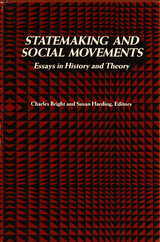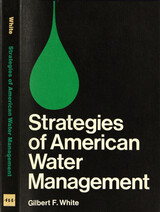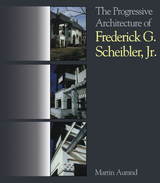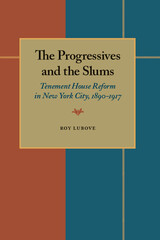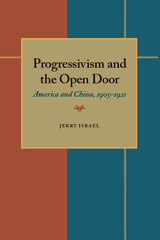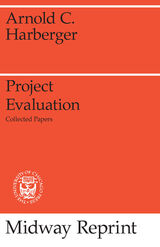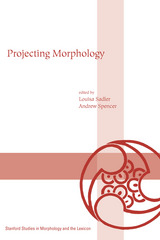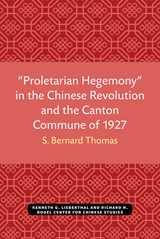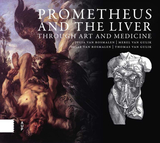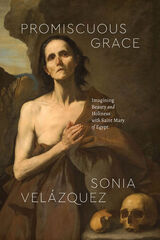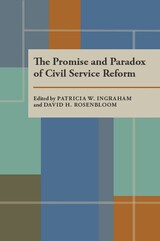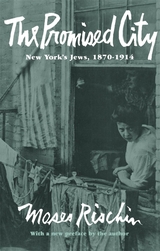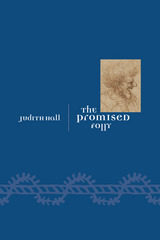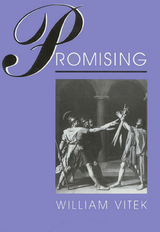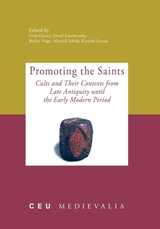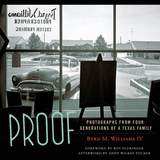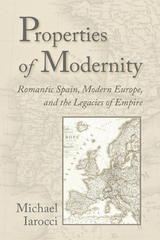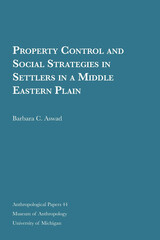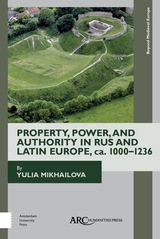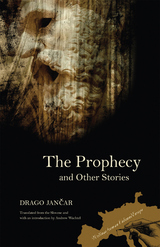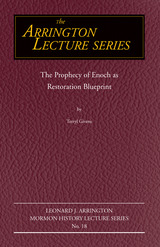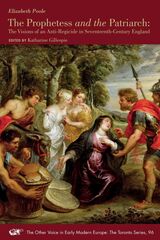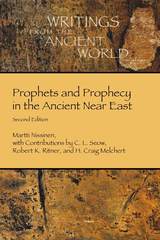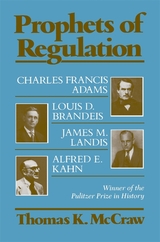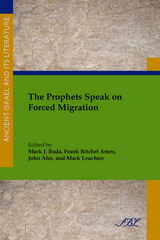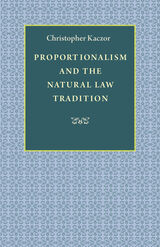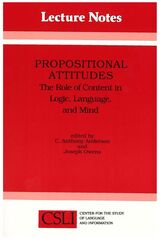 A Progress of Sentiments: Reflections on Hume’s Treatise
Annette C. Baier
Harvard University Press, 1991 Annette Baier’s aim is to make sense of David Hume’s Treatise as a whole. Hume’s family motto, which appears on his bookplate, was “True to the End.” Baier argues that it is not until the end of the Treatise that we get his full story about “truth and falsehood, reason and folly.” By the end, we can see the cause to which Hume has been true throughout the work.Baier finds Hume’s Treatise on Human Nature to be a carefully crafted literary and philosophical work which itself displays a philosophical progress of sentiments. His starting place is an overly abstract intellectualism that deliberately thrusts passions and social concerns into the background. In the three interrelated books of the Treatise, his “self-understander” proceeds through partial successes and dramatic failures to emerge with new-found optimism, expecting that the “exact knowledge” the morally self-conscious anatomist of human nature can acquire will itself improve and correct our vision of morality. Baier describes how, by turning philosophy toward human nature instead of toward God and the universe, Hume initiated a new philosophy, a broader discipline of reflection that can embrace Charles Darwin and Michel Foucault as well as William James and Sigmund Freud. Hume belongs both to our present and to our past.
The Progressive Architecture Of Frederick G. Scheibler, Jr
Martin Aurand
University of Pittsburgh Press, 1994 Frederick G. Scheibler, Jr. (1872–1958) was the rare turn-of-the-century American architect who looked to progressive movements such as Art Nouveau and Arts and Crafts for inspiration, rather than conventional styles. His fresh house designs and plans for apartment buildings and multifamily “group cottages” feature dramatic massing, rich detailing, and a wide variety of materials. Scheibler envisioned each building as a work of art, integrating architecture and ornamentation. Prized today, his best works are scattered throughout Pittsburgh’s East End and eastern suburbs.
This richly illustrated volume, the first comprehensive study of Scheibler, includes 125 historic and contemporary photographs and drawings, a catalogue raisonné of all of his known projects—including many not recorded in any other published source—a list of books in his library, and a selected bibliography.
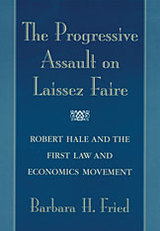 The Progressive Assault on Laissez Faire: Robert Hale and the First Law and Economics Movement
Barbara H. Fried
Harvard University Press, 1998 Law and economics is the leading intellectual movement in law today. This book examines the first great law and economics movement in the early part of the twentieth century through the work of one of its most original thinkers, Robert Hale. Beginning in the 1890s and continuing through the 1930s, progressive academics in law and economics mounted parallel assaults on free-market economic principles. They showed first that "private," unregulated economic relations were in fact determined by a state-imposed regime of property and contract rights. Second, they showed that the particular regime of rights that existed at that time was hard to square with any common-sense notions of social justice.
Today, Hale is best known among contemporary legal academics and philosophers for his groundbreaking writings on coercion and consent in market relations. The bulk of his writing, however, consisted of a critique of natural property rights. Taken together, these writings on coercion and property rights offer one of the most profound and elaborated critiques of libertarianism, far outshining the better-known efforts of Richard Ely and John R. Commons. In his writings on public utility regulation, Hale also made important contributions to a theory of just, market-based distribution.
This first, full-length study of Hale's work should be of interest to legal, economic, and intellectual historians.
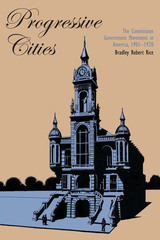 Progressive Cities: The Commission Government Movement in America, 1901–1920
By Bradley Robert Rice
University of Texas Press, 1977 Although the commission government movement is often treated by historians as an element of the reform surge of the Progressive Era, this is the first full-scale study of the origins, spread, and decline of the commission idea. Commission government originated in Galveston, Texas, where business leaders conceived the plan as a temporary measure to speed recovery from the great hurricane of 1900. Other cities in Texas and across the nation soon followed; by 1920, about 500 municipalities had adopted the plan in which elected representatives serve as heads of city departments and, collectively, as a policy-making body. Beginning with Galveston and Houston and Des Moines, Iowa, Bradley Robert Rice presents detailed case studies of the earliest commission cities and shows how the plan was developed and modified to suit each community’s needs. He goes on to chronicle the adoption of the commission plan by other cities across the country that strove for “businesslike efficiency” as a reaction against corruption and machine politics in urban government. Most commission charters included a wide-ranging package of municipal reforms, such as the short ballot, at-large representation, nonpartisanship, civil service, and direct legislation. Yet Rice shows that the commission plan generally offered little in the way of social reform to accompany its reorganization of municipal government. Applying a model of innovation diffusion, the author analyzes how and why the new form of city government spread across Progressive Era America. He also thoroughly explores the relationship between the commission plan and other Progressive Era reforms and reports on the reasons for its decline from both a social and a practical perspective. Progressive Cities is described by Professor Bruce M. Stave, editor of the Journal of Urban History, as “a sound piece of work which should make a useful and worthwhile contribution to the existing scholarship on urban reform and should appeal to an audience which cuts across disciplines: history, political science, urban studies and urban planning.”
 Progressive Constitutionalism: Reconstructing the Fourteenth Amemdment
Robin L. West
Duke University Press, 1994 The Fourteenth Amendment guarantees all citizens equal protection under the law as well as immunity from laws that deprive them of life, liberty, or property without due process of law. In Progressive Constitutionalism, Robin West develops an interpretation of this amendment that contrasts with the views, conservative and liberal, of the Rehnquist, Burger, and Warren Courts, and with the radical "antisubordinationist" account provided by the critical legal studies movement and many prominent feminist and critical race theorists. Her interpretation consists of a "substantive" argument regarding the Amendment’s core meaning, and a jurisprudential argument regarding the role of the courts and Congress in fulfilling the Amendment’s progressive promise.
West shows how the "equal protection" clause, far from insulating the private spheres of culture, market, and home life, as is commonly held, directly targets abuses of power within those spheres. She develops a number of arguments for the modern relevance of this understanding, from the failure of the state to provide equal protection against private domestic violence, permitting a "private sovereignty" of patriarchal power within the home, to the the state’s failure to provide equal protection against material deprivation, allowing "private sovereignty" between economically privileged and desperate people in private markets.
West’s argument extends to the "liberty" prong of the due process clause, seen here as a protection of the positive, not negative, liberty of citizens, covering rights in such typically controversial areas as welfare, education, and domestic safety. This interpretation recasts a number of contemporary constitutional issues, such as affirmative action and hate speech, and points to very different problems—notably private, unchecked criminal violence and extreme economic deprivation—as the central constitutional dilemmas of our day.
Progressive Constitutionalism urges a substantive, institutional, and jurisprudential reorientation of our understanding of the Fourteenth Amendment, one that would necessarily be pursued through Congressional rather than judicial channels. In doing so, with attention to history and both feminist and critical race scholarship, it should reinvigorate our politics and our constitutional conversations—and, perhaps, point us toward a more just society.
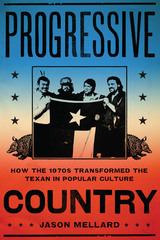 Progressive Country: How the 1970s Transformed the Texan in Popular Culture
By Jason Mellard
University of Texas Press, 2013 Winner, Coral Horton Tullis Memorial Prize, Texas State Historical Association, 2014 During the early 1970s, the nation’s turbulence was keenly reflected in Austin’s kaleidoscopic cultural movements, particularly in the city’s progressive country music scene. Capturing a pivotal chapter in American social history, Progressive Country maps the conflicted iconography of “the Texan” during the ’70s and its impact on the cultural politics of subsequent decades. This richly textured tour spans the notion of the “cosmic cowboy,” the intellectual history of University of Texas folklore and historiography programs, and the complicated political history of late-twentieth-century Texas. Jason Mellard analyzes the complex relationship between Anglo-Texan masculinity and regional and national identities, drawing on cultural studies, American studies, and political science to trace the implications and representations of the multi-faceted personas that shaped the face of powerful social justice movements. From the death of Lyndon Johnson to Willie Nelson’s picnics, from the United Farm Workers’ marches on Austin to the spectacle of Texas Chic on the streets of New York City, Texas mattered in these years not simply as a place, but as a repository of longstanding American myths and symbols at a historic moment in which that mythology was being deeply contested. Delivering a fresh take on the meaning and power of “the Texan” and its repercussions for American history, this detail-rich exploration reframes the implications of a populist moment that continues to inspire progressive change.
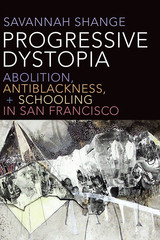 Progressive Dystopia: Abolition, Antiblackness, and Schooling in San Francisco
Savannah Shange
Duke University Press, 2019 San Francisco is the endgame of gentrification, where racialized displacement means that the Black population of the city hovers at just over 3 percent. The Robeson Justice Academy opened to serve the few remaining low-income neighborhoods of the city, with the mission of offering liberatory, social justice--themed education to youth of color. While it features a progressive curriculum including Frantz Fanon and Audre Lorde, the majority Latinx school also has the district's highest suspension rates for Black students. In Progressive Dystopia Savannah Shange explores the potential for reconciling the school's marginalization of Black students with its sincere pursuit of multiracial uplift and solidarity. Drawing on ethnographic fieldwork and six years of experience teaching at the school, Shange outlines how the school fails its students and the community because it operates within a space predicated on antiblackness. Seeing San Francisco as a social laboratory for how Black communities survive the end of their worlds, Shange argues for abolition over revolution or progressive reform as the needed path toward Black freedom.
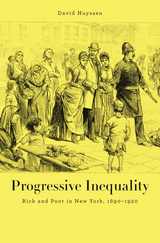 Progressive Inequality: Rich and Poor in New York, 1890–1920
David Huyssen
Harvard University Press, 2014 The Progressive Era has been depicted as a seismic event in American history—a landslide of reform that curbed capitalist excesses and reduced the gulf between rich and poor. Progressive Inequality cuts against the grain of this popular consensus, demonstrating how income inequality’s growth prior to the stock market crash of 1929 continued to aggravate class divisions. As David Huyssen makes clear, Progressive attempts to alleviate economic injustice often had the effect of entrenching class animosity, making it more, not less, acute.
Huyssen interweaves dramatic stories of wealthy and poor New Yorkers at the turn of the twentieth century, uncovering how initiatives in charity, labor struggles, and housing reform chafed against social, economic, and cultural differences. These cross-class actions took three main forms: prescription, in which the rich attempted to dictate the behavior of the poor; cooperation, in which mutual interest engendered good-faith collaboration; and conflict, in which sharply diverging interests produced escalating class violence. In cases where reform backfired, it reinforced a set of class biases that remain prevalent in America today, especially the notion that wealth derives from individual merit and poverty from lack of initiative.
A major contribution to the history of American capitalism, Progressive Inequality makes tangible the abstract dynamics of class relations by recovering the lived encounters between rich and poor—as allies, adversaries, or subjects to inculcate—and opens a rare window onto economic and social debates in our own time.
 Progressive Intellectuals and the Dilemmas of Democratic Commitment
Leon Fink
Harvard University Press, 1997 How to lead the people and be one of them? What's a democratic intellectual to do? This longstanding dilemma for the progressive intellectual, how to bridge the world of educated opinion and that of the working masses, is the focus of Leon Fink's penetrating book, the first social history of the progressive thinker caught in the middle of American political culture.
In a series of vivid portraits, Fink investigates the means and methods of intellectual activists in the first part of the twentieth century--how they served, observed, and made their own history. In the stories of, among others, John R. Commons, Charles McCarthy, William English Walling, Anna Strunsky Walling, A. Philip Randolph, W. Jett Lauck, and Wil Lou Gray, he creates a panorama of reform of unusual power. Issues as broad as the cult of leadership and as specific as the Wisconsin school of labor history lead us into the heart of the dilemma of the progressive intellectual in our age.
The problem, as Fink describes it, is twofold: Could people prevail in a land of burgeoning capitalism and concentrated power? And should the people prevail? This book shows us Socialists and Progressives and, later, New Dealers grappling with these questions as they tried to redress the new inequities of their day--and as they confronted the immense frustrations of moving the masses. Fink's graphic depiction of intellectuals' labors in the face of capitalist democracy's challenges dramatizes a time in our past--and at the same time speaks eloquently to our own.
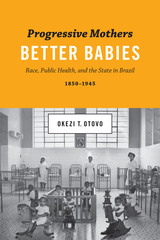 Progressive Mothers, Better Babies: Race, Public Health, and the State in Brazil, 1850-1945
By Okezi T. Otovo
University of Texas Press, 2016 In Bahia, Brazil, the decades following emancipation saw the rise of reformers who sought to reshape the citizenry by educating Bahian women in methods for raising “better babies.” The idealized Brazilian would be better equipped to contribute to the labor and organizational needs of a modern nation. Backed by many physicians, politicians, and intellectuals, the resulting welfare programs for mothers and children mirrored complex debates about Brazilian nationality. Examining the local and national contours of this movement, Progressive Mothers, Better Babies investigates families, medical institutions, state-building, and social stratification to trace the resulting policies, which gathered momentum in the aftermath of abolition (1888) and the declaration of the First Republic (1889), culminating during the administration of President Getúlio Vargas (1930–1945). Exploring the cultural discourses on race, gender, and poverty that permeated medical knowledge and the public health system for almost a century, Okezi T. Otovo draws on extensive archival research to reconstruct the implications for Bahia, where family patronage politics governed poor women’s labor as the mothers who were the focus of medical interventions were often the nannies and nursemaids of society’s wealthier families. The book reveals key transition points as the state of Bahia transformed from being a place where poor families could expect few social services to becoming the home of numerous programs targeting the poorest mothers and their children. Negotiating crucial questions of identity, this history sheds new light on larger debates about Brazil’s past and future.
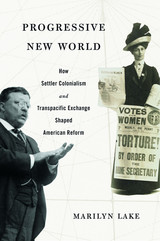 Progressive New World: How Settler Colonialism and Transpacific Exchange Shaped American Reform
Marilyn Lake
Harvard University Press, 2019 The paradox of progressivism continues to fascinate more than one hundred years on. Democratic but elitist, emancipatory but coercive, advanced and assimilationist, Progressivism was defined by its contradictions. In a bold new argument, Marilyn Lake points to the significance of turn-of-the-twentieth-century exchanges between American and Australasian reformers who shared racial sensibilities, along with a commitment to forging an ideal social order. Progressive New World demonstrates that race and reform were mutually supportive as Progressivism became the political logic of settler colonialism.
White settlers in the United States, who saw themselves as path-breakers and pioneers, were inspired by the state experiments of Australia and New Zealand that helped shape their commitment to an active state, women’s and workers’ rights, mothers’ pensions, and child welfare. Both settler societies defined themselves as New World, against Old World feudal and aristocratic societies and Indigenous peoples deemed backward and primitive.
In conversations, conferences, correspondence, and collaboration, transpacific networks were animated by a sense of racial kinship and investment in social justice. While “Asiatics” and “Blacks” would be excluded, segregated, or deported, Indians and Aborigines would be assimilated or absorbed. The political mobilizations of Indigenous progressives—in the Society of American Indians and the Australian Aborigines’ Progressive Association—testified to the power of Progressive thought but also to its repressive underpinnings. Burdened by the legacies of dispossession and displacement, Indigenous reformers sought recognition and redress in differently imagined new worlds and thus redefined the meaning of Progressivism itself.
Progressive Women in Conservative Times: Racial Justice, Peace, and Feminism
Susan Lynn
Rutgers University Press, 1992 Susan Lynn explores women's progressive social reform efforts in the 1940s and 1950s, an era when women activists promoted a postwar vision of a society based on an expanded welfare state, a powerful labor movement, a strong tradition of civil liberties, racial equality, and a peaceful international order. Lynn focuses on two organizations, the YWCA and the American Friends Service Committee, to explore this agenda.
The Progressives and the Slums: Tenement House Reform in New York City, 1890-1917
Roy Lubove
University of Pittsburgh Press, 1963 The Progressives and the Slums chronicles the reform of tenement housing, where some of the worst living conditions in the world existed. Roy Lubove focuses his study on New York City, detailing the methods, accomplishments, and limitations of housing reform at the turn of the twentieth century. The book is based in part on personal interviews with, and the unpublished writings of Lawrence Veiller, the dominant figure in housing reform between 1898 and 1920. Lubove views Veiller's role, surveys developments prior to 1890, and views housing reform within the broader context of progressive-era protest and reform.
Progressivism and the Open Door: America and China, 1905–1921
Jerry Israel
University of Pittsburgh Press, 1971 During the progressive era, most American policymakers agreed that China represented a land of unlimited opportunity for trade, investment and social reform. Serious divisions existed, however, over policy tactics. One side (mainly manufacturers and academics) advocated a unilateral policy of penetration allied only with Chinese modernizers. The other (primarily financiers and reformists), called for an alliance with other powers, especially Japan, in their dealings with China. In Progressivism and the Open Door, Jerry Israel examines the many factors that led to formal U.S. policy toward China during this era-one that ultimately found a middle ground between the two divisions.
 The Prohibition Era and Policing: A Legacy of Misregulation
Wesley M. Oliver
Vanderbilt University Press, 2018 Legal precedents created during Prohibition have lingered, leaving search-and-seizure law much better defined than limits on police use of force, interrogation practices, or eyewitness identification protocols. An unlawful trunk search is thus guarded against more thoroughly than an unnecessary shooting or a wrongful conviction.
Intrusive searches for alcohol during Prohibition destroyed middle-class Americans' faith in police and ushered in a new basis for controlling police conduct. State courts in the 1920s began to exclude perfectly reliable evidence obtained in an illegal search. Then, as Prohibition drew to a close, a presidential commission awakened the public to torture in interrogation rooms, prompting courts to exclude coerced confessions irrespective of whether the technique had produced a reliable statement.
Prohibition's scheme lingered long past the Roaring '20s. Racial tensions and police brutality were bigger concerns in the 1960s than illegal searches, yet when the Supreme Court imposed limits on officers' conduct in 1961, searches alone were regulated. Interrogation law during the 1960s, fundamentally reshaped by the Miranda ruling, ensured that suspects who invoked their rights would not be subject to coercive tactics, but did nothing to ensure reliable confessions by those who were questioned. Explicitly recognizing that its decisions excluding evidence had not been well-received, the Court in the 1970s refused to exclude identifications merely because they were made in suggestive lineups. Perhaps a larger project awaits—refocusing our rules of criminal procedure on those concerns from which Prohibition distracted us: conviction accuracy and the use of force by police.
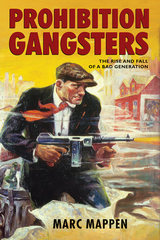 Prohibition Gangsters: The Rise and Fall of a Bad Generation
Mappen, Marc
Rutgers University Press, 2013 Master story teller Marc Mappen applies a generational perspective to the gangsters of the Prohibition era—men born in the quarter century span from 1880 to 1905—who came to power with the Eighteenth Amendment. On January 16, 1920, the Eighteenth Amendment to the Constitution went into effect in the United States, “outlawing the manufacture, sale, or transportation of intoxicating liquors.” A group of young criminals from immigrant backgrounds in cities around the nation stepped forward to disobey the law of the land in order to provide alcohol to thirsty Americans. Today the names of these young men—Al Capone, Lucky Luciano, Dutch Schultz, Legs Diamond, Nucky Johnson—are more familiar than ever, thanks in part to such cable programs as Boardwalk Empire. Here, Mappen strips way the many myths and legends from television and movies to describe the lives these gangsters lived and the battles they fought. Placing their criminal activities within the context of the issues facing the nation, from the Great Depression, government crackdowns, and politics to sexual morality, immigration, and ethnicity, he also recounts what befell this villainous group as the decades unwound. Making use of FBI and other government files, trial transcripts, and the latest scholarship, the book provides a lively narrative of shootouts, car chases, courtroom clashes, wire tapping, and rub-outs in the roaring 1920s, the Depression of the 1930s, and beyond. Mappen asserts that Prohibition changed organized crime in America. Although their activities were mercenary and violent, and they often sought to kill one another, the Prohibition generation built partnerships, assigned territories, and negotiated treaties, however short lived. They were able to transform the loosely associated gangs of the pre-Prohibition era into sophisticated, complex syndicates. In doing so, they inspired an enduring icon—the gangster—in American popular culture and demonstrated the nation’s ideals of innovation and initiative. View a three minute video of Marc Mappen speaking about Prohibition Gangsters.
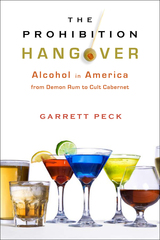 The Prohibition Hangover: Alcohol in America from Demon Rum to Cult Cabernet
Peck, Garrett
Rutgers University Press, 2009 Spirits are all the rage today. Two-thirds of Americans drink, whether they enjoy higher priced call brands or more moderately priced favorites. From fine dining and piano bars to baseball games and backyard barbeques, drinks are part of every social occasion. In The Prohibition Hangover, Garrett Peck explores the often-contradictory social history of alcohol in America, from the end of Prohibition in 1933 to the twenty-first century. For Peck, Repeal left American society wondering whether alcohol was a consumer product or a controlled substance, an accepted staple of social culture or a danger to society. Today the legal drinking age, binge drinking, the neo-prohibitionist movement led by Mothers Against Drunk Driving, the 2005 Supreme Court decision in Granholm v. Heald that rejected discriminatory curbs on wine sales, the health benefits of red wine, advertising, and other issues remain highly contested. Based on primary research, including hundreds of interviews with those on all sides, clergy, bar and restaurant owners, public health advocates, citizen crusaders, industry representatives, and more, as well as secondary sources, The Prohibition Hangover provides a panoramic assessment of alcohol in American culture. Traveling through the California wine country, the beer barrel backroads of New England and Pennsylvania, and the blue hills of Kentucky's bourbon trail, Peck places the concerns surrounding alcohol use within the broader context of American history, religious traditions, and governance. Society is constantly evolving, and so are our drinking habits. Cutting through the froth and discarding the maraschino cherries, The Prohibition Hangover examines the modern American temperament toward drink amid the $189-billion-dollar-a-year industry that defines itself by the production, distribution, marketing, and consumption of alcoholic beverages.
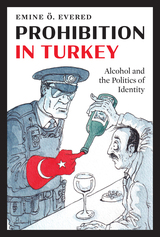 Prohibition in Turkey: Alcohol and the Politics of Identity
Emine Ö. Evered
University of Texas Press, 2024 A social history of alcohol, identity, secularism, and modernization from the late Ottoman and early Turkish republican eras to the present day. Prohibition in Turkey investigates the history of alcohol, its consumption, and its proscription as a means to better understand events and agendas of the late Ottoman and early Turkish republican eras. Through a comprehensive examination of archival, literary, popular culture, media, and other sources, it unveils a traditionally overlooked—and even excluded—aspect of human history in a region that many do not associate with intoxicants, inebriation, addiction, and vigorous wet-dry debates. Historian Emine Ö. Evered’s account uniquely chronicles how the Turko-Islamic Ottoman Empire developed strategies for managing its heterogeneous communities and their varied rights to produce, market, and consume alcohol, or to simply abstain. The first author to reveal this experience’s connections with American Prohibition, she demonstrates how—amid modernization, sectarianism, and imperial decline—drinking practices reflected, shifted, and even prompted many of the changes that were underway and that hastened the empire’s collapse. Ultimately, Evered’s book reveals how Turkey’s alcohol question never went away but repeatedly returns in the present, in matters of popular memory, public space, and political contestation.
 "Prohibition Is Here to Stay": The Reverend Edward S. Shumaker and the Dry Crusade in America
Jason S. Lantzer
University of Notre Dame Press, 2009
“Prohibition Is Here to Stay” focuses on the Reverend Edward S. Shumaker, a Methodist minister who for nearly twenty-five years led Indiana's influential chapter of the Anti Saloon League. Shumaker was one of the most powerful men in Indiana in the fight against demon rum, and his influence extended well beyond the boundaries of the state during the late nineteenth and early twentieth centuries. Jason Lantzer uses Shumaker's life and work to shed new light on the rise and fall of Prohibition and to better understand and appreciate the interplay of religion and politics in American culture.
Drawing on Shumaker's personal papers as well as archival work, Lantzer argues that understanding the role of religious faith and in particular evangelical Protestantism is essential to understanding Prohibition. Shumaker's religious faith inspired his crusade against alcohol and his efforts to make the Indiana Anti Saloon League one of the strongest political pressure groups in the country. Lantzer argues that Edward Shumaker's life and the cause to which he devoted most of it were not aberrations but exemplars of central currents in American culture of the time. Lantzer also connects Shumaker and the prohibition movement in Indiana to larger issues of America's transition from a predominantly rural society to an urban culture, with the attendant fears of change, loss of values, the impact of industrialization, and foreign immigration.
“Jason Lantzer's excellent biography of Edward Shumaker places one of America's most successful Prohibition crusaders in the very center of American religion and reform. Lantzer's careful research and thoughtful analysis sharply contradicts the tendency to see Prohibition as a mere sidebar to American history and opens our minds to the connections between political activism and religious faith.” —James H. Madison, author of Slinging Doughnuts for the Boys: An American Woman in World War II
“Given Lantzer’s access to Edward Shumaker’s personal papers, his narrative of Shumaker’s life is undoubtedly an authoritative one. In addition, the book increases our understanding of the organizational dynamics of the Indiana prohibition movement, the Indiana Anti-Saloon League (IASL)’s political endeavors, and the IASL’s relationship with African Americans, Catholics, and the Ku Klux Klan.” —Ann-Marie Szymanski, University of Oklahoma
“In this sympathetic, serious account of Reverend Edward Shumaker and the Indiana prohibition movement, Jason Lantzer brings to life an earlier, formative phase in what Americans have ruefully come to call the ‘culture wars,’ in which ethnic, religious, and cultural divisions within communities can give rise to and perpetuate rancorous conflicts over standards and behavior. While that story is important enough, Lantzer also evokes the atmosphere and life of Indiana's cities and small towns as the Midwest struggled with the powerful, sometimes frightening forces of urbanization, industrialization, and immigration. Lantzer's book is worth reading because of its imaginative re-creation of the social and intellectual environment out of which evangelical, moral reform efforts such as Shumaker's prohibitionism grew.” —Alan Lessoff, editor of the Journal of the Gilded Age and Progressive Era
“Based on newly opened manuscripts and impressive research in local sources, this study of Edward Shumaker sheds new light on the workings of a state Anti-Saloon League, its leader, and state and national politics and public policy. Shumaker was an important figure in the Prohibition faction that was unbending in its commitment to strict law enforcement and the prevention of drinking.” —K. Austin Kerr, Ohio State University
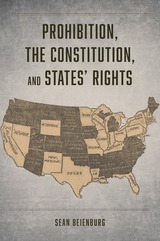 Prohibition, the Constitution, and States' Rights
Sean Beienburg
University of Chicago Press, 2019 Colorado’s legalization of marijuana spurred intense debate about the extent to which the Constitution preempts state-enacted laws and statutes. Colorado’s legal cannabis program generated a strange scenario in which many politicians, including many who freely invoke the Tenth Amendment, seemed to be attacking the progressive state for asserting states’ rights. Unusual as this may seem, this has happened before—in the early part of the twentieth century, as America concluded a decades-long struggle over the suppression of alcohol during Prohibition.
Sean Beienburg recovers a largely forgotten constitutional debate, revealing how Prohibition became a battlefield on which skirmishes of American political development, including the debate over federalism and states’ rights, were fought. Beienburg focuses on the massive extension of federal authority involved in Prohibition and the passage of the Eighteenth Amendment, describing the roles and reactions of not just Congress, the presidents, and the Supreme Court but political actors throughout the states, who jockeyed with one another to claim fidelity to the Tenth Amendment while reviling nationalism and nullification alike. The most comprehensive treatment of the constitutional debate over Prohibition to date, the book concludes with a discussion of the parallels and differences between Prohibition in the 1920s and debates about the legalization of marijuana today.
 Project 258: Making Dinner at Fish & Game
By Zakary Pelaccio and Peter Barrett
University of Texas Press, 2017 Fish & Game restaurant in Hudson, New York, is a leader in the local foods movement. Its core approach—engaging intimately with nature both wild and domestic, building relationships with farmers, and exploring the joys of fermentation—is one of interest to anyone, anywhere, who yearns to cook and eat better food. Established in 2013, Fish & Game, with its chef/owner Zakary Pelaccio and his co-chefs and partners Kevin Pomplun and Jori Jayne Emde, is already receiving national accolades and honors, including the 2016 James Beard Award for Best Chef: Northeast; 2015 James Beard Award finalist for Outstanding Restaurant Design; 2015 & 2016 Wine Enthusiast: America’s 100 Best Wine Restaurants; and 2014 James Beard Award semifinalist for Best New Restaurant. Project 258: Making Dinner at Fish & Game presents an enticing selection of seasonal recipes, profiles of key producers who supply the restaurant, and a fascinating, beautifully illustrated look at the processes—both intellectual and culinary—behind the food at Fish & Game. Taking no shortcuts, Pelaccio and his staff handcraft many staple ingredients, including fish sauce, vinegars, maple syrup, and prosciutto. He explains how the methods and techniques practiced at Fish & Game can be applied to the food that grows wherever you live. If you ever wonder “what does this place taste like?,” let Project 258 be your guide and inspiration for locally based food sourcing and eating.
 Project 9: The Birth of the Air Commandos in World War II
Dennis R. Okerstrom
University of Missouri Press, 2014 Project 9: The Birth of the Air Commandos in World War II is a thoroughly researched narrative of the Allied joint project to invade Burma by air. Beginning with its inception at the Quebec Conference of 1943 and continuing through Operation Thursday until the death of the brilliant British General Orde Wingate in March 1944, less than a month after the successful invasion of Burma, Project 9 details all aspects of this covert mission, including the selection of the American airmen, the procurement of the aircraft, the joint training with British troops, and the dangerous night-time assault behind Japanese lines by glider. Based on review of hundreds of documents as well as interviews with surviving Air Commandos, this is the history of a colorful, autonomous, and highly effective military unit that included some of the most recognizable names of the era. Tasked by the General of the Army Air Forces, H. H. “Hap” Arnold, to provide air support for British troops under the eccentric Major General Wingate as they operated behind Japanese lines in Burma, the Air Commandos were breaking entirely new ground in operational theory, tactics, and inter-Allied cooperation. Okerstrom’s in-depth research and analysis in Project 9 shed light on the operations of America’s first foray into special military operations, when these heroes led the way for the formation of modern special operations teams such as Delta Force and Seal Team Six.
Project Evaluation: Collected Papers
Arnold C. Harberger
University of Chicago Press, 1976 These essays by the distinguished economist Arnold C. Harberger cover the theory of project evaluation and its applications, with emphasis on public-sector investments designed to promote economic development.
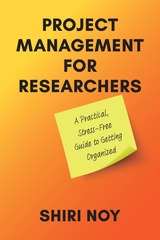 Project Management for Researchers: A Practical, Stress-Free Guide to Getting Organized
Shiri Noy
University of Michigan Press, 2024 Learning how to organize and manage research is important for both the researcher and for advancing research. However, graduate students are often trained in theories, methods, and disciplines, but rarely in the organizational, administrative, and metacognitive skills required to manage research projects. Moreover, several disciplines are decrying a reproducibility crisis, with a concerted academic push toward open-access approaches. By clearly organizing research, graduate students and researchers can ensure that they are able to account for their methodological, theoretical, and other research decisions: to reviewers, to funding agencies, and to support the development of new ideas and exciting offshoots of projects.
Project Management for Researchers tackles the how, what, and why of project management. It offers step-by-step guidance on choosing tools and developing a personalized system that will help the reader manage and organize their research so that steps and decisions are documented for accountability and reproducibility. Readers will find worksheets they can adapt to their own needs, priorities, and research as well as practical tips on issues ranging from emails to scheduling. Suitable for work across methods, experience levels, and disciplines and adaptable for those working alone, with others, or as team managers, this book will guide readers between various research stages–from planning, to execution, to adjustment of research projects big and small.
 Project Planning and Management for Ecological Restoration
John Rieger, John Stanley, and Ray Traynor
Island Press, 2014 As ecological restoration becomes central to climate resilience and global conservation efforts, the need for effective, well-managed projects has never been greater. Project Planning and Management for Ecological Restoration offers a clear, field-tested framework to help practitioners—from professionals to volunteers—navigate complex restoration work with greater confidence and success.
Drawing from decades of experience, John Rieger, John Stanley, and Ray Traynor lay out a practical, four-phase process: planning, design, implementation, and aftercare. Their approach integrates insights from landscape ecology, hydrology, soil science, and wildlife biology, translating them into actionable steps that can be adapted to diverse ecosystems and project goals.
Designed to prevent common missteps and improve outcomes, the book includes checklists, tables, and illustrations to guide readers through each phase of a project—from identifying restoration targets and setting timelines to long-term monitoring and adaptive management. Case examples reflect real-world challenges, emphasizing flexibility, collaboration, and scientific grounding.
This guide equips land stewards, conservation professionals, and community leaders with the tools to carry out restoration projects that are both ecologically sound and socially meaningful. It brings structure to a process that often feels overwhelming—and helps ensure that restoration efforts result in lasting, measurable change on the ground.
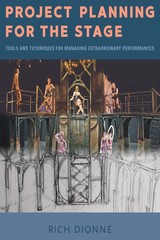 Project Planning for the Stage: Tools and Techniques for Managing Extraordinary Performances
Rich Dionne
Southern Illinois University Press, 2018 Author Rich Dionne reframes theatre production as a project and provides essential tools for understanding and managing it efficiently, whether it be a stage play, an opera, a dance piece, or other performance that requires the collaboration of the artists and artisans creating the visual and aural landscape for it.
Project Planning for the Stage is organized into four sections corresponding to the life cycle of a theatre production: defining the goals and scope of the production and assembling the crew; planning, estimating, and scheduling; executing and managing; and closing and strike. Each section focuses on relevant concepts and skills and outlines the application of effective project-planning procedures and techniques—including critical path analysis and Gantt charts.
This book will be a valuable addition to the libraries of technical managers in live entertainment. Technical directors, costume shop managers, master electricians, properties masters, and video supervisors—anyone managing even part of a production—need to understand project-planning concepts such as the boundaries of authority and responsibility, parametric and bottom-up estimates, and precedence diagrams. The incredibly useful and powerful tools outlined in this book allow any technical manager to deliver the best possible outcome for a production.
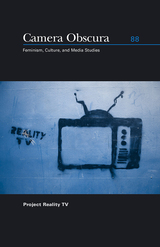 Project Reality TV
Lynne Joyrich, Misha Kavka, and Brenda R. Weber, special issue editors
Duke University Press This special issue examines reality television, analyzing how it produces certain ways of seeing, knowing, feeling, and being for viewers and society. The essays explore common reality television themes—health, housewives, “hot bodies,” and “hoochie mamas”—and programs including Jersey Shore, the Real Housewives, and Intervention in relation to gender, sexuality, race, and class. The contributors consider reality television’s industrial and affective economies, its constructions of celebrity and sociality, its ethics and epistemologies, and its implications for viewers and our culture. Unpacking a significant media phenomenon of the era, this issue allows readers to better understand and productively engage with today’s mediatized culture.
Lynne Joyrich is Professor of Modern Culture and Media at Brown University. She is the author of Re-viewing Reception: Television, Gender, and Postmodern Culture. She has been a member of the Camera Obscura editorial collective since 1996. Misha Kavka is Associate Professor of Media, Film, and Television at the University of Auckland. She is the author of Reality TV and Reality Television, Affect and Intimacy: Reality Matters and is the coeditor of Feminist Consequences: Theory for the New Century. Brenda R. Weber is Associate Professor of Gender Studies at Indiana University. Her books include Makeover TV: Selfhood, Citizenship, and Celebrity and Reality Gendervision: Sexuality and Gender on Transatlantic Reality TV, both also published by Duke University Press, and Women and Literary Celebrity in the Nineteenth Century: The Transatlantic Production of Fame and Gender.
Contributors: Pier Dominguez, Jane Feuer, Hunter Hargraves, Jennifer Jones, Lynne Joyrich, Misha Kavka, Michael Litwack, Kristen J. Warner, Brenda R. Weber
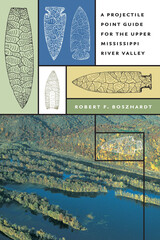 A Projectile Point Guide for the Upper Mississippi River Valley
Robert F. Boszhardt
University of Iowa Press, 2003 The most common relics of the 12,000-year occupancy of the Upper Mississippi River Valley may be the chipped stone projectile points that Native Americans fastened to the ends of their spears, darts, and arrow shafts. This useful guide provides a key to identifying the various styles of points found along the Upper Mississippi River in the Driftless region stretching roughly from Dubuque, Iowa, to Red Wing, Minnesota, but framed within a somewhat larger area extending from the Rock Island Rapids at the modern Moline-Rock Island area to the Falls of St. Anthony at Minneapolis-St. Paul. Logging tens of thousands of miles and visiting private collectors from all walks of life since 1982, Robert Boszhardt has documented thousands of projectile points found in this region. In addition to drawings of each style, he provides other accepted names as well as names of related points, age, distribution, a description (including length and width), material, and references for each type. The guide is meant for the many avocational archaeologists who collect projectile points in the Upper Midwest and will be a useful reference tool for professional field archaeologists as well. Emphasizing the preservation of sites as well as a mutual exchange of information between professional and avocational archaeologists, this guide will reveal projectile points as clues to the past, time markers which embody crucial information about the cultures of the Mississippi River Valley's early inhabitants.
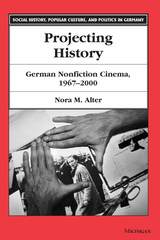 Projecting History: German Nonfiction Cinema, 1967-2000
Nora M. Alter
University of Michigan Press, 2002 Between 1967 and 2000, film production in Germany underwent a number of significant transformations, including the birth and death of New German Cinema as well as the emergence of a new transnational cinematic practice. In Projecting History, Nora M. Alter explores the relationship between German cinematic practice and the student protests in both East and West Germany against the backdrop of the U.S. war in Vietnam in the sixties, the outbreak of terrorism in West Germany in the seventies, West Germany's rise as a significant global power in the eighties, and German reunification in the nineties. Although a central tendency of New German Cinema in the 1970s was to reduce the nation's history to the product of individuals, the films addressed in Projecting History focus not on individual protagonists, but on complex socioeconomic structures. The films, by Rainer Werner Fassbinder, Harun Farocki, Alexander Kluge, Ulrike Ottinger, Wim Wenders and others, address basic problems of German history, including its overall "peculiarity" within the European context, and, in particular, the specific ways in which the National Socialist legacy continues to haunt Germans. Nora M. Alter is Associate Professor of German, Film and Media Studies, and Women and Gender Studies at the University of Florida. A specialist in twentieth-century film, comparative literature, and cultural studies, Alter has been the recipient of a National Endowment for the Humanities Fellowship and a Howard Foundation Fellowship. She is also the author of Vietnam Protest Theatre: The Television War on Stage.
Projecting Morphology
Edited by Louisa Sadler and Andrew Spencer
CSLI, 2003 The separation of syntax and morphology is a major principle in contemporary lexicalist theories. The syntactic theory of Lexical-Functional Grammar recognizes this separation on a structural level but argues that both are equal, interacting, and competing contributors in a functional setting. This book discusses the relationship between morphology and LFG, reintroducing two seminal papers on the theory's impact on morphology and presenting new material on current morphological issues, including the nature of morphosyntactic paradigms and the role of optimality theory.
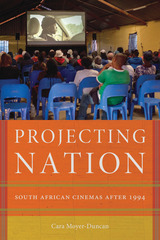 Projecting Nation: South African Cinemas after 1994
Cara Moyer-Duncan
Michigan State University Press, 2020 In 1994, not long after South Africa made its historic transition to multiracial democracy, the nation’s first black-majority government determined that film had the potential to promote social cohesion, stimulate economic development, and create jobs. In 1999 the new National Film and Video Foundation was charged with fostering a vibrant, socially engaged, and self-sufficient film industry. What are the results of this effort to create a truly national cinematic enterprise? Projecting Nation: South African Cinemas after 1994 answers that question by examining the ways in which national and transnational forces have shaped the representation of race and nation in feature-length narrative fiction films. Offering a systematic analysis of cinematic texts in the context of the South African film industry, author Cara Moyer-Duncan analyzes both well-known works like District 9 (2009) and neglected or understudied films like My Shit Father and My Lotto Ticket (2008) to show how the ways filmmakers produce cinema and the ways diverse audiences experience it—whether they watch major releases in theaters in predominantly white suburban enclaves or straight-to-DVD productions in their own homes—are informed by South Africans’ multiple experiences of nation in a globalizing world.
 Projecting the Nation: History and Ideology on the Israeli Screen
Eran Kaplan
Rutgers University Press, 2020 Projecting the Nation: History and Ideology on the Israeli Screen is a wide-ranging history of over seven decades of Israeli cinema. The only book in English to offer this type of historical scope was Ella Shohat’s Israeli Cinema: East West and the Politics of Representation from 1989. Since 1989, however, Israeli cinema and Israeli society have undergone some crucial transformations and, moreover, Shohat’s book offered a single framework through which to judge Israeli cinema: a critique of orientalism. Projecting the Nation contends that Israeli cinema offers much richer historical and ideological perspectives that expose the complexity of the Israeli project. By analyzing Israeli films which address such issues as the Arab-Israeli conflict, the Ashkenazi-Mizrahi divide, the kibbutz and urban life, the rise of religion in Israeli public life and more, the book explores the way cinema has represented and also shaped our understanding of the history of modern Israel as it evolved from a collectivist society to a society where individualism and adherence to local identities is the dominant ideology.
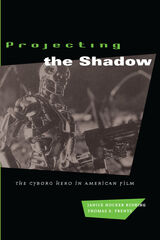 Projecting the Shadow: The Cyborg Hero in American Film
Janice Hocker Rushing and Thomas S. Frentz
University of Chicago Press, 1995 Part human, part machine, the cyborg is the hero of an increasingly popular genre of American film and, as Janice H. Rushing and Thomas S. Frentz so provocatively suggest, a cultural icon emblematic of an emergent postmodern mythology. Using the cyborg film as a point of departure, Rushing and Frentz examine how we rework Western myths and initiation rites in the face of new technologies.
Through in-depth examinations of six representative films—Jaws, The Deer Hunter, The Manchurian Candidate, Blade Runner, The Terminator, and Terminator 2—Rushing and Frentz track the narrative's thread from the hunter to his technological nemesis, demonstrating how each film represents an unfolding hunter myth.
For each movie, Rushing and Frentz show how uninitiated male hunters slowly lose control over their weapons. In Jaws, a 'soft' man, dominated by technology, can re-acquire the heroic hunter qualities he needs by teaming up with a 'savage' man and a 'technological' man. In doing so, he can still conquer the prey. The Manchurian Candidate charts how technology can turn a human into a weapon; Blade Runner perfects the artificial human with its manufactured replicants who are "more than human"; and The Terminator introduces a female hunter who leads humanity in its struggle against technology.
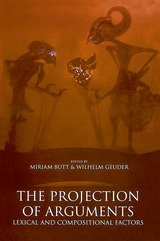 The Projection of Arguments: Lexical and Compositional Factors
Edited by Miriam Butt and Wilhelm Geuder
CSLI, 1998 It is becoming increasingly clear that the standard approach to argument linking in terms of "thematic roles", which are determined by the lexical meaning of verbs, has some serious shortcomings. This volume sets out to explore alternatives to a rigid model of lexical projection. It brings together a set of papers from different backgrounds that converge on the general hypothesis that the many semantic factors which influence the projection of arguments should be attributed to compositional processes rather than to the fixed contents of lexical entries. Proposals for a reassessment of the lexicon-syntax interface include flexible models of lexical meaning with productive derivation of alternants, as well as models where the structural context supplants much of the putative role of lexical entries. The topics addressed include questions of argument hierarchies and adicity of predicates, and the syntax and semantics of argument alternations in a set of very diverse languages, which include English, Dutch, Scottish Gaelic, Finnish, Hebrew, Kannada, Malay, Inuit, and Yaqui.
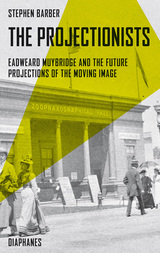 The Projectionists: Eadweard Muybridge and the Future Projections of the Moving Image
Stephen Barber
Diaphanes, 2020 Eadweard Muybridge is among the seminal originators of the contemporary world’s visual form. Projectionists examines mostly unknown aspects of Muybridge’s work: his period as a touring projectionist who enthralled audiences with unprecedented moving-images and his creation of a moving-image auditorium—long before cinemas—in which to project his work at the 1893 World’s Columbian Exposition. That auditorium was both a catastrophe and a vital precursor for the following century’s manias for projection. Based on new research into his travels, audiences, auditoria, and projectors, Projectionists explores Muybridge’s initiating role in moving-image projection and also maps his driving inspiration for subsequent filmmakers preoccupied with the volatile entity of projection, from 1890s Berlin to contemporary Japan, via further World’s Exposition events and cinemas’ overheated projection-boxes.
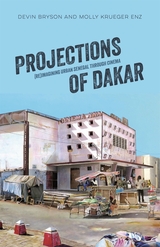 Projections of Dakar: (Re)Imagining Urban Senegal through Cinema
Devin Bryson and Molly Krueger Enz
Ohio University Press, 2024 Projections of Dakar studies the audiovisual creations and practices of twenty-first-century Senegalese filmmakers living, working, and distributing their films in urban Senegal. Although some observers have described contemporary Senegalese cinema as a dying industry, this book shows that it retains great potential. Senegalese cinematic practitioners are forging unique, dynamic responses to social challenges and producing content in innovative forms.
Like contemporary Senegalese cinema, African urban centers are often perceived as sites of despair and social decay. In each chapter of this book, Devin Bryson and Molly Krueger Enz focus on a particular urban issue and analyze how Senegalese filmmakers document and reimagine it from diverse perspectives and contexts. The authors draw from interviews and ethnographic observations to center filmmakers’ practices and conceptualizations of contemporary cinema in Dakar. Bryson and Enz trace developments in production, distribution, viewership, and audience response since 2012 to study how these films and their production both reveal and contribute to how people live in the city, relate to one another, build their lives, advocate for change, find joy and meaning, and build community. They also document and articulate more equitable and inclusive forms of these activities. Ultimately, the book illustrates how Senegalese filmmakers reimagine Africa as a place that will lead to a better future for its inhabitants.
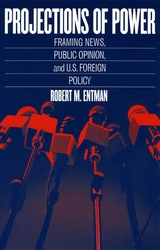 Projections of Power: Framing News, Public Opinion, and U.S. Foreign Policy
Robert M. Entman
University of Chicago Press, 2003 To succeed in foreign policy, U.S. presidents have to sell their versions or framings of political events to the news media and to the public. But since the end of the Cold War, journalists have increasingly resisted presidential views, even offering their own spin on events. What, then, determines whether the media will accept or reject the White House perspective? And what consequences does this new media environment have for policymaking and public opinion?
To answer these questions, Robert M. Entman develops a powerful new model of how media framing works—a model that allows him to explain why the media cheered American victories over small-time dictators in Grenada and Panama but barely noticed the success of far more difficult missions in Haiti and Kosovo. Discussing the practical implications of his model, Entman also suggests ways to more effectively encourage the exchange of ideas between the government and the media and between the media and the public. His book will be an essential guide for political scientists, students of the media, and anyone interested in the increasingly influential role of the media in foreign policy.
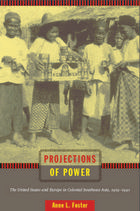 Projections of Power: The United States and Europe in Colonial Southeast Asia, 1919-1941
Anne L. Foster
Duke University Press, 2010 Throughout its history, the United States has been both imperialistic and anticolonial: imperialistic in its expansion across the continent and across oceans to colonies such as the Philippines, and anticolonial in its rhetoric and ideology. How did this contradiction shape its interactions with European colonists and Southeast Asians after the United States joined the ranks of colonial powers in 1898? Anne L. Foster argues that the actions of the United States functioned primarily to uphold, and even strengthen, the colonial order in Southeast Asia. The United States participated in international agreements to track and suppress the region’s communists and radical nationalists, and in economic agreements benefiting the colonial powers. Yet the American presence did not always serve colonial ends; American cultural products (including movies and consumer goods) and its economic practices (such as encouraging indigenous entrepreneurship) were appropriated by Southeast Asians for their own purposes. Scholars have rarely explored the interactions among the European colonies of Southeast Asia in the early twentieth century. Foster is the first to incorporate the United States into such an analysis. As she demonstrates, the presence of the United States as a colonial power in Southeast Asia after the First World War helps to explain the resiliency of colonialism in the region. It also highlights the inexorable and appealing changes that Southeast Asians perceived as possibilities for the region’s future.
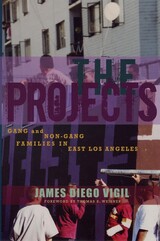 The Projects: Gang and Non-Gang Families in East Los Angeles
By James Diego Vigil
University of Texas Press, 2007 2008 — ALLA Prize for Best Book on Latina/o Anthropology The Pico Gardens housing development in East Los Angeles has a high percentage of resident families with a history of persistent poverty, gang involvement, and crime. In some families, members of three generations have belonged to gangs. Many other Pico Gardens families, however, have managed to avoid the cycle of gang involvement. In this work, Vigil adds to the tradition of poverty research and elaborates on the association of family dynamics and gang membership. The main objective of his research was to discover what factors make some families more vulnerable to gang membership, and why gang resistance was evidenced in similarly situated non-gang-involved families. Providing rich, in-depth interviews and observations, Vigil examines the wide variations in income and social capital that exist among the ostensibly poor, mostly Mexican American residents. Vigil documents how families connect and interact with social agencies in greater East Los Angeles to help chart the routines and rhythms of the lives of public housing residents. He presents family life histories to augment and provide texture to the quantitative information. By studying life in Pico Gardens, Vigil feels we can better understand how human agency interacts with structural factors to produce the reality that families living in all public housing developments must contend with daily.
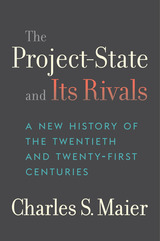 The Project-State and Its Rivals: A New History of the Twentieth and Twenty-First Centuries
Charles S. Maier
Harvard University Press, 2023 A new and original history of the forces that shaped the twentieth and twenty-first centuries.
We thought we knew the story of the twentieth century. For many in the West, after the two world conflicts and the long cold war, the verdict was clear: democratic values had prevailed over dictatorship. But if the twentieth century meant the triumph of liberalism, as many intellectuals proclaimed, why have the era’s darker impulses—ethnic nationalism, racist violence, and populist authoritarianism—revived?
The Project-State and Its Rivals offers a radical alternative interpretation that takes us from the transforming challenges of the world wars to our own time. Instead of the traditional narrative of domestic politics and international relations, Charles S. Maier looks to the political and economic impulses that propelled societies through a century when territorial states and transnational forces both claimed power, engaging sometimes as rivals and sometimes as allies. Maier focuses on recurring institutional constellations: project-states including both democracies and dictatorships that sought not just to retain power but to transform their societies; new forms of imperial domination; global networks of finance; and the international associations, foundations, and NGOs that tried to shape public life through allegedly apolitical appeals to science and ethics.
In this account, which draws on the author’s studies over half a century, Maier invites a rethinking of the long twentieth century. His history of state entanglements with capital, the decline of public projects, and the fragility of governance explains the fraying of our own civic culture—but also allows hope for its recovery.
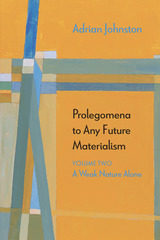 Prolegomena to Any Future Materialism: A Weak Nature Alone
Adrian Johnston
Northwestern University Press, 2019 Adrian Johnston’s trilogy Prolegomena to Any Future Materialism aims to forge a thoroughly materialist yet antireductive theory of subjectivity. In this second volume, A Weak Nature Alone, Johnston focuses on the philosophy of nature required for such a theory. This volume is guided by a fundamental question: How must nature be rethought so that human minds and freedom do not appear to be either impossible or inexplicable within it? Asked differently: How must the natural world itself be structured such that sapient subjects in all their distinctive peculiarities emerged from and continue to exist within this world? In A Weak Nature Alone, Johnston develops his transcendental materialist account of nature through engaging with and weaving together five main sources of inspiration: Hegelian philosophy, Marxist materialism, Freudian-Lacanian metapsychology, Anglo-American analytic neo-Hegelianism, and evolutionary theory and neurobiology. Johnston argues that these seemingly (but not really) strange bedfellows should be brought together so as to construct a contemporary ontology of nature. Through this ontology, nonnatural human subjects can be seen to arise in an immanent, bottom-up fashion from nature itself.
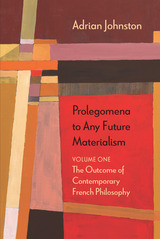 Prolegomena to Any Future Materialism: The Outcome of Contemporary French Philosophy
Adrian Johnston
Northwestern University Press, 2013 Adrian Johnston’s Prolegomena to Any Future Materialism,planned for three volumes, will lay the foundations for a new materialist theoretical apparatus, his “transcendental materialism.” In this first volume, Johnston clears an opening within contemporary philosophy and theory for his unique position. He engages closely with Lacan, Badiou, and Meillassoux, demonstrating how each of these philosophers can be seen as failing to forge an authentically atheistic materialism. Johnston builds a new materialism both profoundly influenced by these brilliant comrades of a shared cause as well as making up for the shortcomings of their own creative attempts to bring to realization the Lacanian vision of an Other-less, One-less ontology. The Outcome of Contemporary French Philosophy yields intellectual weapons suitable for deployment on multiple fronts simultaneously, effective against the mutually entangled spiritualist and scientistic foes of our post-Enlightenment, biopolitical era of nothing more than commodities and currencies.
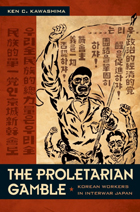 The Proletarian Gamble: Korean Workers in Interwar Japan
Ken C. Kawashima
Duke University Press, 2009 Koreans constituted the largest colonial labor force in imperial Japan during the 1920s and 1930s. Caught between the Scylla of agricultural destitution in Korea and the Charybdis of industrial depression in Japan, migrant Korean peasants arrived on Japanese soil amid extreme instability in the labor and housing markets. In The Proletarian Gamble, Ken C. Kawashima maintains that contingent labor is a defining characteristic of capitalist commodity economies. He scrutinizes how the labor power of Korean workers in Japan was commodified, and how these workers both fought against the racist and contingent conditions of exchange and combated institutionalized racism. Kawashima draws on previously unseen archival materials from interwar Japan as he describes how Korean migrants struggled against various recruitment practices, unfair and discriminatory wages, sudden firings, racist housing practices, and excessive bureaucratic red tape. Demonstrating that there was no single Korean “minority,” he reveals how Koreans exploited fellow Koreans and how the stratification of their communities worked to the advantage of state and capital. However, Kawashima also describes how, when migrant workers did organize—as when they became involved in Rōsō (the largest Korean communist labor union in Japan) and in Zenkyō (the Japanese communist labor union)—their diverse struggles were united toward a common goal. In The Proletarian Gamble, his analysis of the Korean migrant workers' experiences opens into a much broader rethinking of the fundamental nature of capitalist commodity economies and the analytical categories of the proletariat, surplus populations, commodification, and state power.
“Proletarian Hegemony” in the Chinese Revolution and the Canton Commune of 1927
S. Bernard Thomas
University of Michigan Press, 1975 The Communist aim of proletarian hegemony in the Chinese revolution was given concrete expression through the Canton Commune—reflected in the policies and strategies that led to the uprising, in the makeup and program of the Soviet setup in Canton, and in the subsequent assessment of the revolt by the Comintern and the Chinese Communist Party. “Proletarian Hegemony” in the Chinese Revolution and the Canton Commune of 1927 describes these developments and, with the further ideological treatment given the Commune serving as a backdrop, will then examine the continuing evolution and ultimate transformation of the proletarian line and the concept of proletarian leadership in the post-1927 history of Chinese Communism. [3]
 The Proletarian Wave: Literature and Leftist Culture in Colonial Korea, 1910–1945
Sunyoung Park
Harvard University Press, 2015 Socialist doctrines had an important influence on Korean writers and intellectuals of the early twentieth century. From the 1910s through the 1940s, a veritable wave of anarchist, Marxist, nationalist, and feminist leftist groups swept the cultural scene with differing agendas as well as shared demands for equality and social justice. In The Proletarian Wave, Sunyoung Park reconstructs the complex mosaic of colonial leftist culture by focusing on literature as its most fertile and enduring expression. The book combines a general overview of the literary left with the intellectual portraits of four writers whose works exemplify the stylistic range and colonial inflection of socialist culture in a rapidly modernizing Korea. Bridging Marxist theory and postcolonial studies, Park confronts Western preconceptions about third-world socialist cultures while interrogating modern cultural history from a post–Cold War global perspective.
The Proletarian Wave provides the first historical account in English of the complex interrelations of literature and socialist ideology in colonial Korea. It details the origins, development, and influence of a movement that has shaped twentieth-century Korean politics and aesthetics alike through an analysis that simultaneously engages some of the most debated and pressing issues of literary historiography, Marxist criticism, and postcolonial cultural studies.
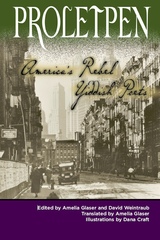 Proletpen: America’s Rebel Yiddish Poets
Edited by Amelia Glaser and David Weintraub
University of Wisconsin Press, 2005 This anthology presents a rich but little-known body of American Yiddish poetry from the 1920s to the early 1950s by thirty-nine poets who wrote from the perspective of the proletarian left. Presented on facing pages in Yiddish and English translation, these one hundred poems are organized thematically under such headings as Songs of the Shop, United in Struggle, Matters of the Heart, The Poet on Poetry, and Wars to End All Wars. One section is devoted to verse depicting the struggles of African Americans, including several poems prompted by the infamous Scottsboro trial of nine African American men falsely accused of rape. Home to many of the writers, New York City is the subject of a varied array of poems. The volume includes an extensive introduction by Dovid Katz, a biographical note about each poet, a bibliography, and a timeline of political, social, and literary events that provide context for the poetry. Winner of the Fenia and Yaakov Leviant Memorial Prize in Yiddish Studies for Outstanding Translation A Choice Outstanding Academic Title
 Pro-Life, Pro-Choice: Shared Values in the Abortion Debate
Bertha Alvarez Manninen
Vanderbilt University Press, 2014 In this provocative and accessible book, the author defends a pro-choice perspective but also takes seriously pro-life concerns about the moral value of the human fetus, questioning whether a fetus is nothing more than "mere tissue." She examines the legal status of the fetus in the recent Personhood Amendments in state legislatures and in Supreme Court decisions and asks whether Roe v. Wade should have focused on the viability of the fetus or on the bodily integrity of the woman. Manninen approaches the abortion controversy through a variety of perspectives and ethical frameworks. She addresses the social circumstances that influence many women's decision to abort and considers whether we believe that there are good and bad reasons to abort. Manninen also looks at the call for post-abortion fetal grieving rituals for women who desire them and the attempt to make room in the pro-choice position for the views of prospective fathers. The author spells out how the two sides demonize each other and proposes ways to find degrees of convergence between the seemingly intractable positions.
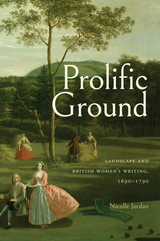 Prolific Ground: Landscape and British Women's Writing, 1690–1790
Nicolle Jordan
Bucknell University Press, 2025 Land ownership—and engagement with land more generally—constituted a crucial dimension of female independence in eighteenth-century Britain. Because political citizenship was restricted to male property owners, women could not wield political power in the way propertied men did. Given its foundational sociopolitical function, land necessarily generated copious writing that vested it with considerable aesthetic and economic value. This book, then, situates these issues in relation to the historical transformation of landscape under emergent capitalism. The women writers featured herein—including Jane Barker, Anne Finch, Sarah Scott, and Elizabeth Montagu—participated in this transformation by celebrating female estate stewardship and evaluating the estate stewardship of men. By asserting their authority in such matters, these writers acquired a degree of independence and self-determination that otherwise proved elusive.
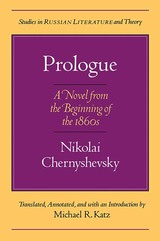 Prologue: A Novel for the Beginning of the 1860s
Michael R. Katz
Northwestern University Press, 1994 Nikolai Chernyshevsky (1828-89) is most famous as the author of What is To Be Done? (1863), one of the most inspirational texts in the Russian revolutionary movement. But during his long and lonely Siberian exile Chernyshevsky wrote Prologue, an novel of extraordinary interest for anyone eager to understand the course of Russian history and the political debate over democratization taking place in Russia today.
Set in Petersburg in 1857, on the eve of the great reforms that would include the emancipation of the serfs, Prologue expresses the author's hostility toward Russian liberals, their halfhearted attempts to alleviate the sufferings of peasants, and their insufficient support of revolution, while also exploring the obstacles in the path of women's social and personal development in the Victorian era. Michael R. Katz's new translation makes this singular work available to the non-Russian reading public for the first time.
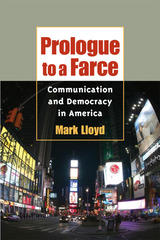 Prologue to a Farce: Communication and Democracy in America
Mark Lloyd
University of Illinois Press, 2006 “A popular Government without popular information or the means of acquiring it, is but a Prologue to a Farce or a Tragedy or perhaps both.”--James Madison, 1822 Mark Lloyd has crafted a complex and powerful assessment of the relationship between communication and democracy in the United States. In Prologue to a Farce, he argues that citizens’ political capabilities depend on broad public access to media technologies, but that the U.S. communications environment has become unfairly dominated by corporate interests. Drawing on a wealth of historical sources, Lloyd demonstrates that despite the persistent hope that a new technology (from the telegraph to the Internet) will rise to serve the needs of the republic, none has solved the fundamental problems created by corporate domination. After examining failed alternatives to the strong publicly owned communications model, such as antitrust regulation, the public trustee rules of the Federal Communications Commission, and the underfunded public broadcasting service, Lloyd argues that we must re-create a modern version of the Founder’s communications environment, and offers concrete strategies aimed at empowering citizens.
 Prologue to the Chinese Revolution: The Transformation of Ideas and Institutions in Hunan Province, 1891–1907
Charlton M. Lewis
Harvard University Press, 1976 Hunan province has long interested students of modern China. A citadel of orthodoxy in the nineteenth century and a mainspring of revolution in the twentieth, it is an ideal focus for a study of the great transformation that occurred during the last two decades of the Ch'ing dynasty.
Hunan's experience illuminates key questions. How did foreign imperialism affect Chinese society? What ties bound the provinces to the central government, and how were these ties loosened to permit the secession movement of 1911? Why did nationalism emerge so abruptly and strongly after 1895? How did it differ from the antiforeignism that preceded it, and what did it contribute to the movement against the dynasty? As nationalism became strong, why did social revolution remain weak?
Since Hunanese leadership, moving from orthodoxy through revolution, constitutes one of the great continuities in China's modern history, the answers that a study of Hunan gives to these questions are relevant to larger patterns of change in China as a whole. Charlton Lewis has written a valuable handbook of national as well as provincial events during the turbulent period around the turn of the century.
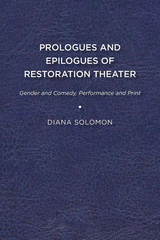 Prologues and Epilogues of Restoration Theater: Gender and Comedy, Performance and Print
Diana Solomon
University of Delaware Press, 2013 Often perceived as merely formulaic or historical documents, dramatic prologues and epilogues – players’ comic, poetic bids for the audience’s good opinion – became essential parts of Restoration theater, appearing in over 90 percent of performed and printed plays between 1660 and 1714. Their popularity coincided with the rise of the English actress, and Prologues and Epilogues of Restoration Theater unites these elements in the first book-length study on the subject. It finds that these paratexts provided the first sanctioned space for actresses in Britain to voice ideas in public, communicate directly with other women, and perform comedy – arguably the most powerful type of speech, and one that enabled interrogation of misogynist social practices. This book provides a taxonomy of prologues and epilogues with a corresponding appendix, and demonstrates through case studies of Anne Bracegirdle and Anne Oldfield how the study of prologues and epilogues enriches Restoration theater scholarship.
Published by University of Delaware Press. Distributed worldwide by Rutgers University Press.
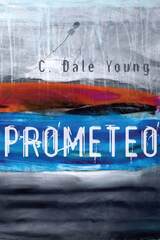 Prometeo
C. Dale Young
Four Way Books, 2021 An unflinching reckoning with the traumas of one’s life and those inherited through a history of exacted injustices
“Some men find nothing, and others / find omens everywhere,” writes C. Dale Young in Prometeo, a collection whose speaker is a proverbial “child of fire.” In poems that thrive off of their distinct voice, the speaker confronts generational and lived trauma and their relationship to his multi-ethnicity. We are presented with the idea of the past’s burial in the body and its constellatory manifestations—both in the speaker and those around him—in disease and pain, but also in strength and a capacity for intimacy with others and nature. Grounded in precise language, Young’s examination of the past and its injuries turns into a celebration of the self. In stark, exuberant relief, the speaker proclaims “…I was splendidly blended, genetically engineered / for survival.” Resilient, Young’s poems find beauty in landscape, science, and meditation.
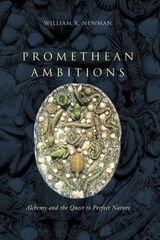 Promethean Ambitions: Alchemy and the Quest to Perfect Nature
William R. Newman
University of Chicago Press, 2004 In an age when the nature of reality is complicated daily by advances in bioengineering, cloning, and artificial intelligence, it is easy to forget that the ever-evolving boundary between nature and technology has long been a source of ethical and scientific concern: modern anxieties about the possibility of artificial life and the dangers of tinkering with nature more generally were shared by opponents of alchemy long before genetic science delivered us a cloned sheep named Dolly.
In Promethean Ambitions, William R. Newman ambitiously uses alchemy to investigate the thinning boundary between the natural and the artificial. Focusing primarily on the period between 1200 and 1700, Newman examines the labors of pioneering alchemists and the impassioned—and often negative—responses to their efforts. By the thirteenth century, Newman argues, alchemy had become a benchmark for determining the abilities of both men and demons, representing the epitome of creative power in the natural world. Newman frames the art-nature debate by contrasting the supposed transmutational power of alchemy with the merely representational abilities of the pictorial and plastic arts—a dispute which found artists such as Leonardo da Vinci and Bernard Palissy attacking alchemy as an irreligious fraud. The later assertion by the Paracelsian school that one could make an artificial human being—the homunculus—led to further disparagement of alchemy, but as Newman shows, the immense power over nature promised by the field contributed directly to the technological apologetics of Francis Bacon and his followers. By the mid-seventeenth century, the famous "father of modern chemistry," Robert Boyle, was employing the arguments of medieval alchemists to support the identity of naturally occurring substances with those manufactured by "chymical" means.
In using history to highlight the art-nature debate, Newman here shows that alchemy was not an unformed and capricious precursor to chemistry; it was an art founded on coherent philosophical and empirical principles, with vocal supporters and even louder critics, that attracted individuals of first-rate intellect. The historical relationship that Newman charts between human creation and nature has innumerable implications today, and he ably links contemporary issues to alchemical debates on the natural versus the artificial.
Prometheus and the Liver through Art and Medicine
Julia van Rosmalen
Amsterdam University Press, 2022 Prometheus was punished by the supreme god Zeus for giving to mankind the Olympic fire with which they learned to think and feel. He was chained to a cliff in the Caucasus, where, to make matters worse, he was visited daily by an eagle who ate part of his liver. At night, however, his liver grew back. We now know that the liver can regenerate, but were the ancient Greeks aware of this quality? The myth of Prometheus has been a source of inspiration for many visual artists over the centuries. In this book, the medical history of the liver is traced through the ages through an examination of historical texts on the organ’s functions and properties, parallel to the art movements in which the fascinating iconography of Prometheus is reviewed. The book offers a surprising interplay of art and medicine, placing emphasis on the unique morphology of the liver.
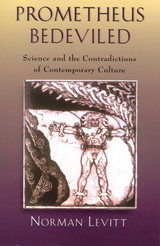 Prometheus Bedeviled: Science and the Contradictions of Contemporary Culture
Levitt, Norman
Rutgers University Press, 1999 In this lucid critique, Norman Levitt examines the strained relations between science and contemporary society. For the most part, Levitt states, we idolize musicians and cheer on athletes, yet we view scientists with a mixture of awe and unease. Significantly, too, we are unsure how scientific discovery actually fits into the broader schemes of politics, and policy. Even beyond pragmatic questions, we remain anxious about the implications of science for our basic understanding of human values and purpose. One result of this uncertainty about scientific work is an ill-informed crusade to “democratize” science. It has become fashionable lately, Levitt states, for non-scientists to attempt to intervene in science policy, which often results in methodologically unsound decisions. The embrace of "alternative medicine" is a particularly ominous example. Levitt suggests that science, by virtue of its accuracy and reliability, deserves to be at the top of the hierarchy of knowledge, and that our social institutions ought to take this fact strongly into account. Levitt hopes that Americans will become aware of the limitations of unchecked populism and will be willing to yield a bit of “democratic” control over certain questions in order to minimize the danger that sound science will be ignored or overridden. However, this trust in scientific methodology must be part of a broader understanding. Science must not only act responsibly toward our democratic institutions; it must also concede that our society has the right to decide what kinds of research are most consistent with larger goals and therefore deserve the most support.
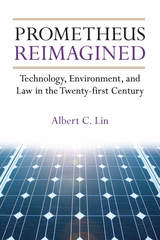 Prometheus Reimagined: Technology, Environment, and Law in the Twenty-first Century
Albert C. Lin
University of Michigan Press, 2013 Technologies such as synthetic biology, nanotechnology, artificial intelligence, and geoengineering promise to address many of our most serious problems, yet they also bring environmental and health-related risks and uncertainties. Moreover, they can come to dominate global production systems and markets with very little public input or awareness. Existing governance institutions and processes do not adequately address the risks of new technologies, nor do they give much consideration to the concerns of persons affected by them.
Instead of treating technology, health, and the environment as discrete issues, Albert C. Lin argues that laws must acknowledge their fundamental relationship, anticipating both future technological developments and their potential adverse effects. Laws should encourage international cooperation and the development of common global standards, while allowing for flexibility and reassessment.
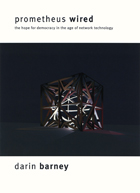 Prometheus Wired: The Hope for Democracy in the Age of Network Technology
Darin Barney
University of Chicago Press, 2000 From all sides, we hear that computer technology, with its undeniable power to disseminate information and connect individuals, holds enormous potential for a reinvigoration of political life. But will the Internet really spark a democratic revolution? And will the changes it brings be so profound that past political thought will be of little use in helping us to understand them?
In Prometheus Wired, Darin Barney debunks claims that a networked society will provide the infrastructure for a political revolution and shows that the resources we need for understanding and making sound judgments about this new technology are surprisingly close at hand. By looking to thinkers who grappled with the relationship of society and technology, such as Plato, Aristotle, Marx, and Heidegger, Barney critically examines such assertions about the character of digital networks.
Along the way, Barney offers an eye-opening history of digital networks and then explores a wide range of contemporary issues, such as electronic commerce, telecommuting, privacy, virtual community, digital surveillance, and the possibility of sovereign governance in an age of global networks. Ultimately, Barney argues that instead of placing power back in the hands of the public, a networked economy seems to exacerbate the worst features of industrial capitalism, and, in terms of the surveillance and control it exerts, reduces our political freedom.
Of vital interest to politicians, communicators, and anyone concerned about the future of democracy in the digital age, Prometheus Wired adds a provocative new voice to the debate swirling around "the Net" and the ways in which it will, or will not, change our political lives.
 Promiscuity: An Evolutionary History of Sperm Competition
Tim Birkhead
Harvard University Press, 2000 Males are promiscuous and ferociously competitive. Females--both human and of other species--are naturally monogamous. That at least is what the study of sexual behavior after Darwin assumed, perhaps because it was written by men. Only in recent years has this version of events been challenged. Females, it has become clear, are remarkably promiscuous and have evolved an astonishing array of strategies, employed both before and after copulation, to determine exactly who will father their offspring.
Tim Birkhead reveals a wonderful world in which males and females vie with each other as they strive to maximize their reproductive success. Both sexes have evolved staggeringly sophisticated ways to get what they want--often at the expense of the other. He introduces us to fish whose first encounter locks them together for life in a perpetual sexual embrace; hermaphrodites who "joust" with their reproductive organs, each trying to inseminate the other without being inseminated; and tiny flies whose seminal fluid is so toxic that it not only destroys the sperm of rival males but eventually kills the female. He explores the long and tortuous road leading to our current state of knowledge, from Aristotle's observations on chickens, to the first successful artificial insemination in the seventeenth century, to today's ingenious molecular markers for assigning paternity. And he shows how much human behavior--from the wife-sharing habits of Inuit hunters to Charlie Chaplin's paternity case--is influenced by sperm competition.
Lucidly written and lavishly illustrated, with a wealth of fascinating detail and vivid examples, Promiscuity is the ultimate guide to the battle of the sexes.
Promiscuous Grace: Imagining Beauty and Holiness with Saint Mary of Egypt
Sonia Velázquez
University of Chicago Press, 2023 A meditation on holiness and beauty through the study of Saint Mary of Egypt.
Saint Mary of Egypt has fascinated theologians, poets, and artists since the seventh century. Her story is richly evocative, encompassing sin and sanctity, concupiscence and asceticism, youth and old age. In Promiscuous Grace, Sonia Velázquez thinks with Saint Mary of Egypt about the relationship between beauty and holiness. Drawing on an archive spanning Spanish medieval poetry, Baroque paintings, seventeenth-century hagiography, and Balzac’s Le chef-d’œuvre inconnu, Velázquez argues for the importance of the senses on the surface of religious texts on her way to revealing why the legend of Saint Mary of Egypt still matters today.
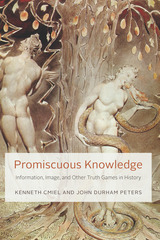 Promiscuous Knowledge: Information, Image, and Other Truth Games in History
Kenneth Cmiel and John Durham Peters
University of Chicago Press, 2020 Sergey Brin, a cofounder of Google, once compared the perfect search engine to “the mind of God.” As the modern face of promiscuous knowledge, however, Google’s divine omniscience traffics in news, maps, weather, and porn indifferently. This book, begun by the late Kenneth Cmiel and completed by his close friend John Durham Peters, provides a genealogy of the information age from its early origins up to the reign of Google. It examines how we think about fact, image, and knowledge, centering on the different ways that claims of truth are complicated when they pass to a larger public. To explore these ideas, Cmiel and Peters focus on three main periods—the late nineteenth century, 1925 to 1945, and 1975 to 2000, with constant reference to the present. Cmiel’s original text examines the growing gulf between politics and aesthetics in postmodern architecture, the distancing of images from everyday life in magical realist cinema, the waning support for national betterment through taxation, and the inability of a single presentational strategy to contain the social whole. Peters brings Cmiel’s study into the present moment, providing the backstory to current controversies about the slipperiness of facts in a digital age. A hybrid work from two innovative thinkers, Promiscuous Knowledge enlightens our understanding of the internet and the profuse visual culture of our time.
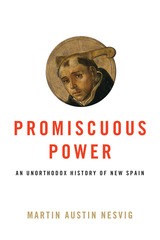 Promiscuous Power: An Unorthodox History of New Spain
By Martin Austin Nesvig
University of Texas Press, 2018 Honorable Mention, Bandelier/Lavrin Book Award in Colonial Latin America, Rocky Mountain Council on Latin American Studies (RMCLAS), 2019
Honorable Mention, The Alfred B. Thomas Book Award, Southeastern Council of Latin American Studies (SECOLAS), 2019 Scholars have written reams on the conquest of Mexico, from the grand designs of kings, viceroys, conquistadors, and inquisitors to the myriad ways that indigenous peoples contested imperial authority. But the actual work of establishing the Spanish empire in Mexico fell to a host of local agents—magistrates, bureaucrats, parish priests, ranchers, miners, sugar producers, and many others—who knew little and cared less about the goals of their superiors in Mexico City and Madrid. Through a case study of the province of Michoacán in western Mexico, Promiscuous Power focuses on the prosaic agents of colonialism to offer a paradigm-shifting view of the complexities of making empire at the ground level. Presenting rowdy, raunchy, and violent life histories from the archives, Martin Austin Nesvig reveals that the local colonizers of Michoacán were primarily motivated by personal gain, emboldened by the lack of oversight from the upper echelons of power, and thoroughly committed to their own corporate memberships. His findings challenge some of the most deeply held views of the Spanish colonization of Mexico, including the Black Legend, which asserts that the royal state and the institutional church colluded to produce a powerful Catholicism that crushed heterodoxy, punished cultural difference, and ruined indigenous worlds. Instead, Nesvig finds that Michoacán—typical of many frontier provinces of the empire—became a region of refuge from imperial and juridical control and formal Catholicism, where the ordinary rules of law, jurisprudence, and royal oversight collapsed in the entropy of decentralized rule.
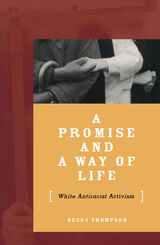 A Promise And A Way Of Life: White Antiracist Activism
Becky Thompson
University of Minnesota Press, 2001 The first in-depth look at white people’s activism in fighting racism during the past fifty years.
Not since the Civil Rights Movement of the 1950s and 1960s, when many white college students went south to fight against Jim Crow laws, has white antiracist activity held the public’s attention. Yet there have always been white people involved in fighting racism. In this passionate work, Becky Thompson looks at white Americans who have struggled against racism, offering examples of both successes and failures, inspirations, practical philosophies, and a way ahead. A Promise and a Way of Life weaves an account of the past half-century based on the life histories of thirty-nine people who have placed antiracist activism at the center of their lives. Through a rich and fascinating narrative that links individual experiences with social and political history, Thompson shows the ways, both public and personal, in which whites have opposed racism during several social movements: the Civil Rights and Black Power movements, multiracial feminism, the Central American peace movement, the struggle for antiracist education, and activism against the prison industry. Beginning with the diverse catalysts that started these activists on their journeys, this book demonstrates the contributions and limitations of white antiracism in key social justice movements. Through these stories, crucial questions are raised: Does antiracist work require a repudiation of one’s whiteness or can that identity be transformed through political commitment and alliances? What do white people need to do to undermine white privilege? What would it take to build a multiracial movement in which white people are responsible for creating antiracist alliances while not co-opting people of color? Unique in its depth and thoroughness, A Promise and a Way of Life is essential for anyone currently fighting racism or wondering how to do so. Through its demonstration of the extraordinary personal and social transformations ordinary people can make, it provides a new paradigm for movement activity, one that will help to incite and guide future antiracist activism.
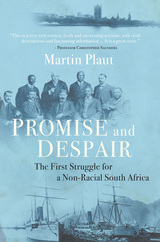 Promise and Despair: The First Struggle for a Non-Racial South Africa
Martin Plaut
Ohio University Press, 2016 The struggle for freedom in South Africa goes back a long way. In 1909, a remarkable interracial delegation of South Africans traveled to London to lobby for a non-racialized constitution and franchise for all. Among their allies was Mahatma Gandhi, who later encapsulated lessons from the experience in his most important book, Hind Swaraj. Though the mission failed, the London debates were critical to the formation of the African National Congress in 1912. With impeccable storytelling and rich character depictions, Martin Plaut describes the early quest for black franchise and the seeds it planted for a new South Africa. While most people believe that black South Africans obtained the vote in 1994, men of all races voted in the Cape Colony for almost a century, sometimes deciding election outcomes. The London mission was part of a long history of nonwhite political agency. Taking as its centerpiece the 1909 delegation, Promise and Despair covers the twelve years between the South African War and the First World War, during which the major forces that would shape twentieth-century South Africa were forged. Plaut reveals new details of the close collaboration between Gandhi and the ANC leadership during the Indian-South African community’s struggle for their rights, the influence of the American South on South African racial practices, and the workings of the Imperial system.
The Promise and Paradox of Civil Service Reform
Patricia W. Ingraham
University of Pittsburgh Press, 1993
Contains fourteen essays that examine, through a public policy focus, the 1978 civil service reform and its aftermath. The essays view policy design, implementation, and evaluation, as well as the overall politics of administration and institutional change. An indispensible tool for students of public administration, bureaucratic politics, and personnel policy.
Contributors: Carolyn Ban; John Halligan; Kirke Harper; Mark Huddleston; J. Edward Kellough; Larry M. Lane; Chester A. Newland; James L. Perry; Beryl A. Radin; Robert Vaughn; and the editors.
 Promise and Peril: America at the Dawn of a Global Age
Christopher McKnight Nichols
Harvard University Press, 2011 Spreading democracy abroad or taking care of business at home is a tension as current as the war in Afghanistan and as old as America itself. Tracing the history of isolationist and internationalist ideas from the 1890s through the 1930s, Nichols reveals unexpected connections among individuals and groups from across the political spectrum who developed new visions for America’s place in the world.
From Henry Cabot Lodge and William James to W. E. B. Du Bois and Jane Addams to Randolph Bourne, William Borah, and Emily Balch, Nichols shows how reformers, thinkers, and politicians confronted the challenges of modern society—and then grappled with urgent pressures to balance domestic priorities and foreign commitments. Each articulated a distinct strain of thought, and each was part of a sprawling national debate over America’s global role. Through these individuals, Nichols conducts us into the larger community as it strove to reconcile America’s founding ideals and ideas about isolation with the realities of the nation’s burgeoning affluence, rising global commerce, and new opportunities for worldwide cultural exchange. The resulting interrelated set of isolationist and internationalist principles provided the basis not just for many foreign policy arguments of the era but also for the vibrant as well as negative connotations that isolationism still possesses.
Nichols offers a bold way of understanding the isolationist and internationalist impulses that shaped the heated debates of the early twentieth century and that continue to influence thinking about America in the world today.
 Promise and Peril: The Paradox of Religion as Resource and Threat
Anna Lannstrom
University of Notre Dame Press, 2003 Promise and Peril delivers current analysis of the major religious conflicts in the world, including eye-opening assessments by leading academics and journalists of hot-button issues such as fundamentalism, the Israeli/Palestinian conflict, and the growing hostility between Pakistan and India. This essential volume also turns its attention to lesser-known religious threats such as the new Japanese religion Aum Shinrikyô, which in 1995 unleashed the nerve gas sarin on a crowded Tokyo subway.
In her essay, Karen Armstrong offers a clear understanding of what fundamentalism is and what it is not. She contends that while fundamentalism is rarely violent, the survivalist mentality of many fundamentalists can push them to become militant. She gives a stunning account of the circumstances that changed Sayyid Qutb, mentor to Osama Bin Laden and most other Sunni fundamentalists, from moderate liberal to violent militant. Marc Gopin demonstrates how promoting respect for Jewish and Muslim religious symbols and rituals can promote peace between Israel and Palestine. He includes fascinating excerpts from his lengthy conversation with Yassir Arafat on this topic. Other essays in the collection address topics such as nuclearization in South Asia, moral paradoxes in Hinduism, and the pros and cons of state-religion partnership.
Contributors to this volume focus on the ambiguity of religion as both promise and peril. They ask tough questions, such as: how do we prevent fundamentalism from turning violent? How do we drawn upon what is compassionate and good in religious beliefs to promote lasting peace in places such as the Middle East and Northern Ireland? While each author has a different answer to these questions, all hold out hope that by combating ignorance with dialogue and understanding, religion may recognize its promise and diminish its peril.
ANNA LÄNNSTRÖM is assistant director of the Institute for Philosophy and Religion, and instructor in the department of philosophy at Boston University
----------
"Does religion promote or diminish violence in the world? A number of prominent scholars of religion here provide thoughtful and informed reflections on a topic that hardly needs emphasizing since 9-11. This is an excellent book, which merits a wide readership." --Peter L. Berger, Boston University
"Promise and Peril is a collection of studies we have been in need of for years. Few of us who deal with religion have exerted ourselves enough to make clear that religion is not necessarily a pleasant thing. This simple lesson still comes as a surprise to most people. We must listen to what is said in the pages of this splendid volume." --Kees W. Bolle
"An accessible and timely examination of religious fundamentalisms and the violence they often generate." --Conscience
"This is a thought-provoking and very readable volume that deals with the infrequently discussed issue of whether the social effects of religion are as positive as is sometimes assumed."--Catholic Library World
"…an eclectic mix, each intersting in their own right…"--Contact
"Anyone who deals with issues of conflict between religions will benefit from reading this collection." --Conrad Grebel Review
 A Promise at Sobibór: A Jewish Boy’s Story of Revolt and Survival in Nazi-Occupied Poland
Philip “Fiszel” Bialowitz, with Joseph Bialowitz; Foreword by Wladyslaw Bartoszewski
University of Wisconsin Press, 2012 A Promise at Sobibór is the story of Fiszel Bialowitz, a teenaged Polish Jew who escaped the Nazi gas chambers. Between April 1942 and October 1943, about 250,000 Jews from European countries and the Soviet Union were sent to the Nazi death camp at Sobibór in occupied Poland. Sobibór was not a transit camp or work camp: its sole purpose was efficient mass murder. On October 14, 1943, approximately half of the 650 or so prisoners still alive at Sobibór undertook a daring and precisely planned revolt, killing SS officers and fleeing through minefields and machine-gun fire into the surrounding forests, farms, and towns. Only about forty-two of them, including Fiszel, are known to have survived to the end of the war.
Philip (Fiszel) Bialowitz, now an American citizen, tells his eyewitness story here in the real-time perspective of his own boyhood, from his childhood before the war and his internment in the brutal Izbica ghetto to his harrowing six months at Sobibór—including his involvement in the revolt and desperate mass escape—and his rescue by courageous Polish farmers. He also recounts the challenges of life following the war as a teenaged displaced person, and his eventual efforts as a witness to the truth of the Holocaust.
In 1943 the heroic leaders of the revolt at Sobibór, Sasha Perchersky and Leon Feldhendler, implored fellow prisoners to promise that anyone who survived would tell the story of Sobibór: not just of the horrific atrocities committed there, but of the courage and humanity of those who fought back. Bialowitz has kept that promise.
Best Books for General Audiences, selected by the American Association for School Libraries
Best Books for High Schools, selected by the American Association for School Libraries
Best Books for Special Interests, selected by the Public Library Association
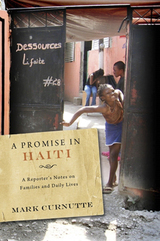 A Promise in Haiti: A Reporter's Notes on Families and Daily Lives
Mark Curnutte
Vanderbilt University Press, 2011 When a devastating earthquake struck near Port-au-Prince, Haiti, on January 12, 2010, the world reacted with a collective, yet distant, horror. For Cincinnati Enquirer reporter Mark Curnutte, hearing the news provoked a far more visceral response. Curnutte had grown to love Haiti and its people as only someone who had lived with Haiti's families could.
A Promise in Haiti is Curnutte's story of his time, spanning the last decade, living among several families in Gonaives, a city of 200,000 people a hundred kilometers north of Port-au-Prince. He began traveling to Haiti as a volunteer with the aid organization Hands Together, eventually building trust and credibility with many Haitians. Curnutte introduces the reader to the Cenecharles family, strained by entrenched unemployment and the need to continually travel for work. He is invited into the home of the Henrisma family, and is forced to reconcile journalistic detachment with basic compassion as he contributes financially to help them. The reader is confronted with a complicated, conflicted written and photographic record of a worldview that evolves right on the page. As a reporter, Curnutte found parallels between the lives he encountered in Gonaives and the world of the Great Depression recounted in James Agee and Walker Evans's Let Us Now Praise Famous Men. Agee and Evans loom large as a challenge and inspiration to Curnutte.
The result is equal parts homage to that historic chronicle, on-the-ground reporting, and introspective narrative on the lessons Gonaives taught Curnutte about his own life and family. In late February 2010, Curnutte went back to Haiti on assignment, but conditions made it impossible for him to return to Gonaives. The resulting frustration provoked a meditation on the monumental challenges that face Haiti -- and on the destructive cycle of international attention that constantly moves on to "The Next Big Story."
 The Promise Keepers: Servants, Soldiers, and Godly Men
Bartkowski, John P
Rutgers University Press, 2004 “Remember the Promise Keepers?” queries a recent media story on the evangelical men’s movement that captured America’s imagination and generated intense controversy during much of the 1990s. This group of Christian men, who promoted adherence to a strict code of conduct that masculinized conservative religious and social values, now evokes little more than a hazy memory of football stadiums teeming with men whose tear-stained faces and clasped arms signaled spiritual transformation. What happened? What factors contributed to their demise? What broader insights can be gleaned from the rapid rise and fall of the movement? John P. Bartkowski has written the first account scrutinizing the turbulent forces that contributed to the group’s wild popularity, declining fortunes, and current efforts to reinvent itself. He provides a broad and balanced portrait of the movement while evaluating its impact on the landscape of American religion. Bartkowski argues that there are many insights to be gained about the changing contours of American religion, culture, and social life through a study of the Promise Keepers. By carefully examining their character and contagious appeal, Bartkowski provides new insights about evangelicalism, gender, family, therapeutic culture, sport, and multiculturalism.
 The Promise of Beauty
Mimi Thi Nguyen
Duke University Press, 2024 In The Promise of Beauty, Mimi Thi Nguyen explores the relationship between the concept of beauty and narratives of crisis and catastrophe. Nguyen conceptualizes beauty, which, she observes, we turn to in emergencies and times of destruction, as a tool to identify and bridge the discrepancy between the world as it is and what it ought to be. Drawing widely from aesthetic and critical theories, Nguyen outlines how beauty—or its lack—points to the conditions that must exist for it to flourish. She notes that an absence of beauty becomes both a political observation and a call to action to transform the conditions of the situation so as to replicate, preserve, or repair beauty. The promise of beauty can then engender a critique of social arrangements and political structures that would set the foundations for its possibility and presence. In this way, Nguyen highlights the role of beauty in inspiring action toward a more just world.
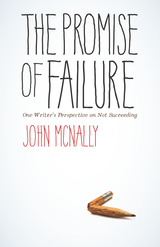 The Promise of Failure: One Writer's Perspective on Not Succeeding
John McNally
University of Iowa Press, 2018 The Promise of Failure is part memoir of the writing life, part advice book, and part craft book; sometimes funny, sometimes wrenching, but always honest. McNally uses his own life as a blueprint for the writer’s daily struggles as well as the existential ones, tackling subjects such as when to quit and when to keep going, how to deal with depression, what risking something of yourself means, and ways to reenergize your writing through reinvention. What McNally illuminates is how rejection, in its best light, is another element of craft, a necessary stage to move the writer from one project to the next, and that it’s best to see rejection and failure on a life-long continuum so that you can see the interconnectedness between failure and success, rather than focusing on failure as a measure of self-worth. As brutally candid as McNally can sometimes be, The Promise of Failure is ultimately an inspiring book—never in a Pollyannaish self-help way. McNally approaches the reader as a sympathetic companion with cautionary tales to tell. Written by an author who has as many unpublished books under his belt as published ones, The Promise of Failure is as much for the newcomer as it is for the established writer.
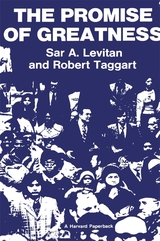 The Promise of Greatness
Sar A. Levitan and Robert Taggart
Harvard University Press, 1976 What is the right social policy for the future? Sar A. Levitan and Robert Taggart have written a book that dispassionately examines recent social programs. They respond to the fashionable arguments that question the results of government intervention and the need to correct social and economic ills. They weigh the charges that new programs have been wasteful, ineffective, and even counterproductive. The authors disprove the notion that recent social programs have failed, that recipients of aid have been hurt more than helped, or that the means and the ends of the last decade’s social policies were misconceived.
They base their conclusions upon data gathered by a host of governmental agencies as well as by other scholarly studies. Among their major findings:
— The expansion of welfare will not continue indefinitely since most of those in need have been reached. In a healthy economy welfare costs will stabilize. In spite of its shortcomings, welfare has resulted in a more equitable, comprehensive system of income protection.
— Medicare and Medicaid have not contributed to a national “health crisis” but have delivered health care to millions who might otherwise have been unable to afford it.
— Housing assistance has been unfairly condemned. While changes are warranted the concepts are sound and the benefits undeniable.
— Federal programs for vocational training, job placement, remedial education, and other services have a high payoff for the individuals involved and for society as a whole.
— Federal efforts have been instrumental in the substantial progress made by minorities.
Levitan and Taggart consistently document effective, positive achievements by government to promote the general welfare and to redress many of the nation’s most serious social and economic ills stemming from poverty, discrimination, and old age. They argue that an affluent and compassionate society has the ability and responsibility to extend rather than to retrench its basic system of protection for those who cannot make it on their own. If progress toward a just society is to continue, the new agenda must begin with a judicious and comprehensive reappraisal of last decade’s reforms. The Promise of Greatness provides such a perspective. Based upon a sound analysis of past legislation, it will certainly be an indispensable guide to the future policies that shape this country.
 The Promise of Green Politics: Environmentalism and the Public Sphere
Douglas Torgerson
Duke University Press, 1999 Politics today is dominated by business news and the stock market. But those in support of green politics ask whether human profit should continue to be the bottom line of political deliberations or if it is time for the interests of the natural world to combine with or even displace the interests of business. In The Promise of Green Politics Douglas Torgerson offers a survey of different schools of ecological thought, discusses their implications for the larger political sphere, and advances a three-dimensional concept of politics that emphasizes ethics and discourse as well as strategy.
Arguing that the environmental movement has the potential to contribute to contemporary developments in political theory and social action by changing discursive practices both at the grassroots level and along the corridors of power, Torgerson draws on the theories of Hannah Arendt and others to advocate a performative type of political debate that values multiple opinions and is not always oriented toward reaching a single conclusion. Torgerson argues that in a world stuck in administrative and scientific gridlock, the theatrical, comic aspects of green politics are as important as other, more goal-oriented, aspects. Gestures of the carnivalesque—such as protestors sleeping in hammocks slung from trees targeted for destruction or funeral processions held for dying rivers—could be the key to the creation of what Torgerson refers to as a “green public sphere,” one that promises a reconfiguration of the relationship between human creativity and the natural world. While offering a number of concrete policy suggestions, his focus remains on the complexity and heterogeneity of green thinking and on the transformative promise implicit in green politics. In creating new ways to speak about the environment, Torgerson argues, the green movement offers a creative way to reconsider many larger issues of political theory and action.
The Promise of Green Politics will serve as a gateway to new thinking about green politics and the emerging possibilities of a diverse and vital green public sphere. As such, it will be valued by those interested in environmental and public policy, political theory, social activism, and the future of political action.
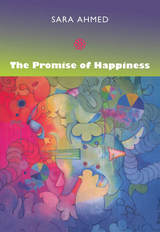 The Promise of Happiness
Sara Ahmed
Duke University Press, 2010 The Promise of Happiness is a provocative cultural critique of the imperative to be happy. It asks what follows when we make our desires and even our own happiness conditional on the happiness of others: “I just want you to be happy”; “I’m happy if you’re happy.” Combining philosophy and feminist cultural studies, Sara Ahmed reveals the affective and moral work performed by the “happiness duty,” the expectation that we will be made happy by taking part in that which is deemed good, and that by being happy ourselves, we will make others happy. Ahmed maintains that happiness is a promise that directs us toward certain life choices and away from others. Happiness is promised to those willing to live their lives in the right way. Ahmed draws on the intellectual history of happiness, from classical accounts of ethics as the good life, through seventeenth-century writings on affect and the passions, eighteenth-century debates on virtue and education, and nineteenth-century utilitarianism. She engages with feminist, antiracist, and queer critics who have shown how happiness is used to justify social oppression, and how challenging oppression causes unhappiness. Reading novels and films including Mrs. Dalloway, The Well of Loneliness, Bend It Like Beckham, and Children of Men, Ahmed considers the plight of the figures who challenge and are challenged by the attribution of happiness to particular objects or social ideals: the feminist killjoy, the unhappy queer, the angry black woman, and the melancholic migrant. Through her readings she raises critical questions about the moral order imposed by the injunction to be happy.
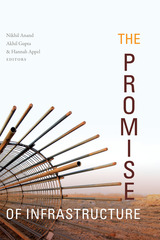 The Promise of Infrastructure
Nikhal Anand, Akhil Gupta, and Hannah Appel, editors
Duke University Press, 2018 From U.S.-Mexico border walls to Flint's poisoned pipes, there is a new urgency to the politics of infrastructure. Roads, electricity lines, water pipes, and oil installations promise to distribute the resources necessary for everyday life. Yet an attention to their ongoing processes also reveals how infrastructures are made with fragile and often violent relations among people, materials, and institutions. While infrastructures promise modernity and development, their breakdowns and absences reveal the underbelly of progress, liberal equality, and economic growth. This tension, between aspiration and failure, makes infrastructure a productive location for social theory. Contributing to the everyday lives of infrastructure across four continents, some of the leading anthropologists of infrastructure demonstrate in The Promise of Infrastructure how these more-than-human assemblages made over more-than-human lifetimes offer new opportunities to theorize time, politics, and promise in the contemporary moment.
A School for Advanced Research Advanced Seminar
Contributors. Nikhil Anand, Hannah Appel, Geoffrey C. Bowker, Dominic Boyer, Akhil Gupta, Penny Harvey, Brian Larkin, Christina Schwenkel, Antina von Schnitzler
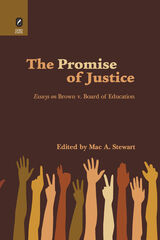 Promise of Justice: Essays on Brown v. Board of Education
Mac A. Stewart
Ohio State University Press, 2008 Brown v. Board of Education of Topeka Kansas (1954) was a landmark decision of the United States Supreme Court in the twentieth century. It overturned the Court’s earlier ruling in Plessy v. Ferguson (1896), declaring the establishment of separate public schools for black and white students, as inherently unequal. This victory paved the way for integration in public schools and the civil rights movement of the 1960s. The Promise of Justice: Essays on Brown v. Board of Education assembles fourteen essays about Brown and its consequences in the fifty years following the decision. Several of the essayists in this anthology provide personal recollections of the conditions before and immediately after the decision in Brown. One of the authors was a child plaintiff in a related case. Another was the federal district judge responsible for deciding in favor of, and then overseeing, integration in a major northern city. Contributors to this volume include legal specialists, sociologists, educators, and political scientists. A history of the legal milestones of integration is included, as well as judgments about the progress that has been made and the need for additional actions to assure racial equality under the law. Ten of these essays first appeared in a special issue of The Negro Educational Review published in January 2005, and four were written expressly for this volume.
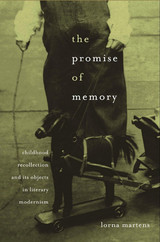 The Promise of Memory: Childhood Recollection and Its Objects in Literary Modernism
Lorna Martens
Harvard University Press, 2011 Readers once believed in Proust’s madeleine and in Wordsworth’s recollections of his boyhood—but that was before literary culture began to defer to Freud’s questioning of adult memories of childhood. In this first sustained look at childhood memories as depicted in literature, Lorna Martens reveals how much we may have lost by turning our attention the other way. Her work opens a new perspective on early recollection—how it works, why it is valuable, and how shifts in our understanding are reflected in both scientific and literary writings.
Science plays an important role in The Promise of Memory, which is squarely situated at the intersection of literature and psychology. Psychologists have made important discoveries about when childhood memories most often form, and what form they most often take. These findings resonate throughout the literary works of the three writers who are the focus of Martens’ book. Proust and Rilke, writing in the modernist period before Freudian theory penetrated literary culture, offer original answers to questions such as “Why do writers consider it important to remember childhood? What kinds of things do they remember? What do their memories tell us?” In Walter Benjamin, Martens finds a writer willing to grapple with Freud, and one whose writings on childhood capture that struggle.
For all three authors, places and things figure prominently in the workings of memory. Connections between memory and materiality suggest new ways of understanding not just childhood recollection but also the artistic inclination, which draws on a childlike way of seeing: object-focused, imaginative, and emotionally intense.
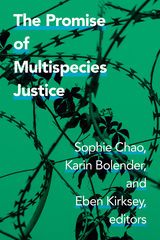 The Promise of Multispecies Justice
Sophie Chao, Karin Bolender, and Eben Kirksey, editors
Duke University Press, 2022 What are the possibilities for multispecies justice? How do social justice struggles intersect with the lives of animals, plants, and other creatures? Leading thinkers in anthropology, geography, philosophy, speculative fiction, poetry, and contemporary art answer these questions from diverse grounded locations. In America, Indigenous peoples and prisoners are decolonizing multispecies relations in unceded territory and carceral landscapes. Small justices are emerging in Tanzanian markets, near banana plantations in the Philippines, and in abandoned buildings of Azerbaijan as people navigate relations with feral dogs, weeds, rats, and pesticides. Conflicts over rights of nature are intensifying in Colombia’s Amazon. Specters of justice are emerging in India, while children in Micronesia memorialize extinct bird species. Engaging with ideas about environmental justice, restorative justice, and other species of justice, The Promise of Multispecies Justice holds open the possibility of flourishing in multispecies worlds, present and to come.
Contributors. Karin Bolender, Sophie Chao, M. L. Clark, Radhika Govindrajan, Zsuzsanna Dominika Ihar, Noriko Ishiyama, Eben Kirksey, Elizabeth Lara, Jia Hui Lee, Kristina Lyons, Michael Marder, Alyssa Paredes, Craig Santos Perez, Kim TallBear
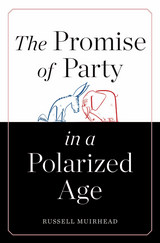 The Promise of Party in a Polarized Age
Russell Muirhead
Harvard University Press, 2014 At the root of America’s broken politics is hyperbolic partisanship. It distorts perceptions, inflames disagreements, and poisons the democratic process. Citizens pine for a time when liberals and conservatives compromised with one another—or they yearn for a post-partisan future when the common good trumps ideology and self-interest. Russell Muirhead argues that better partisanship, not less partisanship, is the solution to America’s political predicament. Instead of striving to overcome our differences, we should learn how to engage them.
The political conflicts that provide fodder for cable news shows are not simply manufactured from thin air. However sensationalized they become in the retelling, they originate in authentic disagreements over what constitutes the common welfare. Republicans vest responsibility in each citizen for dealing with bad decisions and bad luck, and want every individual and family to enjoy the benefits of good decisions and good luck. Democrats ask citizens to stand together to insure one another against the worst consequences of misfortune or poor judgment, and especially to insure children against some of the consequences of their parents’ bad decisions or lack of opportunities. These are fundamental differences that fantasies of bipartisan consensus cannot dissolve.
Disagreement without parties is disempowering, Muirhead says. The remedy is not for citizens and elected officials to learn to “just get along” but for them to bring a skeptical sensibility even to their own convictions, and to learn to disagree as partisans and govern through compromise despite those disagreements.
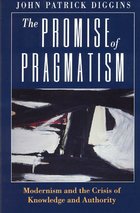 The Promise of Pragmatism: Modernism and the Crisis of Knowledge and Authority
John Patrick Diggins
University of Chicago Press, 1994 For much of our century, pragmatism has enjoyed a charmed life, holding the dominant point of view in American politics, law, education, and social thought in general. After suffering a brief eclipse in the post-World War II period, pragmatism has experienced a revival, especially in literary theory and such areas as poststructuralism and deconstruction. In this critique of pragmatism and neopragmatism, one of our leading intellectual historians traces the attempts of thinkers from William James to Richard Rorty to find a response to the crisis of modernism. John Patrick Diggins analyzes the limitations of pragmatism from a historical perspective and dares to ask whether America's one original contribution to the world of philosophy has actually fulfilled its promise.
"Diggins, an eminent historian of American intellectual life, has written a timely and impressive book charting the rich history of American pragmatism and placing William James, Charles Peirce, John Dewey, George Herbert Mead, Sidney Hook, and Richard Rorty in their times and in the light of contemporary concerns. The book also draws on an alternative set of American thinkers to explore the blind spots in the pragmatic temper."—William Connolly, New York Times Book Review
"An extraordinarily ambitious work of both analysis and synthesis. . . . Diggins's book is rewarding in its thoughtfulness and its nuanced presentation of ideas."—Daniel J. Silver, Commentary
"Diggins's superbly informed book comprises a comprehensive history of American pragmatic thought. . . . It contains expert descriptions of James, John Dewey and Charles Sanders Peirce, the first generation of American pragmatists. . . . Diggins is just as good on the revival of pragmatism that's taken place over the last 20 years in America. . . . [A] richly intelligent book."—Mark Edmundson, Washington Post Book World
 The Promise of Private Pensions: The First Hundred Years
Steven A. Sass
Harvard University Press, 1997 The private pension is a curiosity in the modern economic environment. Why do profit-seeking companies pay retirement benefits to those no longer on the job? In this new institutional history, Steven Sass explores the rise and growth of the financial support system that today commands trillions of dollars of investment capital and supports hundreds of thousands of older Americans.
Before 1900 America's elderly derived their livelihood from simple sources. They worked if they could, relied on their children, and took charity if necessary. By the dawn of the twentieth century, however, the country was constructing a new industrial economy. Both laborers and capital were moving away from farms toward large corporate establishments. These market changes weakened family links and traditional skills, rendering workers more vulnerable to economic shocks. The elderly, in particular, fell out of step with the new mechanized and bureaucratic regime. It was in response to these dramatic economic shifts that the institution of private pensions emerged. In return for workers' long-term loyalty, employers promised to help sustain them through old age.
As Sass shows, creating the pension system proved far more complicated than anyone had anticipated. Over the last hundred years it has evolved into a complex institution driven by congressional mandates, judicial/administrative decisions, union campaigns, political debates, and the ministrations of lawyers, economists, human resource specialists, actuaries, and insurance experts. Sass traces the U.S. pension system through to the present day, exploring how our modern corporate economy is confronting the challenges of an aging population.
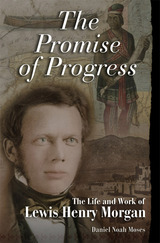 The Promise of Progress: The Life and Work of Lewis Henry Morgan
Daniel Noah Moses
University of Missouri Press, 2009
A pioneering anthropologist, social theorist, railroad lawyer, and advocate for Native Americans, Lewis Henry Morgan was the only American to be cited by Darwin, Marx, and Freud. By many accounts, he was the most influential American social scientist of the nineteenth century. Morgan traced humanity’s progress from life among a primary group to one in an increasingly impersonal civilization—from primitive cave to civilized parlor—and along the way explained the meaning of modernity and the meaning of America. For Morgan, they were one and the same.
Daniel Noah Moses has written the most complete biography of this prominent intellectual to date, tracing his career and documenting in detail his worldwide influence. Although Morgan is best known among anthropologists, Moses reveals to a wider readership his life and accomplishments as an important American thinker who considered the United States the embodiment of the Enlightenment and a model for the world.
Moses presents Morgan’s life in great detail, with facts that will surprise even those who think they know him. From his early work with the Iroquois to his defense of American capitalism to his strange posthumous career among international communists and American leftists, Moses weaves together the diverse strands that made up the rich tapestry of this singular life. He locates Morgan’s American voice within a tradition of transatlantic social theory dedicated to understanding the spirit that motivates modern societies. In showing how Morgan reflected the interplay between Christian, classical, and liberal traditions, Moses delves into the role of such concepts as “savagery,” “barbarism,” the “primitive,” “progress,” and “civilization” in nineteenth-century social theory and in the broader American culture. And he tells how even today Morgan’s influence is felt among environmentalists, anarchists, feminists, and other social visionaries.
Morgan explained how humans evolved beyond nature to both the splendor and squalor of the Industrial Age and offered an unprecedented analysis of the interplay between family, property relations, the state, and the human mind. The Promise of Progress will spark the imagination of anyone who worries that progress has outstripped the human capacity to live together, allowing readers to better understand the relationship between the American emphasis on consumption, the buried riches of the American dream, and the possibilities for our future.
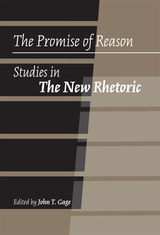 The Promise of Reason: Studies in The New Rhetoric
Edited by John T. Gage
Southern Illinois University Press, 2011 No single work is more responsible for the heightened interest in argumentation and informal reasoning—and their relation to ethics and jurisprudence in the late twentieth century—than Chaïm Perelman and Lucie Olbrechts-Tyteca’s monumental study of argumentation, La Nouvelle Rhétorique: Traité de l'Argumentation. Published in 1958 and translated into English as The New Rhetoric in 1969, this influential volume returned the study of reason to classical concepts of rhetoric. In The Promise of Reason: Studies in The New Rhetoric, leading scholars of rhetoric Barbara Warnick, Jeanne Fahnestock, Alan G. Gross, Ray D. Dearin, and James Crosswhite are joined by prominent and emerging European and American scholars from different disciplines to demonstrate the broad scope and continued relevance of The New Rhetoric more than fifty years after its initial publication.
Divided into four sections—Conceptual Understandings of The New Rhetoric, Extensions of The New Rhetoric, The Ethical Turn in Perelman and The New Rhetoric, and Uses of The New Rhetoric—this insightful volume covers a wide variety of topics. It includes general assessments of The New Rhetoric and its central concepts, as well as applications of those concepts to innovative areas in which argumentation is being studied, such as scientific reasoning, visual media, and literary texts. Additional essays compare Perelman’s ideas with those of other significant thinkers like Kenneth Burke and Richard McKeon, explore his career as a philosopher and activist, and shed new light on Perelman and Olbrechts- Tyteca’s collaboration. Two contributions present new scholarship based on recent access to letters, interviews, and archival materials housed in the Université Libre de Bruxelles. Among the volume’s unique gifts is a personal memoir from Perelman’s daughter, Noémi Perelman Mattis, published here for the first time.
The Promise of Reason, expertly compiled and edited by John T. Gage, is the first to investigate the pedagogical implications of Perelman and Olbrechts- Tyteca’s groundbreaking work and will lead the way to the next generation of argumentation studies.
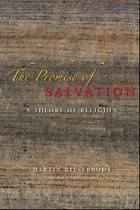 The Promise of Salvation: A Theory of Religion
Martin Riesebrodt
University of Chicago Press, 2010 Why has religion persisted across the course of human history? Secularists have predicted the end of faith for a long time, but religions continue to attract followers. Meanwhile, scholars of religion have expanded their field to such an extent that we lack a basic framework for making sense of the chaos of religious phenomena. To remedy this state of affairs, Martin Riesebrodt here undertakes a task that is at once simple and monumental: to define, understand, and explain religion as a universal concept. Instead of propounding abstract theories, Riesebrodt concentrates on the concrete realities of worship, examining religious holidays, conversion stories, prophetic visions, and life-cycle events. In analyzing these practices, his scope is appropriately broad, taking into consideration traditions in Judaism, Christianity, Islam, Buddhism, Daoism, and Shinto. Ultimately, Riesebrodt argues, all religions promise to avert misfortune, help their followers manage crises, and bring both temporary blessings and eternal salvation. And, as The Promise of Salvation makes clear through abundant empirical evidence, religion will not disappear as long as these promises continue to help people cope with life.
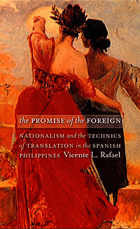 The Promise of the Foreign: Nationalism and the Technics of Translation in the Spanish Philippines
Vicente L. Rafael
Duke University Press, 2005 In The Promise of the Foreign, Vicente L. Rafael argues that translation was key to the emergence of Filipino nationalism in the nineteenth century. Acts of translation entailed technics from which issued the promise of nationhood. Such a promise consisted of revising the heterogeneous and violent origins of the nation by mediating one’s encounter with things foreign while preserving their strangeness. Rafael examines the workings of the foreign in the Filipinos’ fascination with Castilian, the language of the Spanish colonizers. In Castilian, Filipino nationalists saw the possibility of arriving at a lingua franca with which to overcome linguistic, regional, and class differences. Yet they were also keenly aware of the social limits and political hazards of this linguistic fantasy. Through close readings of nationalist newspapers and novels, the vernacular theater, and accounts of the 1896 anticolonial revolution, Rafael traces the deep ambivalence with which elite nationalists and lower-class Filipinos alike regarded Castilian. The widespread belief in the potency of Castilian meant that colonial subjects came in contact with a recurring foreignness within their own language and society. Rafael shows how they sought to tap into this uncanny power, seeing in it both the promise of nationhood and a menace to its realization. Tracing the genesis of this promise and the ramifications of its betrayal, Rafael sheds light on the paradox of nationhood arising from the possibilities and risks of translation. By repeatedly opening borders to the arrival of something other and new, translation compels the nation to host foreign presences to which it invariably finds itself held hostage. While this condition is perhaps common to other nations, Rafael shows how its unfolding in the Philippine colony would come to be claimed by Filipinos, as would the names of the dead and their ghostly emanations.
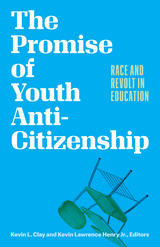 The Promise of Youth Anti-Citizenship: Race and Revolt in Education
Kevin L Clay
University of Minnesota Press, 2024 When inclusion into the fold of citizenship is conditioned by a social group’s conceit to ritual violence, humiliation, and exploitation, what can anti-citizenship offer us?
The Promise of Youth Anti-citizenship argues that Black youth and youth of color have been cast as anti-citizens, disenfranchised from the social, political, and economic mainstream of American life. Instead of asking youth to conform to a larger societal structure undergirded by racial capitalism and antiblackness, the volume’s contributors propose that the collective practice of anti-citizenship opens up a liberatory space for youth to challenge the social order. The chapters cover an array of topics, including Black youth in the charter school experiment in post-Katrina New Orleans; racial capitalism, the queering of ethnicity, and the 1980s Salvadoran migration to South Central Los Angeles; the notion of decolonizing classrooms through Palestinian liberation narratives; and more. Through a range of methodological approaches and conceptual interventions, this collection illuminates how youth negotiate and exercise anti-citizenship as forms of either resistance or refusal in response to coercive patriotism, cultural imperialism, and predatory capitalism. Contributors: Karlyn Adams-Wiggins, Portland State U; Ariana Brazier; Julio Cammarota, U of Arizona; Michael Davis, U of Wisconsin–Madison; Damaris C. Dunn, U of Georgia; Diana Gamez, U of California, Irvine; Rachel F. Gómez, Virginia Commonwealth U; Luma Hasan; Gabriel Rodriguez, Iowa State U; Christopher R. Rogers, U of Pennsylvania; Damien M. Sojoyner, U of California, Irvine.
 Promise to Pay: The Politics and Power of Money in Early America
Katie A. Moore
University of Chicago Press, 2024 An incisive account of the crucial role money played in the formation and development of British North America.
Promise to Pay follows America’s first paper money—the “bills of credit” of British North America—from its seventeenth-century origins as a means of war finance to its pivotal role in catalyzing the American Revolution. Katie A. Moore combs through treasury records, account books, and the bills themselves to tell a new story of money’s origins that challenges economic orthodoxy and mainstream histories. Promise to Pay shows how colonial governments imposed paper bills on settler communities through existing labor and kinship relations, their value secured by thousands of individual claims on the public purse—debts—and the state’s promise to take them back as payment for taxes owed. Born into a world of hierarchy and deference, early American money eroded old social ties and created new asymmetries of power, functioning simultaneously as a ticket to the world of goods, a lifeline for those on the margins, and a tool of imperial domination.
Grounded in sustained engagement with scholarship from multiple disciplines, Promise to Pay breathes new life into old debates and offers an incisive account of the centrality of money in the politics and conflicts of empire, community, and everyday life.
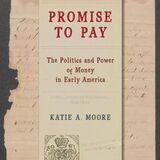 Promise to Pay: The Politics and Power of Money in Early America
Katie A. Moore
University of Chicago Press, 2024 This is an auto-narrated audiobook version of this book.
An incisive account of the crucial role money played in the formation and development of British North America.
Promise to Pay follows America’s first paper money—the “bills of credit” of British North America—from its seventeenth-century origins as a means of war finance to its pivotal role in catalyzing the American Revolution. Katie A. Moore combs through treasury records, account books, and the bills themselves to tell a new story of money’s origins that challenges economic orthodoxy and mainstream histories. Promise to Pay shows how colonial governments imposed paper bills on settler communities through existing labor and kinship relations, their value secured by thousands of individual claims on the public purse—debts—and the state’s promise to take them back as payment for taxes owed. Born into a world of hierarchy and deference, early American money eroded old social ties and created new asymmetries of power, functioning simultaneously as a ticket to the world of goods, a lifeline for those on the margins, and a tool of imperial domination.
Grounded in sustained engagement with scholarship from multiple disciplines, Promise to Pay breathes new life into old debates and offers an incisive account of the centrality of money in the politics and conflicts of empire, community, and everyday life.
The Promised City: New York’s Jews, 1870–1914, Revised Edition
Moses Rischin
Harvard University Press, 1977 Rischin paints a vivid picture of Jewish life in New York at the turn of the century. Here are the old neighborhoods and crowded tenements, the Rester Street markets, the sweatshops, the birth of Yiddish theatre in America, and the founding of important Jewish newspapers and labor movements. The book describes, too, the city's response to this great influx of immigrants—a response that marked the beginning of a new concept of social responsibility.
The Promised Folly
Judith Hall
Northwestern University Press, 2003 If, as Oscar Wilde said, "nothing ages like happiness," then nothing rejuvenates like a pursuit. That is certainly the American way, and in The Promised Folly, Judith Hall takes a fresh look at our American pursuits and supreme fictions. She explores the folly that follows mere existence and gives it back to her readers in different voices-Venus, Walt Whitman, Julius Caesar, Ma Rainey voices that contain multitudes. Whitman will become Falstaff, for example, and Venus becomes Mars. Absurdities and incongruities such as these constitute for Hall opportunities for lyric pleasure. The resulting poems are puckish, sumptuous, and austere, by turns, and not incidentally compassionate.
promised instruments: poems
Kristiana Colón
Northwestern University Press, 2013 Taking its cue from Toni Morrison’s declaration that "language alone protects us from the scariness of things with no names" Kristiana Colón’s promised instruments stitches its own definitions for what is granted, what is surrendered, what is pilfered, and what is reclaimed. Her poems plumb the problem of woman’s sexuality, sexual agency, mental health, and consent with piercing musicality and disarming vulnerability. promised instruments invites its readers to interrogate their own complicity in these issues and share in the healing process.
 A Promised Land, A Perilous Journey: Theological Perspectives on Migration
Daniel G. Groody
University of Notre Dame Press, 2008
A Christian theological interpretation of the border reality is a neglected area of immigration study. The foremost contribution of A Promised Land, A Perilous Journey is its focus on the theological dimension of migration, beginning with the humanity of the immigrant, a child of God and a bearer of his image.
The nineteen authors in this collection recognize that one characteristic of globalization is the movement not only of goods and ideas but also of people. The crossing of geographical borders confronts Christians, as well as all citizens, with choices: between national security and human insecurity; between sovereign national rights and human rights; between citizenship and discipleship. Bearing these global dimensions in mind, the essays in this book focus on the particular problems of immigration across the U.S.-Mexico border. The contributors to this volume include scholars as well as pastors and lay people involved in immigration aid work. Daniel Groody has also produced a documentary on immigration, “Dying to Live.”
“A Promised Land, A Perilous Journey offers a rich, interdisciplinary treatment of the subject of migration, showing the human face of contemporary migration as a global phenomenon. The authors explore historical antecedents in Biblical and early church history, the political debates about borders and the right to migrate, and the role of race, ethnicity, and gender in the ‘perilous journey’ of migrants. This is an indispensable text for all interested in the theology of migration and the ethics of migration policy.” —William O’Neill, S.J., Jesuit School of Theology, Berkeley
“At times saddening, at times inspiring, A Promised Land, A Perilous Journey, brings fresh perspectives to the discussion of immigration. These essays reach beyond the policy debate and the heated emotions of the moment and provide much needed reflection on larger truths.” —Roberto Suro, University of Southern California
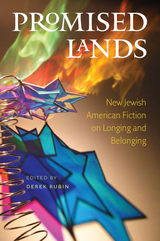 Promised Lands
Edited by Derek Rubin
Brandeis University Press, 2010 This vibrant anthology showcases new, unpublished short stories by a rapidly growing crop of highly talented young Jewish American fiction writers. Cohering around the core Jewish theme of the Promised Land, all the stories were written especially for this volume. With the kind of depth and imagination that only fiction allows, they offer striking variations on the multivalent theme of the Promised Land and how it continues to shape the collective consciousness of contemporary American Jews. This anthology provides a rich reading experience and a unique window onto Jewish American life and culture at the beginning of the twenty-first century. A scholarly introduction by Derek Rubin provides literary context, discusses the organization of the volume, and illuminates expected and unexpected connections among the stories. Promised Lands features 23 stories by Elisa Albert, Melvin Jules Bukiet, Janice Eidus, Rebecca Newberger Goldstein, Lauren Grodstein, Aaron Hamburger, Dara Horn, Rachel Kadish, Binnie Kirshenbaum, Joan Leegant, Yael Goldstein Love, Rivka Lovett, Tova Mirvis, Lev Raphael, Nessa Rapoport, Jonathan Rosen, Thane Rosenbaum, Joey Rubin, Edward Schwarzschild, Steve Stern, Lara Vapnyar, Adam Wilson, and Jonathan Wilson.
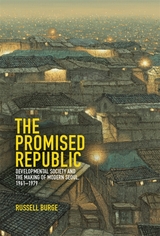 The Promised Republic: Developmental Society and the Making of Modern Seoul, 1961–1979
Russell Burge
Harvard University Press In The Promised Republic, Russell Burge offers a bold new history of South Korea’s rapid development. By focusing on the experience of rural-to-urban migrants who built and lived in Seoul’s shantytowns, Burge historicizes national development as a site of struggle with the urban poor at its center. What would a society of postcolonial abundance look like? Who was this society built for, and how would access to the city that formed its economic center be claimed and defended? These were the questions at stake in the urban struggles of the 1960s and 1970s, an era when authorities found themselves caught between a mandate to create well-disciplined cities and the promise of broad uplift that legitimated their leadership. Utilizing memoirs, interviews, newspapers, journals, photographs, literature, anthropological records, and critical as well as official sources, Burge reconstructs a not-altogether-vanished world and provides historical background of conflicts over urban access and inequality that continue to enrage and resonate to this day.
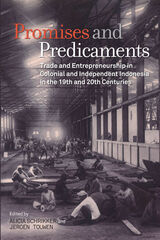 Promises and Predicaments: Trade and Entrepreneurship in Colonial and Independent Indonesia in the 19th and 20th Centuries
Edited by Alicia Schrikker and Jeroen Touwen
National University of Singapore Press, 2015 Indonesia’s trajectory towards successful economic growth has been long and capricious. Studies of the process often focus either on the Netherlands Indies or independent Indonesia, suggesting the existence of fundamental discontinuities. The authors of the 17 essays in this book adopt a long-term perspective that transcends regimes and bridges dualist economic models in order to examine what did and did not change as the country moved across the colonial-postcolonial divide, and shifted from reliance on exports of primary products to a multi-centred economy. The aim is to analyse how economic development grew out of the interplay of foreign trade, new forms of entrepreneurship and the political economy.
The authors deal with entrepreneurship and economic specialization within different ethnic groups, the geographical distribution of exports and resource drains from exporting regions, and connections between an export economy and mass poverty. One recurring issue is the way actors from different ethnic groups occupied complementary niches, highlighting the rich variety of roles played by Asian entrepreneurs. A study of the international sugar trade shows how regime change fostered co-operation between different ethnic groups and nationalities involved with trading networks, inter-island shipping, urban public transport, and the construction sector. A comparison of export earnings and population groups involved in trade before and after 1900 shows that unexpected agricultural and industrial transitions could underpin a fundamental shift in income growth, with improved living standards for broad sectors of the population.
 Promises Beyond Memory: Archives, Art, and the Afterlives of Violence in Latin America
Vikki Bell
Duke University Press, 2026 In Promises Beyond Memory, Vikki Bell shows how archives of contemporary political violence in Argentina, Chile, and Colombia challenge the idea that simply sheltering the documentation of violence is sufficient to fulfill the obligations of attending to the past. Beyond mere preservation, these archives, museums, and sites of memory invite exploratory modes of enlivening the past through aesthetic practices like photography, installation, film, and performance. These practices foster the “survivance” of memory where populations still grapple with legacies of violence and often state-sponsored mass disappearance and torture. Rather than produce a definitive account of the past, such survivance facilitates polyvocal articulations that open deeply political and ethical questions around contested histories. They may even create moments for what Bell terms “tender forgetting”—the ability to remember without reawakening trauma. Integrating theory, extensive archival work, and interviews with artists, archivists, museum workers, and survivors of state violence, Bell analyses the creative ways that archives pass on stories of violence as they seek to defend against attempts to rewrite the past.
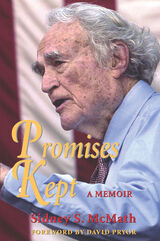 Promises Kept: A Memoir
Sidney S. McMath
University of Arkansas Press, 2003 Winner of the 2006 Booker Worthen Literary Prize and the 2004 Ragsdale Award. Sidney Sanders McMath was a pivotal figure not only in Arkansas history but in the history of the Democratic Party and of American law. Still vibrant and engaged in his nineties, he sets out his story in full for the first time: how he rose and fell in public office, and rose again as a lawyer seeking justice for ordinary people. McMath divides his story into four parts. In the first, he describes how his early life in rural Arkansas sparked his commitment to people. The second section describes his service to democracy in the military, including his commission in the U.S. Marines, a battlefield promotion in the Pacific and other honors, and his subsequent advancement to the rank of major general. The revealing third section details McMath’s extraordinary life in politics, starting with his explosive debut in 1945, when he and other recent veterans dethroned one of Arkansas’s most powerful and corrupt political machines. Later, as a two-term governor, he fulfilled this promise of reform and modernization: he brought the first roads and electricity to rural areas, fought the poll tax, and built the state’s first medical center. He also helped change the party’s rules so that black citizens could vote in primaries. McMath describes how he worked with President Truman to keep the segregationist Dixiecrats from taking over the Democratic Party—and the presidency. But here his story takes a dramatic turn: political opponents alleged bribery in his highway program, and although no indictments were handed down, McMath’s political career ended. Arguing his case for the first time in fifty years, he sets the facts straight. McMath turned to the practice of law to fight for the people he had represented as governor. In the concluding section of the book he describes some of his most important cases, examples of how he put his life’s experience, knowledge, and integrity in the service of those who had few resources. These stories show exactly why he has been honored with membership in such exclusive groups as the Inner Circle of Advocates as well as the presidency of the International Academy of Trial Lawyers. Promises Kept shows us the excitement and the hard choices of real democracy, offering compelling human stories, new information on past conflicts, and the crucial perspective of a man at the center of history.
 Promises of 1968: Crisis, Illusion and Utopia
Vladimir Tismaneanu
Central European University Press, 2011 This book is a state of the art reassessment of the significance and consequences of the events associated with the year 1968 in Europe and in North America. Since 1998, there hasn't been any collective, comparative and interdisciplinary effort to discuss 1968 in the light of both contemporary headways of scholarship and new evidence on this historical period. A significant departure from earlier approaches lies in the fact that the manuscript is constructed in unitary fashion, as it goes beyond the East–West divide, trying to identify the common features of the sixties. The latter are analyzed as simultaneously global and local developments. The main problems addressed by the contributors of this volume are: the sixties as a generational clash; the redefinition of the political as a consequence of the ideological challenges posed to the status-quo by the sixty-eighters; the role of Utopia and the de-radicalization of intellectuals; the challenges to imperialism (Soviet/American); the cultural revolution of the sixties; the crisis of 'really existing socialism' and the failure of "socialism with a human face"; the gradual departure from the Yalta-system; the development of a culture of human rights and the project of a global civil society; the situation of 1968 within the general evolution of European history (esp. the relationship of 1968 with 1989). In contrast to existing books, it provides a fundamental and unique synthesis of approaches on 1968: first, it contains critical (vs. nostalgic) re-evaluations of the events from the part of significant sixty-eighters; second, it includes historical analyses based on new archival research; third, it gathers important theoretical re-assessments of the intellectual history of the 1968; and fourth, it bridges 1968 with its aftermath and its pre-history, thus avoiding an over-contextualization of the topics in question.
Promising
William Vitek
Temple University Press, 1993 William Vitek enlarges our understanding by treating the act of promising as a social practice and complex human experience. Citing engaging examples of promises made in everyday life, in extraordinary circumstances, and in literary works, Vitek grapples with the central paradox of promising: that human beings can intend a future to which they are largely blind. Promising evaluates contemporary approaches to the topic by such philosophers as John Rawls, John Searle, Henry Sidgwick, P.S. Atiyah, and Michael Robbins but transcend their more limited focus on promissory obligation. Vitek's innovative approach moves beyond theories of language, ethics, and law to unveil a complex human activity subject to shifting interpretations and changes in nature.
 A Promising Problem: The New Chicana/o History
Edited by Carlos Kevin Blanton
University of Texas Press, 2016 Chicana/o history has reached an intriguing juncture. While academic and intellectual studies are embracing new, highly nuanced perspectives on race, class, gender, education, identity, and community, the field itself continues to be viewed as a battleground, subject to attacks from outside academia by those who claim that the discipline promotes racial hatred and anti-Americanism. Against a backdrop of deportations and voter suppression targeting Latinos, A Promising Problem presents the optimistic voices of scholars who call for sophisticated solutions while embracing transnationalism and the reality of multiple, overlapping identities. Showcasing a variety of new directions, this anthology spans topics such as growth and reassessment in Chicana/o history manifested in a disruption of nationalism and geographic essentialism, the impact of legal history, interracial relations and the experiences of Latino subpopulations in the US South, race and the politics of religious history, transborder feminism in the early twentieth century, and aspirations for a field that increasingly demonstrates the relational dynamics of cultural production. As they reflect on the state of their field, the contributors offer significant insights into sociology, psychology, anthropology, political science, education, and literature, while tracing the history of activism throughout the last century and debating the very concepts of “Chicano” and “Chicano history.” Although the political landscape is fraught with closed-off rhetoric, A Promising Problem encourages diversity of thought and opens the possibilities of historical imagination.
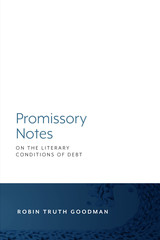 Promissory Notes: On the Literary Conditions of Debt
Robin Truth Goodman
Lever Press, 2018 There is no doubt that the beginning of the twenty-first century was marked by crises of debt. Less well known is that literature played a historical role in defining and teaching debt to the public. Promissory Notes: On the Literary Conditions of Debt addresses how neoliberal finance has depended upon a historical linking of geopolitical inequality and financial representation that positions the so-called “Third World” as negative value, or debt. Starting with an analysis of Anthony Trollope’s novel, The Eustace Diamonds, Goodman shows how colonized spaces came to inhabit this negative value. Promissory Notes argues that the twentieth-century continues to apply literary innovations in character, subjectivity, temporal and spatial representation to construct debt as the negative creation of value not only in reference to objects, but also houses, credit cards, students, and, in particular, “Third World” geographies, often leading to crisis. Yet, late twentieth century and early twenty-first literary texts, such as Soyinka’s The Road and Ngugi’s Wizard of the Crow, address the negative space of the indebted world also as a critique of the financial take-over of the postcolonial developmental state. Looking to situations like the Puerto Rican debt crisis, Goodman demonstrates how financial discourse is articulated through social inequalities and how literature can both expose and contest the imposition of a morality of debt as a mode of anti-democratic control.
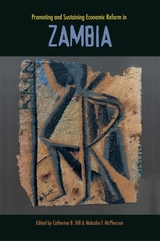 Promoting and Sustaining Economic Reform in Zambia
Catharine B. Hill
Harvard University Press This collection of essays examines Zambia’s efforts to promote economic reform during the 1990s. Following the restoration of democratic rule, the government of Zambia adopted an ambitious program designed to stabilize the economy and lay the foundation for sustained growth and development. These essays describe the adjustment program, highlighting the attempts to reform the budget, the tax system, the financial system, agriculture and mining, and to create the human capacity to sustain the reforms.
Major improvements in economic performance occurred from 1992 to 1995. After that, however, economic performance deteriorated as a result of the government’s selective abandonment of key elements of the reform program and the emergence of major governance problems. In response to international pressure, by 2001 the government completed the sale of the copper mines and qualified for large-scale debt relief. The long delays involved seriously undermined economic performance.
The volume concludes that for economic reform to succeed in Zambia, the government should scale back its development agenda to match its financial and human capacities, reduce dependence on foreign aid, adopt and maintain prudent macroeconomic policies, and support the expansion of both mining and agriculture.
 Promoting Healthy Behavior: How Much Freedom? Whose Responsibility?
Daniel Callahan, Editor
Georgetown University Press The government, the media, HMOs, and individual Americans have all embraced programs to promote disease prevention. Yet obesity is up, exercise is down, teenagers continue to smoke, and sexually transmitted disease is rampant. Why? These intriguing essays examine the ethical and social problems that create subtle obstacles to changing Americans' unhealthy behavior. The contributors raise profound questions about the role of the state or employers in trying to change health-related behavior, about the actual health and economic benefits of even trying, and about the freedom and responsibility of those of us who, as citizens, will be the target of such efforts. They ask, for instance, whether we are all equally free to live healthy lives or whether social and economic conditions make a difference. Do disease prevention programs actually save money, as is commonly argued? What is the moral legitimacy of using economic and other incentives to change people's behavior, especially when (as with HMOs) the goal is to control costs? One key issue explored throughout the book is the fundamental ambivalence of traditionally libertarian Americans about health promotion programs: we like the idea of good health, but we do not want government or others posing threats to our personal lifestyle choices. The contributors argue that such programs will continue to prove less than wholly successful without a fuller examination of their place in our national values.
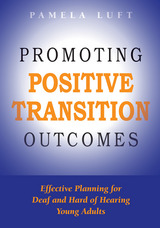 Promoting Positive Transition Outcomes: Effective Planning for Deaf and Hard of Hearing Young Adults
Pamela Luft
Gallaudet University Press, 2016 Many students struggle with the transition from high school to the next stage of their lives. For deaf and hard of hearing (DHH) students, that struggle can be intensified by barriers and discriminatory attitudes they face in their communities, schools, and workplaces. Though much progress has been made, they are often underemployed and underpaid, and they receive postsecondary training at lower rates than other disability groups. Author Pamela Luft explores the reasons for these statistics and offers strategies and resources that can improve outcomes.
Promoting Positive Transition Outcomes is the most comprehensive discussion of transition planning and results for DHH students now available. Luft begins with an overview of the historical and current challenges to DHH students and their academic and vocational potential. She explores the importance of forming an identity and building foundational social and problem-solving skills. She then reviews the history of rehabilitation and workforce legislation, which now mandates that every student with an individualized education plan (IEP) have a transition plan in place by the age of 16. Most schools, however, are not equipped to meet the needs of a population as diverse as DHH students. She examines the services that are currently available in high schools and offers recommendations for strengthening transition team planning by reaching out to external experts. The volume concludes with suggestions for creating a framework to address the challenges of transition planning for deaf and hard of hearing students and offers guidance on building effective plans.
Promoting the Saints: Cults and Their Contexts from Late Antiquity until the Early Modern Period
Ottó Gecser
Central European University Press, 2010 The studies in this volume concentrate on a complex set of socio-cultural phenomena, the cult of saints, in a variety of regions from Egypt to Poland, with a focus on Italy and Central Europe. The subjects of the contributions range in time from the fourth until the eighteenth century. The diversity of approaches adopted by the contributors—from literary analysis and historical anthropology to archaeology and art history—represents that open and multidisciplinary historical research that characterizes the work of Gábor Klaniczay to whom these essays are dedicated.
Promotion and Control of Industry in Postwar France
John Sheahan
Harvard University Press John Sheahan discusses the spectacular improvement in French economic performance, in the course of which the industries of France have gained rapidly on those of the United States and England. Stressing consequences of planning, competition, price regulation, and nationalization in the steel, auto, aluminum, textile, and machinery industries, the author recognizes troublesome aspects in French policy but maintains that, despite some mistakes, France has evolved an intelligently directed industrial effort, creating many of its own advantages. In conclusion, he discusses the country's prospects including the possible effects of various future policies.
 Promotion and Tenure Confidential
David D. Perlmutter
Harvard University Press, 2010 “Sitting down with a young and brilliant mathematician, I asked what he thought were his biggest problems in working toward tenure. Instead of describing difficulties with his equations or his software programs, he lamented that (a) his graduate assistant wasn’t completing his tasks on time, (b) his department chair didn’t seem to care if junior faculty obtained grants, and (c) a senior professor kept glaring at him in faculty meetings. He knew he could handle the intellectual side of being an academic—but what about the people side? ‘Why didn’t they offer “Being a Professor 101” in graduate school?’ he wondered.”
Promotion and Tenure Confidential provides that course in an astute and practical book, which shows that P&T is not just about research, teaching, and service but also about human relations and political good sense. Drawing on research and extensive interviews with junior and senior faculty across many institutions, David D. Perlmutter provides clear-sighted guidance on planning and managing an academic career, from graduate school to tenure and beyond.
Topics include:
— Making the transformation from student and protégé to teacher and mentor
— Seeking out and holding onto lifelong allies
— How to manage your online reputation and avoid “death by Google”
— What to say and what not to say to deans and department chairs
— How meeting deadlines wins points with everyone in your life
— How, when, and to whom to say “no”
— When and how to look for a new job when you have a job
— How (and whom) to ask for letters of recommendation
— What to do if you know you’re not going to get tenure
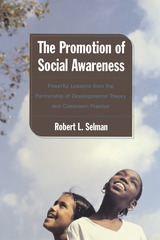 Promotion of Social Awareness: Powerful Lessons for the Partnership of Developmental Theory and
Robert L. Selman
Russell Sage Foundation, 2003 Education specialists have written volumes on the best ways to help children learn to read and write, but who is helping them navigate the potentially treacherous waters of social interactions? While in school to study, children are also preoccupied with understanding the rules governing social relationships. Issues of trust and loyalty, rivalry and conflict, belonging and exclusion affect all school-aged children, but very few lesson plans include social development skills. The Promotion of Social Awareness summarizes thirty years of research on the social development of children in elementary and middle school, and shows how this work has led to a series of programs that promote the social competence of children and adolescents. Rich with lessons drawn from real life, the book includes an in-depth account of the author's partnership with an innovative program designed to help educators promote a sound ethic of social relationships among children, a case study of a teacher particularly gifted at promoting such relationships, and the tale of how the author's theoretical framework fared cross-culturally when exported to Iceland. The Promotion of Social Awareness documents Robert Selman's efforts both as a practitioner trying to help young people develop their interpersonal skills and as a researcher attempting to understand the factors that promote or hinder social development. Selman believes that getting along with others involves concrete and measurable social skills and actions that can be taught. The book underlines how the science of social development has given rise to initiatives and programs that can be used in educational settings to help children get along with each other, and may in the long run help prevent violence, drug abuse, and prejudice. Unique in its marriage of theory and practice, The Promotion of Social Awareness will appeal to a wide readership, including developmental psychologists, educators, and parents.
 Pronghorn: Ecology & Mangemt: Ecology and Management
Bart W. O'Gara
University Press of Colorado, 2004 One of the fastest land animals on Earth (second only to the cheetah), the pronghorn can reach speeds of more than 50 miles per hour. It also is one of the most fascinating of all animals. For many people, the pronghorn was nearly as much a symbol of the American West as was the bison; for some, it still is. Eliminated from much of its historic range by the early 1900s, this unique North American big game species has experienced a remarkable recovery and now is found throughout the western United States, Canada, and northern Mexico. Thirty years in the making, Pronghorn: Ecology and Management contains the most comprehensive information on the behavior, physiology, migration, taxonomy, and management of this extraordinary animal.
Full chapters are devoted to distribution, nutrition and food, diseases and parasites, ecosystem management, hunting, and much more. The principal authors—the world’s preeminent pronghorn biologists, Bart W. O’Gara and Jim D. Yoakum—conclude with a thorough discussion of the future of pronghorn and their management. With 23 chapters that include contributions by 10 other wildlife professionals and more than 850 illustrations, including original artwork by Edson Fichter and Daniel P. Metz, Pronghorn: Ecology and Management is the definitive work on the species.
A Wildlife Management Institute Book
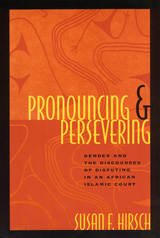 Pronouncing and Persevering: Gender and the Discourses of Disputing in an African Islamic Court
Susan F. Hirsch
University of Chicago Press, 1998 The title of Susan Hirsch's study of disputes involving Swahili Muslims in coastal Kenya reflects the image of gender relations most commonly associated with Islamic law. Men need only "pronounce" divorce to resolve marital conflicts, while embattled and embittered wives must persevere by silently enduring marital hardships. But Hirsch's observations of Islamic courts uncover how Muslim women actively use legal processes to transform their domestic lives, achieving victories on some fronts but reinforcing their image as subordinate to men through the speech they produce in court.
Pronouncing and Persevering focuses closely on the language used in disputes, particularly how men and women narrate their claims and how their speech shapes and is shaped by gender hierarchy in postcolonial Swahili society. Based on field research and court testimony, Hirsch's book debunks the conventional view that women are powerless under Islamic law and challenges the dichotomies through which Islam and gender relations are currently understood.
 Pronouncing English: A Stress-Based Approach with CD-ROM
Richard V. Teschner and M. Stanley Whitley
Georgetown University Press, 2004 Pronouncing English is a textbook for teaching English phonetics and phonology, offering an original "stress-based" approach while incorporating all the standard course topics. Drawing on current linguistic theory, it uniquely analyzes prosody first, and then discusses its effects on pronunciation—emphasizing suprasegmental features such as meter, stress, and intonation, then the vowels and consonants themselves. Distinguished by being the first work of its kind to be based on an exhaustive statistical analysis of all the lexical entries of an entire dictionary, Pronouncing English is complemented by a list of symbols and a glossary. Richard Teschner and M. Stanley Whitley present an improved description of English pronunciation and conclude each chapter with suggestions on how to do a better job of teaching it. An appendix with a brief introduction to acoustic phonetics—the basis for the perception vs. the production of sounds—is also included. Revolutionary in its field, Pronouncing English declares that virtually all aspects of English pronunciation—from the vowel system to the articulation of syllables, words, and sentences—are determined by the presence or absence of stress. The accompanying CD-ROM carries audio recordings of many of the volume's exercises, more than 100 text and sound files, and data files on which the statistical observations were based.
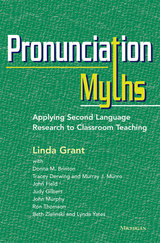 Pronunciation Myths: Applying Second Language Research to Classroom Teaching
Linda Grant with Donna M. Brinton, Tracey Derwing and Murray J. Munro, John Field, Judy Gilbert, John Murphy, Ron Thomson, Beth Zielinski and Lynda Yates
University of Michigan Press, 2014 This volume was conceived as a "best practices" resource for pronunciation and speaking teachers in the way that Vocabulary Myths by Keith S. Folse is one for reading and vocabulary teachers. Like others in the Myths series, this book combines research with good pedagogical practices. The book opens with a Prologue by Linda Grant (author of the Well Said textbook series), which reviews the last four decades of pronunciation teaching, the differences between accent and intelligibility, the rudiments of the English sound system, and other factors related to the ways that pronunciation is learned and taught. The myths challenged in this book are: § Once you’ve been speaking a second language for years, it’s too late to change your pronunciation. (Derwing and Munro) § Pronunciation instruction is not appropriate for beginning-level learners. (Zielinski and Yates) § Pronunciation teaching has to establish in the minds of language learners a set of distinct consonant and vowel sounds. (Field) § Intonation is hard to teach. (Gilbert) § Students would make better progress if they just practiced more. (Grant) § Accent reduction and pronunciation instruction are the same thing. (Thomson) § Teacher training programs provide adequate preparation in how to teach pronunciation (Murphy). The book concludes with an Epilogue by Donna M. Brinton, who synthesizes some of the best practices explored in the volume.
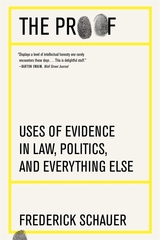 The Proof: Uses of Evidence in Law, Politics, and Everything Else
Frederick Schauer
Harvard University Press, 2022 Winner of the Scribes Book Award
“Displays a level of intellectual honesty one rarely encounters these days…This is delightful stuff.”
—Barton Swaim, Wall Street Journal
“At a time when the concept of truth itself is in trouble, this lively and accessible account provides vivid and deep analysis of the practices addressing what is reliably true in law, science, history, and ordinary life. The Proof offers both timely and enduring insights.”
—Martha Minow, former Dean of Harvard Law School
“His essential argument is that in assessing evidence, we need, first of all, to recognize that evidence comes in degrees…and that probability, the likelihood that the evidence or testimony is accurate, matters.”
—Steven Mintz, Inside Higher Education
“I would make Proof one of a handful of books that all incoming law students should read…Essential and timely.”
—Emily R. D. Murphy, Law and Society Review
In the age of fake news, trust and truth are hard to come by. Blatantly and shamelessly, public figures deceive us by abusing what sounds like evidence. To help us navigate this polarized world awash in misinformation, preeminent legal theorist Frederick Schauer proposes a much-needed corrective.
How we know what we think we know is largely a matter of how we weigh the evidence. But evidence is no simple thing. Law, science, public and private decision making—all rely on different standards of evidence. From vaccine and food safety to claims of election fraud, the reliability of experts and eyewitnesses to climate science, The Proof develops fresh insights into the challenge of reaching the truth. Schauer reveals how to reason more effectively in everyday life, shows why people often reason poorly, and makes the case that evidence is not just a matter of legal rules, it is the cornerstone of judgment.
 Proof-of-Stake for Blockchain Networks: Fundamentals, challenges and approaches
Cong T. Nguyen
The Institution of Engineering and Technology, 2024 A consensus mechanism is the core component of a blockchain network, which ensures that every participant agrees on the state of the network in trustless environments. Until now, current blockchain networks have been using the proof-of-work (PoW) consensus mechanism, which has serious limitations such as huge energy consumption, low transaction processing capabilities, and centralization and scalability issues. To overcome these problems, a new consensus mechanism entitled proof-of-stake (PoS) has been developed. PoS has many advantages, including negligible energy consumption and very low consensus delay. Ethereum (the largest decentralized global software platform to create secured digital technology powered by blockchain technology and the blockchain of choice globally for all developers and enterprises) has just switched from PoW to PoS. As a result, this mechanism is expected to become a cutting-edge technology for future blockchain networks.
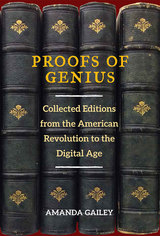 Proofs of Genius: Collected Editions from the American Revolution to the Digital Age
Amanda Gailey
University of Michigan Press, 2015 Proofs of Genius: Collected Editions from the American Revolution to the Digital Age is the first extensive study of the collected edition as an editorial genre within American literary history. Unlike editions of an author’s “selected works” or thematic anthologies, which clearly indicate the presence of non-authorial editorial intervention, collected editions have typically been arranged to imply an unmediated documentary completeness. By design, the collected edition obscures its own role in shaping the cultural reception of the author. In Proofs of Genius, Amanda Gailey argues that decisions to re-edit major authorial corpora are acts of canon-formation in miniature that indicate more foundational shifts in the way a culture views its literature and itself. By combining a theoretically-informed approach with a broad historical view of collected editions from the late eighteenth century to the present (including the rise of digital editions), Gailey fills a gap in the textual scholarship of the editing history of major figures like Emily Dickinson and Walt Whitman and of the American literary canon itself.
 Propaganda and Aesthetics: The Literary Politics of Afro-American Magazines in the Twentieth Century
Abby Arthur Johnson
University of Massachusetts Press, 1979 The literary materials in Afro-American magazines of the twentieth century weave into a rich narrative. The journals provide insight, not available in a comparable manner elsewhere, into the evolution of Afro-American literature. They trace the contributions made by major figures, including W.E.B. Du Bois, Langston Hughes, Charles S. Johnson, Alain Locke, and Richard Wright, among several others. They record the discussions over art and propaganda which have been long prominent in black literature. Decade by decade, black artists and intellectuals have debated the function of Afro-American literature: should it serve the aesthetic tastes of the individual writer, or should it advance the interests of Afro-Americans as a group. Some writers favored art-for-art's sake, or approximations of that emphasis; others articulated the need for art-for-people's sake, as they termed it.
Little work has been done on individual Afro-American periodicals and nothing, up to this point, has been published on twentieth-century black journals as a group. Studies of magazines in general are relatively rare, with only The Little Magazine, by Frederick Hoffman, Charles Allen, and Carolyn P. Ulrich, attempting a survey of small journals in this century. This book fills a considerable gap in literary history by detailing the development of Afro-American magazines in this century.
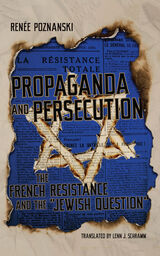 Propaganda and Persecution
Renée Poznanski
University of Wisconsin Press, 2024 Renée Poznanski’s magisterial history of the French Resistance during World War II offers a comprehensive exploration of the most significant issue in that period’s social imaginary: the “Jewish question.” With extraordinary nuance, she analyzes the discourse around Jews and Judaism that pervaded the Resistance’s propaganda and debates, while closely examining the fate of Jews under Vichy and after.
Poznanski argues that Jews in France suffered a double persecution: one led by the Vichy government, the other imposed by the Nazis. Marginalization and exclusion soon led to internment and deportation to terrifying places. Meanwhile, a propaganda war developed between the Resistance and the official voice of Vichy. Poznanski draws on a breathtaking array of sources, especially clandestine publications and French-language BBC transmissions, to show how the Resistance both fought and accommodated the deeply entrenched antisemitism within French society. Her close readings of propaganda texts against public opinions probe ambiguities and silences in Resistance writing about the persecution of the Jews and, in parallel, the numerous and detailed denunciations that could be read in the Jewish clandestine press. This extensive synthesis extends to the post-Liberation period, during which the ongoing persecution of Jews in Europe and North Africa would be portrayed as secondary to the suffering of the nation.
The winner of the 2009 Henri Hertz Prize by the Chancellerie des Universités de Paris, Sorbonne, Propaganda and Persecution makes major contributions to the study of the Resistance and of antisemitism. Lenn J. Schramm’s English translation brings Poznanski’s dynamic prose to life.
 Propaganda and Promotional Activities: An Annotated Bibliography
Harold Lasswell
University of Minnesota Press, 1935 Propaganda and Promotional Activities: An Annotated Bibliography was first published in 1935. Minnesota Archive Editions uses digital technology to make long-unavailable books once again accessible, and are published unaltered from the original University of Minnesota Press editions.Every aspect of the subject of propaganda, or the “manipulation of collective responses,” is covered in the forty-five hundred titles listed in this exceptionally useful reference book. Included in the bibliography are books, pamphlets, and articles, many in foreign languages, dealing with the following topics:1. The aims and methods of propaganda in the fields of politics and government, international relations, business and the professions, public and private finance, labor and agriculture, religion and morals, education, and social reform.2. The media used in the dissemination of propaganda: the newspaper, the periodical, and the graphic arts; the radio; the press agent, the public relations counselor, and the advertising agency; the stage and screen; the lecture platform, the salon, and the tavern; the public fair, exposition, and museum.3. The effectiveness of the various propagandist methods.4. The function and regulation of propaganda in modern society.The volume opens with an essay by Professor Laswell on “The Study and Practice of Propaganda.” Complete subject and author indexes are also included.
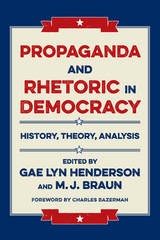 Propaganda and Rhetoric in Democracy: History, Theory, Analysis
Edited by Gae Lyn Henderson and M. J. Braun Foreword by Charles Bazerman
Southern Illinois University Press, 2016 The study of propaganda’s uses in modern democracy highlights important theoretical questions about normative rhetorical practices. Is rhetoric ethically neutral? Is propaganda? How can facticity, accuracy, and truth be determined? Do any circumstances justify misrepresentation? Edited by Gae Lyn Henderson and M. J. Braun, Propaganda and Rhetoric in Democracy: History, Theory, Analysis advances our understanding of propaganda and rhetoric. Essays focus on historical figures—Edward Bernays, Jane Addams, Kenneth Burke, and Elizabeth Bowen—examining the development of the theory of propaganda during the rise of industrialism and the later changes of a mass-mediated society. Modeling a variety of approaches, case studies in the book consider contemporary propaganda and analyze the means and methods of propaganda production and distribution, including broadcast news, rumor production and globalized multimedia, political party manifestos, and university public relations.
Propaganda and Rhetoric in Democracy offers new perspectives on the history of propaganda, explores how it has evolved during the twentieth and twenty-first centuries, and advances a much more nuanced understanding of what it means to call discourse propaganda.
 Propaganda Blitz: How the Corporate Media Distort Reality
David Edwards and David Cromwell
Pluto Press, 2018 Do you trust the liberal media? While the tabloid and right-wing press - the Sun, The Times, the Mail and the Express - are constantly criticised for dangerous bias, outlets like the BBC and the Guardian are trusted by their readers to report in the interests of the public. However, the reality is that all corporate media is systematically filtered by the powerful interests that own, manage and fund it.
Propaganda Blitz shows that the corporate media does not just 'spin' the news - it fundamentally distorts everything it touches, hiding the real issues from public view, and often completely reversing the truth. This book uncovers a storm of top-down campaigns behind war reporting from Iraq, Syria and Palestine, as well as the destruction of the credibility of figures on the left, including Jeremy Corbyn and Hugo Chavez.
Exposing propagandists at the top levels of the BBC, as well as their reporting on the Scottish independence referendum, the dismantling of the NHS and looming climate chaos, Propaganda Blitz explains the real meaning of 'objective' journalism, exposes the fake news about 'fake news' and outlines a model for anti-business media activism.
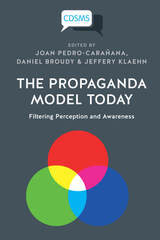 The Propaganda Model Today: Filtering Perception and Awareness
Joan Pedro-Carañana, Daniel Broudy and Jeffery Klaehn
University of Westminster Press, 2018 While the individual elements of the propaganda system (or filters) identified by the Propaganda Model (PM) – ownership, advertising, sources, flak and anti-communism – have previously been the focus of much scholarly attention, their systematisation in a model, empirical corroboration and historicisation have made the PM a useful tool for media analysis across cultural and geographical boundaries. Despite the wealth of scholarly research Herman and Chomsky’s work has set into motion over the past decades, the PM has been subjected to marginalisation, poorly informed critiques and misrepresentations. Interestingly, while the PM enables researchers to form discerning predictions as regards corporate media performance, Herman and Chomsky had further predicted that the PM itself would meet with such marginalisation and contempt. In current theoretical and empirical studies of mass media performance, uses of the PM continue, nonetheless, to yield important insights into the workings of political and economic power in society, due in large measure to the model’s considerable explanatory power.
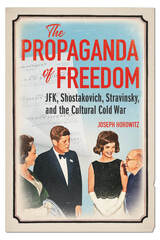 The Propaganda of Freedom: JFK, Shostakovich, Stravinsky, and the Cultural Cold War
Joseph Horowitz
University of Illinois Press, 2023 The perils of equating notions of freedom with artistic vitality Eloquently extolled by President John F. Kennedy, the idea that only artists in free societies can produce great art became a bedrock assumption of the Cold War. That this conviction defied centuries of historical evidence--to say nothing of achievements within the Soviet Union--failed to impact impregnable cultural Cold War doctrine. Joseph Horowitz writes: “That so many fine minds could have cheapened freedom by over-praising it, turning it into a reductionist propaganda mantra, is one measure of the intellectual cost of the Cold War.” He shows how the efforts of the CIA-funded Congress for Cultural Freedom were distorted by an anti-totalitarian “psychology of exile” traceable to its secretary general, the displaced Russian aristocrat/composer Nicolas Nabokov, and to Nabokov’s hero Igor Stravinsky. In counterpoint, Horowitz investigates personal, social, and political factors that actually shape the creative act. He here focuses on Stravinsky, who in Los Angeles experienced a “freedom not to matter,” and Dmitri Shostakovich, who was both victim and beneficiary of Soviet cultural policies. He also takes a fresh look at cultural exchange and explores paradoxical similarities and differences framing the popularization of classical music in the Soviet Union and the United States. In closing, he assesses the Kennedy administration’s arts advocacy initiatives and their pertinence to today’s fraught American national identity. Challenging long-entrenched myths, The Propaganda of Freedom newly explores the tangled relationship between the ideology of freedom and ideals of cultural achievement.
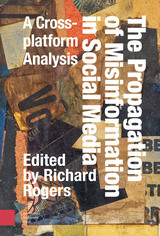 The Propagation of Misinformation in Social Media: A Cross-platform Analysis
Richard Rogers
Amsterdam University Press, 2023 There is growing awareness about how social media circulate extreme viewpoints and turn up the temperature of public debate. Posts that exhibit agitation garner disproportionate engagement. Within this clamour, fringe sources and viewpoints are mainstreaming, and mainstream media are marginalized. This book takes up the mainstreaming of the fringe and the marginalization of the mainstream. In a cross-platform analysis of Google Web Search, Facebook, YouTube, Reddit, Twitter, Instagram, 4chan and TikTok, we found that hyperpartisan web operators, alternative influencers and ambivalent commentators are in ascendency. The book can be read as a form of platform criticism. It puts on display the current state of information online, noting how social media platforms have taken on the mantle of accidental authorities, privileging their own on-platform performers and at the same time adjudicating between claims of what is considered acceptable discourse.
 Propagation of Radiowaves
Les Barclay
The Institution of Engineering and Technology, 2003 The field of radio communications continues to change rapidly, and the second edition of this outstanding book, based on a popular IEE Vacation School, has been fully updated to reflect the latest developments. The introduction of new services and the proliferation of mobile communications have produced a growing need for wider bandwidths and the consequent need for frequency reuse. This book introduces the basic concepts and mechanisms of radiowave propogation engineering in both the troposphere and ionosphere, and includes greater emphasis on the needs of digital technologies and new kinds of radio systems. The content reflects the wide experience of an exceptional group of authors and the emphasis throughout is on modelling and prediction methods and the relevant ITU Radiocommunication Sector recommendations. Propagation of Radiowaves, 2nd Edition is essential reading for professionals involved in planning, designing and operating radio systems, as well as postgraduate students in the field.
Propagation of Radiowaves
Les Barclay
The Institution of Engineering and Technology, 2012 Propagation of Radiowaves introduces the basic concepts and mechanisms of radiowave propagation engineering in both the troposphere and ionosphere, an understanding of which is fundamental to the effective use of the radio spectrum for radiocommunication. Reflecting the wide experience of the exceptional group of authors, the contents provide a firm background to established theory and introduce the most appropriate models, methods and procedures which are of use to spectrum planners, system designers and operators in assessing the estimated performance of radio systems.
Propagation of Short Radio Waves
Donald E. Kerr
The Institution of Engineering and Technology, 1987 This book treats the phenomena associated with the propagation of short radio waves between terminal points, whether they be the radar antenna serving a dual purpose or the antennas of a communications system. The intention is to present a summary of the state of knowledge in the microwave propagation field at the close of the war. There has been no attempt to produce either a handbook or textbook, but only an interim report on a rapidly changing subject. An attempt has been made to survey all relevant information that was available, from whatever source, and to summarise as much of it as was feasible.
Propagation, Scattering and Diffraction of Electromagnetic Waves
A.S. Ilyinski
The Institution of Engineering and Technology, 1993 This book describes new, highly effective, rigorous analysis methods for electromagnetic wave problems. Examples of their application to the mathematical modelling of micros trip lines, corrugated flexible waveguides, horn antennas, complex-shaped cavity resonators and periodic structures are considered.
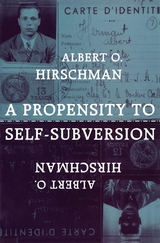 A Propensity to Self-Subversion
Albert O. Hirschman
Harvard University Press, 1995 Albert O. Hirschman is renowned worldwide for theories that have been at the forefront of political economics during the last half century. In these twenty essays he casts his sharp analytical eye on his own ideas, questioning and qualifying some of his major propositions on social change and economic development. Hirschman's self-subversion, as well as the self-affirmation that is also present here, reveal the workings of a distinguished mind. They also bring us fresh perspective on the material in his twelve previous books and countless essays.In the substantial essays that open this collection, Hirschman reappraises points he made in such books as Exit, Voice, and Loyalty, The Strategy of Economic Development, and The Rhetoric of Reaction. Subsequent essays fruitfully reexplore the themes of Latin American development and market society that have occupied him throughout his career. Hirschman also forays into new puzzles, such as the likely impact, negative or otherwise, of the Eastern European revolutions of 1989 on the Third World, the on-and-off connections between political and economic progress, and the role of conflict in enhancing community spirit in a liberal democracy.
In a rare and particularly welcome section of the book, Hirschman presents autobiographical fragments that reflect his deep involvement in some of the important events of this century. He recollects his flight from Hitler's Germany in 1933, his studies in Paris, his work with the antifascist underground in Italy in 1937-38, and his role in helping Varian Fry in Marseilles, in 1940, to rescue political and intellectual refugees from Vichy France. Such accounts deepen our understanding of how Hirschman's penetrating insights took shape.
 The Proper Edge of the Sky: High Plateau Country of Utah
Edward A Geary
University of Utah Press, 1992 Edward Geary’s collection of writings on the High Plateau country of central and southern Utah, a combination guidebook, travel narrative, personal essays, and natural, social, and literary history, encompasses each of those forms with a sweep as broad as the landscape it describes. It traces the progress of travelers to the region, including the historic Dominguez-Escalante party in 1776, and trappers and explorers such as Jedediah Smith, John C. Freemont, and Kit Carson. Scandinavian and English descendants of the early Mormon pioneers, sent to settle Manti and surrounding areas by Brigham Young in 1849, populate many of the pages and dominate the agrarian villages described by the author. The book also describes the multiethnic society of French Basque, Greeks, Slavs, Italians, Chinese, Welsh, and Finnish laborers and coal miners that developed in the region. Geary writes of all these people with affection and a deep sense of place, of belonging to a distinctive landscape and its history. It is a book that will bring a rush of understanding to those who have lived in the High Plateaus and greater depth of appreciation to visitors.
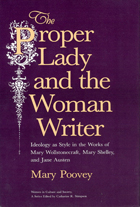 The Proper Lady and the Woman Writer: Ideology as Style in the Works of Mary Wollstonecraft, Mary Shelley, and Jane Austen
Mary Poovey
University of Chicago Press, 1984 "A brilliant, original, and powerful book. . . . This is the most skillful integration of feminism and Marxist literary criticism that I know of." So writes critic Stephen Greenblatt about The Proper Lady and the Woman Writer, Mary Poovey's study of the struggle of three prominent writers to accommodate the artist's genius to the late eighteenth- and early nineteenth-century ideal of the modest, self-effacing "proper lady." Interpreting novels, letters, journals, and political tracts in the context of cultural strictures, Poovey makes an important contribution to English social and literary history and to feminist theory.
"The proper lady was a handy concept for a developing bourgeois patriarchy, since it deprived women of worldly power, relegating them to a sanctified domestic sphere that, in complex ways, nourished and sustained the harsh 'real' world of men. With care and subtle intelligence, Poovey examines this 'guardian and nemesis of the female self' through the ways it is implicated in the style and strategies of three very different writers."—Rachel M. Brownstein, The Nation
"The Proper Lady and the Woman Writer is a model of . . . creative discovery, providing a well-researched, illuminating history of women writers at the turn of the nineteenth century. [Poovey] creates sociologically and psychologically persuasive accounts of the writers: Wollstonecraft, who could never fully transcend the ideology of propriety she attacked; Shelley, who gradually assumed a mask of feminine propriety in her social and literary styles; and Austen, who was neither as critical of propriety as Wollstonecraft nor as accepting as Shelley ultimately became."—Deborah Kaplan, Novel
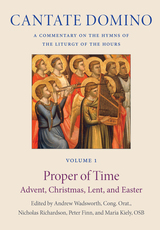 The Proper of Time: Advent, Christmas, Lent, and Easter, Volume 1
Andrew Wadsworth
Catholic University of America Press, 2024 Cantate Domino is a five-volume commentary on the texts of the newly translated hymns of the Liturgy of the Hours. The hymns which recently appeared for the first time as a single corpus of English texts, will be included in the forthcoming USCCB revised edition of the Liturgy of the Hours. The hymns are drawn from among the very finest authors of the first millennium: Ambrose, Prudentius, and Gregory the Great together with later authors such as Thomas Aquinas, Leo XIII, and twentieth century authors who composed new hymns to be used in the psalter and celebration of the saints in the present Universal Calendar. The commentary concentrates on the Latin texts of the Liturgia Horarum, elucidated by the recently approved International Commission on English in the Liturgy (ICEL) translations. Commentaries have been prepared by a team of international scholars who bring both the depth of their knowledge together with the insights of those who have prepared liturgical texts in English during the sixty years of ICEL's existence. Previously unpublished material from ICEL's archives, including documents of the Consilium, which prepared the Latin texts for the liturgical books promulgated after the Second Vatican Council, will appear alongside commentaries which identify and explain biblical, classical, and liturgical allusions in the liturgical texts in a way that is of service to clergy, religious, liturgists, and students of the liturgy as well as the non-specialist reader, and all who seek to pray the Prayer of the Church with greater understanding.
 The Proper Way to Educate the Deaf: A Modern Annotated Translation
The Abbé Charles-Michel de l’Epée
Gallaudet University Press, 2024 This volume presents the first complete English translation of the Abbé de l’Épée’s seminal work describing his methodology for educating deaf children. Originally published in French in 1798, this modern annotated edition offers readers a translation that is documentary in scope and that reflects historic attitudes toward deaf people and deaf education while maintaining the conventions of contemporary English.
De l’Épée provides an anecdotal account of his methods and philosophy for educating deaf children using a sign system based on the French Sign Language of the era but adapted to visually represent the linguistic features of spoken and written French. His work laid the foundation for the use of the “manual method,” or sign language, in deaf education. One section of the text, originally published in Latin, outlines the intellectual clash between de l’Épée and Samuel Heinicke, an early proponent of oral education who contested the use of sign language.
De l’Épée’s text holds significant cultural and historical value for the fields of deaf studies and deaf education. This English language translation reveals de l’Épée’s own story of how he came to be known as the “father of the deaf” and is enriched by scholarly contributions that provide essential historical context and a framework for modern understanding.
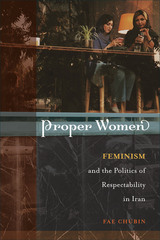 Proper Women: Feminism and the Politics of Respectability in Iran
Fae Chubin
Temple University Press, 2024 Proper Women tells the unprecedented story of an NGO-led “women’s empowerment” program in Tehran that was created to serve young, impoverished Iranians and Afghan refugees. Fae Chubin recounts the well-intentioned efforts of cosmopolitan NGO administrators whose loyalty to liberal feminist principles of individualism, sexual autonomy, and anti-traditionalism complicated their objective of empowering marginalized women.
Chubin brings attention to the varying class, ethnic, religious, and national identities of NGO staff and clients that shaped their differing understandings of oppression and justice. Her examination of the tensions within the organization reveals why the efforts of the NGO workers failed to gain purchase among the intended beneficiaries.
Proper Women concludes by encouraging feminist activists to not only examine the role of local politics and transnational connections in shaping their definitions of empowerment, but also consider the advantages of a justice-enhancing practice as opposed to justice monism for their target populations.
The Proper Words for Sin
Gary Fincke
West Virginia University Press, 2013 Coal burns underground and destroys a small town. A woman confronts police officers with her pet copperheads. A young girl drinks Drano. A man is banned from his favorite bar. Within these eleven short stories, Flannery O’Connor Award winner and poet Gary Fincke brings into focus the small struggles of ordinary people. The characters within this collection, from boys and girls to fathers, mothers, and the aging, live in cities, in towns, and in rural areas. Yet, no matter the surroundings, all seem alone within a collective anxiety. Set against extraordinary events, such as the Three Mile Island accident, the Challenger Disaster, and the Kennedy assassination, these stories personalize history through a juxtaposition between large and small tragedies and the unflinching desire to find insight within and redemption from weakness and shortcoming.
Properties of Modernity: Romantic Spain, Modern Europe, and the Legacies of Empire
Michael Iarocci
Vanderbilt University Press, 2006 Michael Iarocci traces the ways in which Spain went from being central to European history and identity during the early modern period to being marginalized and displaced by England, France, and Germany during the Romantic period. He points out that it has long been an unspoken assumption tainting much of literary criticism that Spain did not have a strong Romantic movement even though Spain itself had come to be viewed by the "new" Europe as the location of all that was romantic.
Through a close study of Cadalso, Saavedra, and Larra, Iarocci argues that Spanish writers were intensely concerned with the same issues taken up by more famous Romantics and that the ways in which they address these issues provides us with a richer notion, not only of Spain, but of all of Europe.
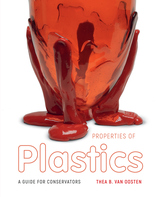 Properties of Plastics: A Guide for Conservators
Thea B. van Oosten
J. Paul Getty Trust, The, 2022 A practical, comprehensive resource on the complex behaviors of plastics written expressly for conservation and cultural heritage professionals.
Almost every museum in the world is confronted with plastics in their collections. Research initiatives and knowledge concerning the conservation of heritage objects made of plastics have proliferated over the last twenty-five years, necessitating this up-to-date, comprehensive resource. Intended as a highly practical guide for the conservation community, this authoritative book offers information essential to understanding plastics, polymers, and rubber/elastomers and their behaviors in the cultural heritage context. Numerous graphs, diagrams, and illustrations allow readers to compare the mechanical, physical, thermal, and optical properties of these substances during conservation. Aimed at the hands-on museum practitioner, this book will assist professionals in choosing the appropriate methods and materials for preserving and treating plastic objects.
Complementing the main chapters, fifty-six illustrated “fact sheets” summarize, at a glance, the properties of those plastics most commonly found in museum collections. Six informative case studies present real-world examples of current conservation approaches to works of art and design made of plastics and rubber/elastomers. Under the expert authorship of Thea B. van Oosten, conservation scientist, educator, and internationally regarded authority on the behavior and properties of plastics, this instructive volume is destined to become an invaluable resource for the field.
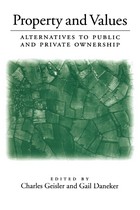 Property and Values: Alternatives To Public And Private Ownership
Edited by Charles Geisler and Gail Daneker
Island Press, 2000 Property and Values offers a fresh look at property rights issues, bringing together scholars, attorneys, government officials, community development practitioners, and environmental advocates to consider new and more socially equitable forms of ownership. Based on a Harvard Law School conference organized by the Equity Trust, Inc., in cooperation with the American Bar Association's Commission on Homelessness and Poverty, the book: - explains ownership as an evolving concept, determined by social processes and changing social relations
- challenges conventional public-private ownership categories
- surveys recent studies on the implications of public policy on property values
- offers examples from other cultures of ownership realities unfamiliar or forgotten in the United States
- compares experiments in ownership/equity allocation affecting social welfare and environmental conservation
The book synthesizes much innovative thinking on ownership in land and housing, and signals how that thinking might be used across America. Contributors – including David Abromowitz, Darby Bradley, Teresa Duclos, Sally Fairfax, Margaret Grossman, C. Ford Runge, William Singer and others – call for balance between property rights and responsibilities, between private and public rights in property, and between individual and societal interests in land. Property and Values is a thought-provoking contribution to the literature on property for planners, lawyers, government officials, resource economists, environmental managers, and social scientists as well as for students of planning, environmental law, geography, or public policy.
Property Control and Social Strategies in Settlers in a Middle Eastern Plain
Barbara C. Aswad
University of Michigan Press, 1971 In this work, anthropologist Barbara C. Aswad presents an analysis of social organization and land control of a Middle Eastern tribal society that has become sedentarized, with particular focus on kinship and marriage and other strategies of mobility. Aswad did her research in villages of the Al Shiukh tribe in southern Turkey along the Syrian border in 1964 and 1965.
Property, Power, and Authority in Rus and Latin Europe, ca. 1000–1236
Yulia Mikhailova
Arc Humanities Press, 2018 This book intertwines two themes in medieval studies hitherto kept apart: comparisons of Latin and Orthodox Europe and the "feudal revolution" of the late- and post-Carolingian periods. The book broadens the debate by comparing texts written in "learned" and "vulgar" Latin, Church Slavonic, Anglo-Norman, and East Slavonic. From this comparison, the Kingdom of the Rus appears as a regional variation of European society. This suggests current interpretations overemphasize factors unique to the medieval West and overlook deeper pan-European processes.
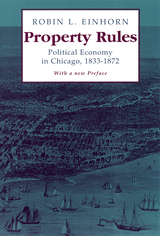 Property Rules: Political Economy in Chicago, 1833-1872
Robin L. Einhorn
University of Chicago Press, 1991 In Property Rules, Robin L. Einhorn uses City Council records-previously thought destroyed-and census data to track the course of city government in Chicago, providing an important reinterpretation of the relationship between political and social structures in the nineteenth-century American city.
A Choice "Outstanding Academic Book"
"[A] masterful study of policy-making in Chicago."—Choice
"[A] major contribution to urban and political history. . . . [A]n excellent book."—Jeffrey S. Adler, American Historical Review
"[A]n enlightening trip. . . . Einhorn's foray helps make sense out of the transition from Jacksonian to Gilded Age politics on the local level. . . . [She] has staked out new ground that others would do well to explore."—Arnold R. Hirsch, American Journal of Legal History
"A well-documented and informative classic on urban politics."—Daniel W. Kwong, Law Books in Review
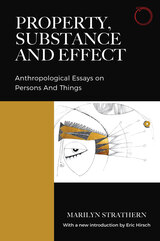 Property, Substance, and Effect: Anthropological Essays on Persons and Things
Marilyn Strathern
HAU, 2022 In engaging essays, celebrated anthropologist Marilyn Strathern reflects on the complexities of social life.
Property, Substance, and Effect draws on Marilyn Strathern’s longstanding interest in the reification of social relations. If the world is shrinking in terms of resources and access to them, it is expanding in terms of new candidates for proprietorship. How new relations are brought into being is among the many questions about property, ownership, and knowledge that these essays bring together.
Twenty years have not diminished the interest in the book’s opening challenge: if one were inventing a method of enquiry by which to configure the complexity of social life, one might wish to invent something like the anthropologist’s ethnographic practice. A wide range of studies deliberately brings into conversation claims people make on one another through relations imagined in the form of body-substance along with the increasing visibility of conceptual or intellectual work as property. Whether one lives in Papua New Guinea or Great Britain, categories of knowledge are being dissolved and reformed at a tempo that calls for reflection—and for the kind of lateral reflection afforded through the “ethnographic effect.”
Prophecy And Canon: Theology
Joseph Blenkinsopp
University of Notre Dame Press, 1986 Winner of the National Religious Book Award.
"Joseph Blenkinsopp dives head on into the question. He portrays the prophets in a very authentic role of interpreting earlier laws and traditions so that these continue to be normative and unifying guides amid new problems and possibilites."-The Bible Today
"Joseph Blenkinsopp dives head on into the question. He portrays the prophets in a very authentic role of interpreting earlier laws and traditions so that these continue to be normative and unifying guides amid new problems and possibilities."-The Bible Today
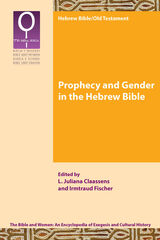 Prophecy and Gender in the Hebrew Bible
L. Juliana Claassens
SBL Press, 2021 Multifaceted insights into female life in prophetic contexts
Both prophets and prophetesses shared God’s divine will with the people of Israel, yet the voices of these women were often forgotten due to later prohibitions against women teaching in public. This latest volume of the Bible and Women series focuses on the intersection of gender and prophecy in the Former Prophets (Joshua to 2 Kings) as well as in the Latter Prophets of the Hebrew Bible. Essays examine how women appear in the iconography of the ancient world, the historical background of the phenomenon of prophecy, political and religious resistance by women in the biblical text, and gender symbolism and constructions in prophetic material as well as the metaphorical discourse of God. Contributors Michaela Bauks, Athalya Brenner-Idan, Ora Brison, L. Juliana Claassens, Marta García Fernández, Irmtraud Fischer, Maria Häusl, Rainer Kessler, Nancy C. Lee, Hanne Løland Levinson, Christl M. Maier, Ilse Müllner, Martti Nissinen, Ombretta Pettigiani, Ruth Poser, Benedetta Rossi, Silvia Schroer, and Omer Sergi draw insight into the texts from a range of innovative gender-oriented approaches.
The Prophecy and Other Stories
Drago Jancar
Northwestern University Press, 2009 These newly collected short stories reveal a master at the top of his game. Drago Jancar possesses an acute understanding of the human psyche, enabling his stories to resonate beyond their particular milieu. This collection features seven pieces, drawn from four different collections, that together present the struggle of individuals against powerful forces. The characters try to make sense of a world of shifting borders and changing names that make the idea of a "homeland"—either literal or figurative—a dream rather than a reality.
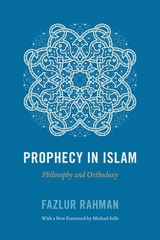 Prophecy in Islam: Philosophy and Orthodoxy
Fazlur Rahman
University of Chicago Press, 2011 This longstanding and highly regarded volume is the first to explore the doctrine of prophetic revelation, a critical and definitive area of Islamic religious and political thought. In it, the esteemed Islamic scholar Fazlur Rahman traces the inception of this doctrine from ancient Greek texts, its interpretation and elaboration by Muslim philosophers in order to suit their vision of the Prophet, and, finally, the varying degrees of acceptance of these convergent ideas by the Muslim orthodoxy.
The latest edition of this classic text includes a new foreword by Islamic studies expert Michael Sells, confirming Prophecy in Islam as the best source on its subject after more than half a century. This longstanding and highly regarded volume is the first to explore the doctrine of prophetic revelation, a critical and definitive area of Islamic religious and political thought. In it, the esteemed Islamic scholar Fazlur Rahman traces the inception of this doctrine from ancient Greek texts, its interpretation and elaboration by Muslim philosophers in order to suit their vision of the Prophet, and, finally, the varying degrees of acceptance of these convergent ideas by the Muslim orthodoxy.
The latest edition of this classic text includes a new foreword by Islamic studies expert Michael Sells, confirming Prophecy in Islam as the best source on its subject after more than half a century.
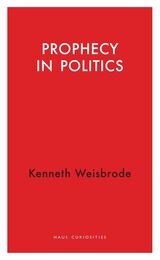 Prophecy in Politics
Kenneth Weisbrode
Haus Publishing, 2026 A selection of case studies on prophecy, belief, and political strategic thought.
Ralph Wigram was a minor British bureaucrat who is known to a small part of posterity only because Winston Churchill paid tribute to him as the man who warned of the Nazi threat with such persistence, conviction, and hard evidence that Churchill had the wherewithal to make the case to the British people. Wigram died at the end of 1936, just before the war he warned against had begun. He might have changed the course of history—if only people had believed him.
Prophets like Wigram are a permanent fixture of a world without certainty. Oracles, shamans, wiseacres, astrologers, and swamis of all shades populate our myths, legends, and Bibles. Today, our lives are inundated with the wisdom of professional forecasters, intelligence analysts, and threat mongers. Why do many of us, and especially our leaders, find it so difficult to heed warnings? We tend to underreact to some, overreact to others, and then point fingers when what “nobody ever anticipated” comes to pass. Why is prophecy so dogged?
Prophecy in Politics takes up a vast, complex, and well-worn subject—the future—and reduces it to its most essential aspects, especially belief. It revisits a half-dozen familiar and not-so-familiar incidents of prophecy, from the warnings given to Stalin about Operation Barbarossa to those given to Bill Clinton and George W. Bush about “terrorism,” to the Cassandras periodically promising collapse in the financial markets, to uncover a pattern of complacency and neglect. Finally, Ken Weisbrode proposes what all of us might do to overcome complacency and make prophecy work better for us. This is not a handbook or an attempt to stand in the vanguard of political or strategic thought on futurism, futures studies, or futurology; rather, it is a concise overview and an idiosyncratic but nevertheless useful guide to thinking about the past and present condition of prophecy.
The Prophecy of Enoch as Restoration Blueprint
Terryl Givens
Utah State University Press, 2013
Volume 18, The Leonard J. Arrington Lecture Series
The Special Collections and Archives of Utah State University's Merrill-Cazier Library houses the personal and historical collection of Leonard J. Arrington, renowned scholar of the American West.
The Leonard J. Arrington Mormon History Lecture annually hosts the presentation of current research by a leading scholar. Among the lecturers have been such notable historians as Thomas G. Alexander, Richard L. Bushman, Sarah Barringer Gordon, Howard Lamar, Jan Shipps, Donald Worster, and Pulitzer Prize-winner Laurel Thatcher Ulrich.
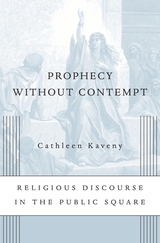 Prophecy without Contempt: Religious Discourse in the Public Square
Cathleen Kaveny
Harvard University Press, 2016 American culture warriors have plenty to argue about, but battles over such issues as abortion and torture have as much to do with rhetorical style as moral substance. Cathleen Kaveny reframes the debate about religion in the public square by focusing on a powerful stream of religious discourse in American political speech: the Biblical rhetoric of prophetic indictment.
“Important and path-breaking. The place of religious discourse in the American public square has received much attention for many years, but the role of prophetic indictment has been largely overlooked. Kaveny’s book not only opens a ‘new front’ in these debates, but starts the conversation with a rich analysis of the history and function of prophetic discourse.”
—Kathleen A. Brady, Commonweal
“A monumental achievement, and a much-needed addition to the academic and societal conversation about the role of religion in public life. In precise prose and with careful analysis, Kaveny challenges some of the leading theorists about public discourse and puts forward her own theories, all accompanied by a storyteller’s gift for anecdote and a philosopher’s talent for explication.”
—Michael Sean Winters, National Catholic Reporter
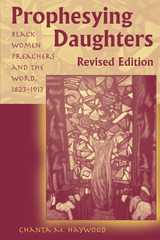 Prophesying Daughters: Black Women Preachers and the Word, 1823-1913
Chanta M. Haywood
University of Missouri Press, 2003 In nineteenth-century America, many black women left their homes, their husbands, and their children to spread the Word of God. Descendants of slaves or former “slave girls” themselves, they traveled all over the country, even abroad, preaching to audiences composed of various races, denominations, sexes, and classes, offering their own interpretations of the Bible. When they were denied the pulpit because of their sex, they preached in tents, bush clearings, meeting halls, private homes, and other spaces. They dealt with domestic ideologies that positioned them as subservient in the home, and with racist ideologies that positioned them as naturally inferior to whites. They also faced legalities restricting blacks socially and physically and the socioeconomic reality of often being part of a large body of unskilled laborers. Jarena Lee, Julia Foote, Maria Stewart, and Frances Gaudet were four women preachers who endured such hardships because of their religious convictions. Often quoting from the scripture, they insisted that they were indeed prophesying daughters whom God called upon to preach. Significantly, many of these women preachers wrote autobiographies in which they present images of assertive, progressive, pious women—steadfast and unmovable in their religious beliefs and bold in voicing their concerns about the moral standing of their race and society at large. Chanta M. Haywood examines these autobiographies to provide new insight into the nature of prophesying, offering an alternative approach to literature with strong religious imagery. She analyzes how these four women employed rhetorical and political devices in their narratives, using religious discourse to deconstruct race, class, and gender issues of the nineteenth century. By exploring how religious beliefs become an avenue for creating alternative ideologies, Prophesying Daughters will appeal to students and scholars of African American literature, women’s studies, and religious studies.
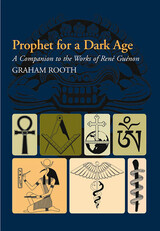 Prophet for a Dark Age: A Companion to the Works of René Guénon
Graham Rooth
Sussex Academic Press, 2022 Provides comprehensive coverage of the key concepts employed by Gunon and interprets the less familiar terms from Sanskrit, Hebrew and Arabic. The text makes extensive use of extracts from Gunon's original work.Graham Rooth is the translator of the bestsellingThe Light of Zen in the West;, incorporatingThe Supreme Doctrine;andThe Realization of the Self;, by Hubert Benoit.Ren Gunon is a major figure for anyone who recognizes a need to rediscover the spiritual roots from which Western society has become so comprehensively alienated. Immersing himself in the search for spiritual truth, he chose Islam as the vehicle for his spiritual life. Settling in Egypt, he clarified and deepened our understanding of the teachings of traditional metaphysics, his central message being that there is at the source of all humanity's traditions a 'Primordial Tradition' a Universal Metaphysics which sets out the principles that underlie this Tradition. The truths it embodies are universal and unchanging, and form part of a unified body of higher knowledge which transcends the multiplicity of religious dogmas and philosophical systems that abound in Western society. He wrote about the need to transcend the formal and emotional aspect of religion in order to prepare ourselves for an understanding of 'pure metaphysics'. He explained how traditional societies achieved this, exploring the symbols used, in order to help individuals forward to levels of understanding which are otherwise inaccessible to minds blinkered by the limitations of the currently prevailing Western approach to existence and its meaning. This book provides an overview of Gunon's work. It is arranged in four parts each of which provides extracts that express his views directly and commentaries that summarize or paraphrase his written work. The objective is to allow Gunon to speak for himself rather than produce a critique of his ideas.Part One, Religion and the Primordial Tradition, explores Gunon's ideas about the nature of the primordial Tradition or 'Perennial Philosophy' and the part it would play in a traditional society. It sets out his views on the major religions and how they are related to the primordial Tradition. There are sections on the monotheistic religions and the oriental religions. The largest section deals with Vedantic Hinduism, reflecting the dominant and enduring role that this played in the development of Gunon's ideas.Part Two, The Spiritual Journey and the Integral Being, focuses on the quest for enlightenment and the means of achieving it, with an emphasis on the role of initiation and transmission. It examines the difference between 'realization' and salvation. It explores the spiritual quest in the light of Gunon's theory of the integral being and its multiple states, which postulates that the human state is one aspect only of innumerable different states comprising the totality of a single being.Part Three, Western Society and the Growth of Modernity, presents Gunon's critique of contemporary Western society in terms of its historical development and current worldview. It highlights the spiritual dangers that confront the West and examines the processes and attitudes symptomatic of its spiritual decline. It provides an overview of Gunon's ideas about subjects ranging across the sciences, the humanities, philosophy and psychology. The section on philosophy draws together many of Gunon's ideas about the nature of manifestation and ultimate reality.Part Four, Symbolism, explores the significance Gunon attached to the history and meaning of the symbols shared by all the great traditions. It summarizes his thoughts on the nature of symbolism, how it achieves its effects and its particular significance to the spiritual life. Many examples are provided from the natural world, the animal kingdom and human activities, demonstrating the important part played by symbols in all cultures, and the common features they share, suggesting the possibility that many of the more important ones point to an ancient, common origin.
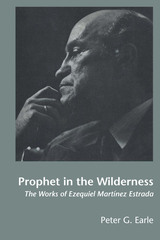 Prophet in the Wilderness: The Works of Ezequiel Martínez Estrada
By Peter G. Earle
University of Texas Press, 1971 A universal test of great writers is the quality of their response to the human dilemma. Prophet in the Wilderness traces the development of that response in the works of the Argentine writer Ezequiel Martínez Estrada, from the first ambitious poems to its definitive expression in the essays and short stories. His theme is progressive disillusionment, in history and in personal experience, both of which are interpreted in his work as accumulations of error. Modern civilization, he believes, has created many more problems than it has solved. Like Schopenhauer, Freud, and Spengler, the three thinkers who influenced him most, Martínez Estrada found in real events and circumstances all the symbols of disenchantment. Many today have begun to share this disenchantment, for since the publication of X-Ray of the Pampa in 1933 the real world has become more and more like his symbolic world. Prophet in the Wilderness examines Martínez Estrada's foremost concern: the world as a complex reality to be discovered behind the image of one's own most intimate community. For him, the community assumed many forms: Buenos Aires, the enigmatic metropolis; the cathedral in his story "The Deluge"; the innumerable family of Marta Riquelme; Argentina itself in his masterpiece, X-Ray of the Pampa. Martínez Estrada is the great solitary of Hispanic American literature, independent of all fashions and trends. With Borges, he had become by 1950 one of the two most discussed writers in Argentina.
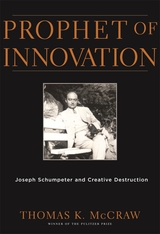 Prophet of Innovation: Joseph Schumpeter and Creative Destruction
Thomas K. McCraw
Harvard University Press, 2010 Pan Am, Gimbel’s, Pullman, Douglas Aircraft, Digital Equipment Corporation, British Leyland—all once as strong as dinosaurs, all now just as extinct. Destruction of businesses, fortunes, products, and careers is the price of progress toward a better material life. No one understood this bedrock economic principle better than Joseph A. Schumpeter. “Creative destruction,” he said, is the driving force of capitalism.
Described by John Kenneth Galbraith as “the most sophisticated conservative” of the twentieth century, Schumpeter made his mark as the prophet of incessant change. His vision was stark: Nearly all businesses fail, victims of innovation by their competitors. Businesspeople ignore this lesson at their peril—to survive, they must be entrepreneurial and think strategically. Yet in Schumpeter’s view, the general prosperity produced by the “capitalist engine” far outweighs the wreckage it leaves behind.
During a tumultuous life spanning two world wars, the Great Depression, and the early Cold War, Schumpeter reinvented himself many times. From boy wonder in turn-of-the-century Vienna to captivating Harvard professor, he was stalked by tragedy and haunted by the specter of his rival, John Maynard Keynes. By 1983—the centennial of the birth of both men—Forbes christened Schumpeter, not Keynes, the best navigator through the turbulent seas of globalization. Time has proved that assessment accurate.
Prophet of Innovation is also the private story of a man rescued repeatedly by women who loved him and put his well-being above their own. Without them, he would likely have perished, so fierce were the conflicts between his reason and his emotions. Drawing on all of Schumpeter’s writings, including many intimate diaries and letters never before used, this biography paints the full portrait of a magnetic figure who aspired to become the world’s greatest economist, lover, and horseman—and admitted to failure only with the horses.
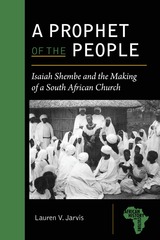 A Prophet of the People: Isaiah Shembe and the Making of a South African Church
Lauren V. Jarvis
Michigan State University Press, 2024 In 1910 Isaiah Shembe was struggling. He had left his family and quit his job as a sanitation worker to become a Baptist evangelist, but he ended his first mission without much to show. Little did he know that he would soon establish the Nazaretha Church as he began to attract attention from people left behind by industrial capitalism in South Africa. By his death in 1935, Shembe was an internationally known prophet and healer, described by his peers as “better off than all the Black people.” In A Prophet of the People: Isaiah Shembe and the Making of a South African Church, historian Lauren V. Jarvis provides a fascinating and intimate portrait of one of South Africa’s most famous religious figures, and in turn the making of modern South Africa. Following Shembe from his birth in the 1860s across many environments and contexts, Jarvis illuminates the tight links between the spread of Christianity, strategies of evasion, and the capacious forms of community that continue to shape South Africa today.
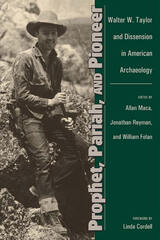 Prophet, Pariah, and Pioneer: Walter W. Taylor and Dissension in American Archaeology
Allan Maca
University Press of Colorado, 2010 "This is a fascinating book about a complex person...Taylor is claimed by the contributors to this new book as ancestor to both processual and postprocessual archaeologies...It thus remains possible to read him in different ways, as is well brought out by the diverse contributions to this volume, which is the first to provide a thorough and informed account that contextualizes Taylor's work and habilitates him within later and contemporary currents in archaeology...Throughout Prophet, Pariah, and Pioneer and especially at the end, the twists and turns, the refractions never stop...The editors are to be congratulated for not trying to tidy him up..." -Ian Hodder, Current Anthropology
In his 1948 work A Study of Archaeology, recently minted Harvard Ph.D. Walter W. Taylor delivered the strongest and most substantial critique of American archaeology ever published. He created many enemies with his dissection of the research programs of America’s leading scholars, who took it as a personal affront. Taylor subsequently saw his ideas co-opted, his research pushed to the margins, and his students punished. Publicly humiliated at the 1985 Society for American Archaeology meeting, he suffered ridicule until his death in 1997. Nearly everyone in the archaeological community read Taylor’s book at the time, and despite the negative reaction, many were influenced by it. Few young scholars dared to directly engage and build on his “conjunctive approach,” yet his suggested methods nevertheless began to be adopted and countless present-day authors highlight his impact on the 1960s formation of the “New Archaeology.” In Prophet, Pariah, and Pioneer, peers, colleagues, and former students offer a critical consideration of Taylor’s influence and legacy. Neither a festschrift nor a mere analysis of his work, the book presents an array of voices exploring Taylor and his influence, sociologically and intellectually, as well as the culture of American archaeology in the second half of the twentieth century.
The Prophetess and the Patriarch: The Visions of an Anti-Regicide in Seventeenth-Century England
Elizabeth Poole
Iter Press, 2023 Published for the first time in full, a common woman’s writings reveal the startling role she played in England’s revolt against the monarchy.
In 1649, a seamstress named Elizabeth Poole appeared at the Whitehall debates in London to prophesy in front of Parliament’s army shortly after it had defeated the crown in the English civil wars. Invited to help deliberate the fate of Charles I, Poole advised the army to spare the king’s life but to put him on trial for tyranny and to enter into a new compact with the people. After her visions proved controversial, she was defamed as a prostitute and a witch. She retaliated by printing her prophecies, along with two new defenses of her original revelations. This collection publishes Poole’s pamphlets in full for the first time.
 Prophetic and Public: The Social Witness of U.S. Catholicism
Kristin E. Heyer
Georgetown University Press, 2006 The United States was founded on a commitment to religious tolerance. Based on this commitment, it has become one of the most religiously diverse and religiously observant liberal democracies in the world. Inherent in this political reality is the question, "What is the appropriate relationship between religious beliefs and public life?" This is not a new question, but in contemporary US politics it has become a particularly insistent one. In this intelligent, wide-ranging book, Kristin Heyer provides new and nuanced answers. Prophetic and Public employs the discourse of public theology to consider what constitutes appropriate religio-political engagement. According to Heyer, public theology connects religious faith, concepts, and practices to their public relevance for the wider society. Her use of public theology concepts to address the appropriate possibilities and limits for religio-political engagement in the United States is both useful and enlightening. Heyer approaches the relationship between public morality and religious commitment through the example of the Catholic Church. She looks at two prominent Catholics—Michael Baxter and Bryan Hehir—as a way of discussing norms for practice of public theology. Heyer also analyzes case studies of three US Catholic advocacy groups: The US Conference of Catholic Bishops, NETWORK, and Pax Christi USA. Through her analysis she shows the various ways that the organizations' Catholic identity impacts their social and political efforts. From her investigations come norms that define possibilities and limits for political actions based on religious conviction. This deeply thoughtful book examines what is truly fundamental and inescapable about public life and private religious belief in the United States. In doing so, it makes skillful use of the tools of theology, philosophy, law, and advocacy to demonstrate that the Catholic Church reveals great diversity in its public theology, providing legitimate options for a faithful response to urgent political issues.
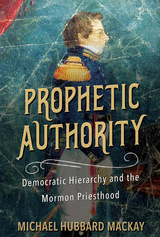 Prophetic Authority: Democratic Hierarchy and the Mormon Priesthood
Michael Hubbard MacKay
University of Illinois Press, 2020 The Mormon tradition's emphasis on prophetic authority makes the Church of Jesus Christ of Latter-day Saints unique within America's religious culture. The religion that Joseph Smith created established a kingdom of God in a land distrustful of monarchy while positioning Smith as Christ's voice on earth, with the power to form cities, establish economies, and arrange governments. Michael Hubbard MacKay traces the Church of Jesus Christ of Latter-day Saints' claim to religious authority and sets it within the context of its times. Delving into the evolution of the concept of prophetic authority, MacKay shows how the Church emerged as a hierarchical democracy with power diffused among leaders Smith chose. At the same time, Smith's settled place atop the hierarchy granted him an authority that spared early Mormonism the internal conflict that doomed other religious movements. Though Smith faced challenges from other leaders, the nascent Church repeatedly turned to him to decide civic plans and define the order of both the cosmos and the priesthood.
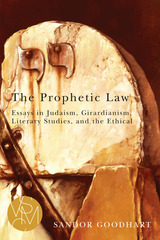 The Prophetic Law: Essays in Judaism, Girardianism, Literary Studies, and the Ethical
Sandor Goodhart
Michigan State University Press, 2014 To read literature is to read the way literature reads. René Girard’s immense body of work supports this thesis bountifully. Whether engaging the European novel, ancient Greek tragedy, Shakespeare’s plays, or Jewish and Christian scripture, Girard teaches us to read prophetically, not by offering a method he has developed, but by presenting the methodologies they have developed, the interpretative readings already available within (and constitutive of) such bodies of classical writing. In The Prophetic Law, literary scholar, theorist, and critic Sandor Goodhart divides his essays on René Girard since 1983 into four groupings. In three, he addresses Girardian concerns with Biblical scripture (Genesis and Exodus), literature (the European novel and Shakespeare), and philosophy and religious studies issues (especially ethical and Jewish subject matters). In a fourth section, he reproduces some of the polemical exchanges in which he has participated with others—including René Girard himself—as part of what could justly be deemed Jewish-Christian dialogue. The twelve texts that make up the heart of this captivating volume constitute the bulk of the author’s writings to date on Girard outside of his three previous books on Girardian topics. Taken together, they offer a comprehensive engagement with Girard’s sharpest and most original literary, anthropological, and scriptural insights.
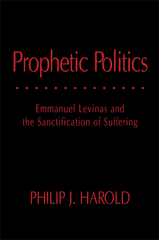 Prophetic Politics: Emmanuel Levinas and the Sanctification of Suffering
Philip J. Harold
Ohio University Press, 2009 In Prophetic Politics, Philip J. Harold offers an original interpretation of the political dimension of Emmanuel Levinas’s thought. Harold argues that Levinas’s mature position in Otherwise Than Being breaks radically with the dialogical inclinations of his earlier Totality and Infinity and that transformation manifests itself most clearly in the peculiar nature of Levinas’s relationship to politics. Levinas’s philosophy is concerned not with the ethical per se, in either its applied or its transcendent forms, but with the source of ethics. Once this source is revealed to be an anarchic interruption of our efforts to think the ethical, Levinas’s political claims cannot be read as straightforward ideological positions or principles for political action. They are instead to be understood “prophetically,” a position that Harold finds comparable to the communitarian critique of liberalism offered by such writers as Alasdair MacIntyre and Charles Taylor. In developing this interpretation, which runs counter to formative influences from the phenomenological tradition, Harold traces Levinas’s debt to phenomenological descriptions of such experiences as empathy and playfulness. Prophetic Politics will highlight the relevance of the phenomenological tradition to contemporary ethical and political thought—a long-standing goal of the series—while also making a significant and original contribution to Levinas scholarship.
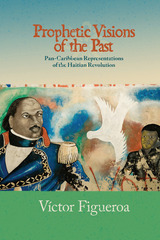 Prophetic Visions of the Past: Pan-Caribbean Representations of the Haitian Revolution
Víctor Figueroa
Ohio State University Press, 2015 In Prophetic Visions of the Past: Pan-Caribbean Representations of the Haitian Revolution, Víctor Figueroa examines how the Haitian Revolution has been represented in twentieth-century literary works from across the Caribbean. Building on the scholarship of key thinkers of the Latin American “decolonial turn” such as Enrique Dussel, Aníbal Quijano, Walter Mignolo, and Nelson Maldonado-Torres, Figueroa argues that examining how Haiti’s neighbors tell the story of the Revolution illuminates its role as a fundamental turning point in both the development and radical questioning of the modern/colonial world system.
Prophetic Visions of the Past includes chapters on literary texts from a wide array of languages, histories, and perspectives. Figueroa addresses work by Alejo Carpentier (Cuba), C. L. R. James (Trinidad), Luis Palés Matos (Puerto Rico), Aimé Césaire (Martinique), Derek Walcott (Saint Lucia), Edouard Glissant (Martinique), and Manuel Zapata Olivella (Colombia). While underscoring each writer’s unique position, Figueroa also addresses their shared geographical, historical, and sociopolitical preoccupations, which are closely linked to the region’s prolonged experience of colonial interventions. Ultimately, these analyses probe how, for the larger Caribbean region, the Haitian Revolution continues to reflect the tension between inspiring revolutionary hopes and an awareness of ongoing colonial objectification and exploitation.
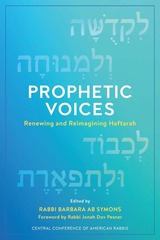 Prophetic Voices: Renewing and Reimagining Haftarah
Rabbi Barbara AB Symons
Central Conference of American Rabbis, 2023 The traditional haftarah cycle, read on Shabbat and holidays during the Torah service, contains a wealth of prophetic wisdom, yet today it is too often forgotten or ignored. Prophetic Voices gives new life to these ancient texts. A diverse group of contributors--including rabbis, cantors, scholars, educators, activists, and poets--provide short commentaries on each haftarah, demonstrating their profound relevance to the present. Moreover, the volume boldly invites us to rethink the haftarah canon. Going beyond the Prophets, it presents alternative readings from Jewish texts biblical to contemporary. New haftarot for each Shabbat and holiday are included, plus haftarot for the Jewish American calendar, from Yom HaShoah to Pride Month to Martin Luther King Jr. Day. The readings are enhanced by scholarly essays placing the Prophets in historical context and examining the role of prophecy in Reform Judaism. Prophetic Voices summons us to listen, study, think, and teach--as well as to sing, pray, and march.
 Prophets and Emperors: Human and Divine Authority from Augustus to Theodosius
David Potter
Harvard University Press, 1994 To the practical modern mind, the idea of divine prophecy is more ludicrous than sublime. Yet to our cultural forebears in ancient Greece and Rome, prophecy was anything but marginal; it was in fact the basic medium for recalling significant past events and expressing hopes for the future, and it offered assurance that divinities truly cared about mere mortals. Prophecy also served political ends, and it was often invoked to support or condemn an emperor's actions. In Prophets and Emperors, David Potter shows us how prophecy worked, how it could empower, and how the diverse inhabitants of the Roman Empire used it to make sense of their world.
This is a fascinating account of prophecy as a social, religious, and political phenomenon. The various systems of prophecy--including sacred books, oracles, astrological readings, interpretation of dreams, the sayings of holy men and women--come into sharp relief. Potter explores the use of prophecy as a nieans of historical analysis and political communication, and he describes it in the context of the ancient city. Finally, he traces the reformation of the prophetic tradition under the influence of Christianity in the fourth century.
Drawing on diverse evidence--from inscriptions and ancient prophetic books to Greek and Roman historians and the Bible--Potter has produced a study that will engage anyone interested in the religions of the ancient Mediterranean and in the history and politics of the Roman Empire.
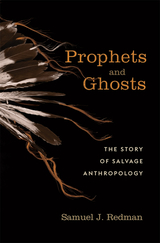 Prophets and Ghosts: The Story of Salvage Anthropology
Samuel J. Redman
Harvard University Press, 2021 A searching account of nineteenth-century salvage anthropology, an effort to preserve the culture of “vanishing” Indigenous peoples through dispossession of the very communities it was meant to protect.
In the late nineteenth century, anthropologists, linguists, archaeologists, and other chroniclers began amassing Indigenous cultural objects—crafts, clothing, images, song recordings—by the millions. Convinced that Indigenous peoples were doomed to disappear, collectors donated these objects to museums and universities that would preserve and exhibit them. Samuel Redman dives into the archive to understand what the collectors deemed the tradition of the “vanishing Indian” and what we can learn from the complex legacy of salvage anthropology.
The salvage catalog betrays a vision of Native cultures clouded by racist assumptions—a vision that had lasting consequences. The collecting practice became an engine of the American museum and significantly shaped public education and preservation, as well as popular ideas about Indigenous cultures. Prophets and Ghosts teases out the moral challenges inherent in the salvage project. Preservationists successfully maintained an important human inheritance, sometimes through collaboration with Indigenous people, but collectors’ methods also included outright theft. The resulting portrait of Indigenous culture reinforced the public’s confidence in the hierarchies of superiority and inferiority invented by “scientific” racism.
Today the same salvaged objects are sources of invaluable knowledge for researchers and museum visitors. But the question of what should be done with such collections is nonetheless urgent. Redman interviews Indigenous artists and curators, who offer fresh perspectives on the history and impact of cultural salvage, pointing to new ideas on how we might contend with a challenging inheritance.
 Prophets and Patrons: The French University and the Emergence of the Social Sciences
Terry Nichols Clark
Harvard University Press, 1973 Prophets and Patrons is the first detailed account of the emergence of sociology and related social sciences in France. It emphasizes three social and intellectual groupings in the period from 1880 to 1914: the social statisticians who grew out of governmental ministries, the Durkheimians who were consistently housed in the university, and the "international sociologists" around René Worms, in neither ministries nor the university.
Unlike most histories of ideas, Prophets and Patrons portrays the institutional developments that encouraged, discouraged, and rechanneled different styles of research. To understand these developments, a sociological analysis of the French university system is presented. At its center are the patrons (generally Sorbonne professors) who served as informal linkages for the entire system. Around them developed clusters of researchers and teachers throughout France. The workings of this system of relations, analyzed here for the first time, are crucial to understanding the French university.
The university is also immersed in the political and ideological currents of the Latin Quarter. Thus Clark's investigation of conflicting elements of French culture and social structure helps illuminate his analysis of the university. This study will be invaluable to social scientists, intellectual historians, and students of French culture and comparative education.
Prophets and Prophecy in the Ancient Near East
Martti Nissinen
SBL Press, 2019 A new, expanded edition of a classic reference tool
This volume of more than 170 documents of prophecy from the ancient Near East brings together a representative sample of written documents from Mesopotamia, the Levant, and Egypt dating to the second and first millennia BCE. Nissinen's collection provides nonspecialist readers clear translations, transliterations, and discussions of oracles reports and collections, quotations of prophetic messages in letters and literature, and texts that reference persons with prophetic titles. This second edition includes thirty-four new texts.
Features:
- Modern, idiomatic, and readable English translations
- Thirty-four new translations
- Contributions of West Semitic, Egyptian, and Luwian sources from C. L. Seow, Robert K. Ritner, and H. Craig Melchert
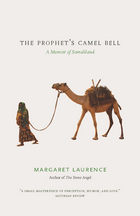 The Prophet's Camel Bell: A Memoir of Somaliland
Margaret Laurence
University of Chicago Press, 1963
In 1950, as a young bride, Margaret Laurence set out with her engineer husband to what was then Somaliland: a British protectorate in North Africa few Canadians had ever heard of. Her account of this voyage into the desert is full of wit and astonishment. Laurence honestly portrays the difficulty of colonial relationships and the frustration of trying to get along with Somalis who had no reason to trust outsiders. There are moments of surprise and discovery when Laurence exclaims at the beauty of a flock of birds only to discover that they are locusts, or offers medical help to impoverished neighbors only to be confronted with how little she can help them. During her stay, Laurence moves past misunderstanding the Somalis and comes to admire memorable individuals: a storyteller, a poet, a camel-herder. The Prophet’s Camel Bell is both a fascinating account of Somali culture and British colonial characters, and a lyrical description of life in the desert.
 Prophets Facing Backward: Postmodern Critiques of Science and Hindu Nationalism in India
Nanda, Meera
Rutgers University Press, 2003 The leading voices in science studies have argued that modern science reflects dominant social interests of Western society. Following this logic, postmodern scholars have urged postcolonial societies to develop their own “alternative sciences” as a step towards “mental decolonization”. These ideas have found a warm welcome among Hindu nationalists who came to power in India in the early 1990s. In this passionate and highly original study, Indian-born author Meera Nanda reveals how these well-meaning but ultimately misguided ideas are enabling Hindu ideologues to propagate religious myths in the guise of science and secularism. At the heart of Hindu supremacist ideology, Nanda argues, lies a postmodernist assumption: that each society has its own norms of reasonableness, logic, rules of evidence, and conception of truth, and that there is no non-arbitrary, culture-independent way to choose among these alternatives. What is being celebrated as “difference” by postmodernists, however, has more often than not been the source of mental bondage and authoritarianism in non-Western cultures. The “Vedic sciences” currently endorsed in Indian schools, colleges, and the mass media promotes the same elements of orthodox Hinduism that have for centuries deprived the vast majority of Indian people of their full humanity.
By denouncing science and secularization, the left was unwittingly contributing to what Nanda calls “reactionary modernism.” In contrast, Nanda points to the Dalit, or untouchable, movement as a true example of an “alternative science” that has embraced reason and modern science to challenge traditional notions of hierarchy.
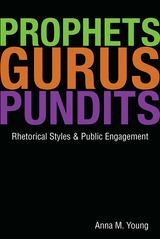 Prophets, Gurus, and Pundits: Rhetorical Styles and Public Engagement
Anna M. Young
Southern Illinois University Press, 2014 In Prophets, Gurus, and Pundits, author Anna M. Young proposes that the difficulty of bridging the gap between intellectuals and the public is not a failure of ideas; rather, it is an issue of rhetorical strategy. By laying a rhetorical foundation and presenting analytical case studies of contemporary “public intellectuals,” Young creates a training manual for intellectuals who seek to connect with a public audience and effect change writ large.
Young begins by defining key aspects of rhetorical style before moving on to discuss the specific ways in which intellectuals may present ideas to a general audience in order to tackle large-scale social problems. Next, she defines the ways in which five crucial turning points in our nation—the rise of religious fundamentalism, a growing lack of trust in our institutions, the continued destruction of the environment, the ubiquity of media and information in our daily lives, and the decline of evidence-based reasoning—have set the stage for opportunities in the current public-intellectual dialogue.
Via case studies of such well-known personalities as Deepak Chopra and Professor Cornel West, Young goes on to reveal the six types of public intellectuals who achieve success in presenting scholarly ideas to audiences at large:
The Prophet presents the public’s sins for contemplation, then offers a path to redemption.
The Guru shepherds his or her flock to enlightenment and a higher power.
The Sustainer draws upon our natural and human resources to proffer solutions for social, political, and ecological systems.
The Pundit utilizes wit and brevity to bring crucial issues to the attention of the public.
The Narrator combines a variety of perspectives to create a story the average person can connect with and understand.
The Scientist taps into the dreams of the public to offer ideas from above and beyond the typical scope of public discourse.
At once a rallying cry and roadmap, The Politics of Thinking Out Loud draws upon rhetorical expertise and analysis of contemporary public intellectuals to offer a model for scholars to effectively engage the public—and in doing so, perhaps forever change the world in which we live.
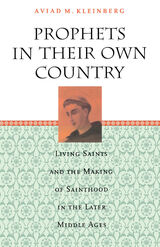 Prophets in Their Own Country: Living Saints and the Making of Sainthood in the Later Middle Ages
Aviad M. Kleinberg
University of Chicago Press, 1992 In this original study of the making of saintly reputations, Aviad M. Kleinberg shows how sainthood, though frequently seen as a personal trait, is actually the product of negotiations between particular individuals and their communities. Employing the methods of history, anthropology, and textual criticism, Kleinberg examines the mechanics of sainthood in daily interactions between putative saints and their audiences. This book will interest historians, anthropologists, sociologists, medievalists, and those interested in the study of religion.
"[A] fascinating and sometimes iconoclastic view of saints in the medieval period." —Sandra R. O'Neal, Theological Studies
"[An] important new book. . . . [And] an excellent piece of scholarship." —Diane L. Mockridge, Method & Theory in the Study of Religion
"[Kleinberg's] style is clear and accessible and his observations insightful; the book is a pleasure to read." —Veronica Lawrence, Theological Book Review
"Original and interesting. . . . [Kleinberg] has made a major contribution." —Anne L. Clark, American Historical Review
"Kleinberg's concern is not just with perceptions of sanctity, but, refreshingly, with what actually happened: and he is especially good on the conflict of the two. . . . [This] is not just a book but a way of thought, and one that promises interesting conversations at all levels from the church porch to the tutorial and the academic conference." —Helen Cooper, Times Literary Supplement
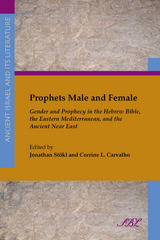 Prophets Male and Female: Gender and Prophecy in the Hebrew Bible, the Eastern Mediterranean, and the
Jonathan Stökl
SBL Press, 2013 Because gender is an essential component of societies of all times and places, it is no surprise that every prophetic expression in the ancient social world was a gendered one. In this volume scholars of the biblical literature and of the ancient Mediterranean consider a wide array of prophetic phenomena. In addition to prophetic texts of the Hebrew Bible, the essays also look at prophecy in ancient Mesopotamia and early Christianity. Using the most current theoretical categories, the volume demonstrates how essential a broad definition of gender is for understanding its connection to both the delivery and the content of ancient prophecy. Attention to gender dynamics will continue to reveal the fluidity of prophetic gender performance and to open up the ancient contexts of prophetic texts. The contributors are Roland Boer, Corrine Carvalho, Lester L. Grabbe, Anselm C. Hagedorn, Esther J. Hamori, Dale Launderville, Antti Marjanen, Martti Nissinen, Jonathan Stökl, Hanna Tervanotko, and Ilona Zsolnay.
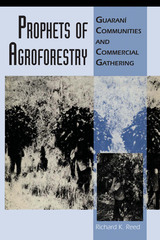 Prophets of Agroforestry: Guaraní Communities and Commercial Gathering
By Richard K. Reed
University of Texas Press, 1995 For almost four centuries, the indigenous Chiripá (Guaraní) people of eastern Paraguay have maintained themselves as a distinct society and culture, despite continual and often intense relations with Paraguayan society and the international economy. In this study, Richard K. Reed explores the economic and social basis for this ethnic autonomy. Reed finds that Chiripá economic power derives from their practice of commercial agroforestry. Unlike Latin American indigenous societies that have been forced to clear land for commercial agriculture, the Chiripá continue to harvest and sell forest products, such as caffeinated yerba mate, without destroying the forests. Reed also explores the relation of this complex economy to Chiripá social organization and shows how flexible kin ties allowed the Chiripá to adapt to the pressure and opportunities of the commercial economy without adopting the authoritarian nature of rural Paraguayan society. These findings offer important insights into the relations among indigenous groups, nation-states, and the international economy. They also provide a timely alternative model for sustainable management of subtropical forests that will be of interest in the fields of development and environmental studies.
Prophets of Regulation
Thomas K. McCraw
Harvard University Press, 1984 “There is properly no history, only biography,” Emerson remarked, and in this ingenious book Thomas McCraw unfolds the history of four powerful men: Charles Francis Adams, Louis D. Brandeis, James M. Landis, and Alfred E. Kahn. The absorbing stories he tells make this a book that will appeal across a wide spectrum of academic disciplines and to all readers interested in history, biography, and Americana.
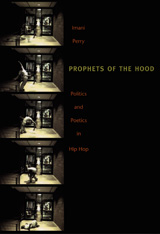 Prophets of the Hood: Politics and Poetics in Hip Hop
Imani Perry
Duke University Press, 2004 At once the most lucrative, popular, and culturally oppositional musical force in the United States, hip hop demands the kind of interpretation Imani Perry provides here: criticism engaged with this vibrant musical form on its own terms. A scholar and a fan, Perry considers the art, politics, and culture of hip hop through an analysis of song lyrics, the words of the prophets of the hood. Recognizing prevailing characterizations of hip hop as a transnational musical form, Perry advances a powerful argument that hip hop is first and foremost black American music. At the same time, she contends that many studies have shortchanged the aesthetic value of rap by attributing its form and content primarily to socioeconomic factors. Her innovative analysis revels in the artistry of hip hop, revealing it as an art of innovation, not deprivation. Perry offers detailed readings of the lyrics of many hip hop artists, including Ice Cube, Public Enemy, De La Soul, krs-One, OutKast, Sean “Puffy” Combs, Tupac Shakur, Lil’ Kim, Biggie Smalls, Nas, Method Man, and Lauryn Hill. She focuses on the cultural foundations of the music and on the form and narrative features of the songs—the call and response, the reliance on the break, the use of metaphor, and the recurring figures of the trickster and the outlaw. Perry also provides complex considerations of hip hop’s association with crime, violence, and misogyny. She shows that while its message may be disconcerting, rap often expresses brilliant insights about existence in a society mired in difficult racial and gender politics. Hip hop, she suggests, airs a much wider, more troubling range of black experience than was projected during the civil rights era. It provides a unique public space where the sacred and the profane impulses within African American culture unite.
Prophets, Poets and Scholars: The Collections of the Middle Eastern Library of Leiden University
Arnoud Vrolijk
Leiden University Press, 2024 Leiden University has an impressive collection of primary texts in various Middle Eastern languages such as Arabic, Persian, Turkish, Berber languages, Hebrew, and Ethiopian. These texts are contained in objects made of parchment, paper, and leather, which are often artistically shaped and ingeniously constructed. In addition, the university holds the written and printed records of 400 years of scholarly activity by Western orientalists. Currently, the Leiden University Library is the custodian of the largest Middle Eastern and Islamic cultural collection in the Netherlands, a unique position that is scarcely known to the public.
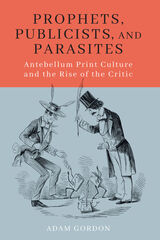 Prophets, Publicists, and Parasites: Antebellum Print Culture and the Rise of the Critic
Adam Gordon
University of Massachusetts Press, 2020 Print culture expanded significantly in the nineteenth century due to new print technologies and more efficient distribution methods, providing literary critics, who were alternately celebrated and reviled, with an ever-increasing number of venues to publish their work. Adam Gordon embraces the multiplicity of critique in the period from 1830 to 1860 by exploring the critical forms that emerged. Prophets, Publicists, and Parasites is organized around these sometimes chaotic and often generative forms and their most famous practitioners: Edgar Allan Poe and the magazine review; Ralph Waldo Emerson and the quarterly essay; Rufus Wilmot Griswold and the literary anthology; Margaret Fuller and the newspaper book review; and Frederick Douglass's editorial repurposing of criticism from other sources. Revealing the many and frequently competing uses of criticism beyond evaluation and aesthetics, this insightful study offers a new vision of antebellum criticism, a new model of critical history, and a powerful argument for the centrality of literary criticism to modern life.
The Prophets Speak on Forced Migration
Mark J. Boda
SBL Press, 2015 A valuable resource with productive avenues for inquiry
In this collection of essays dealing with the prophetic material in the Hebrew Bible, scholars explore the motifs, effects, and role of forced migration on prophetic literature. Contributors focus on the study of geographical displacement, social identity ethics, trauma studies, theological diversification, hermeneutical strategies in relation to the memory, and the effects of various exilic conditions in order to open new avenues of study into the history of Israelite religion and early Judaism.
Features:
- An introductory essay that presents a history of scholarship and an overview of the collection
- Ten essays examining the rhetoric of exile in the prophets
- Current, thorough approaches to the issues and problems related to historical and cultural features of exile in biblical literature
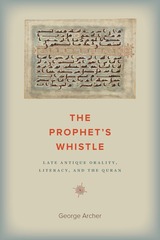 The Prophet's Whistle: Late Antique Orality, Literacy, and the Quran
George Archer
University of Iowa Press, 2024 The Quran is certainly one of the most important texts in human history. But it wasn’t originally a text at all. When the Quran appeared in the seventh century, it was a vocal recital performed by an unlettered man named Muhammad. It remains an oral performance for Muslims all over the world to this day.
The Prophet’s Whistle is a study of the ancient, nonliterary features of the Quran, many of which are often overlooked by historians and the public. George Archer corrects this striking absence by using observations from the anthropologies of living oral cultures, the cognitive sciences of literacy, and the study of other dead oral cultures. The Prophet’s Whistle shows that the thought systems of the Quran are oral, through and through, but by the end of the life of its Prophet, the Quran likewise hints at a personal and cultural embrace of writing and the mindsets of literate people.
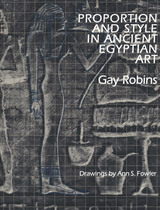 Proportion and Style in Ancient Egyptian Art
By Gay Robins
University of Texas Press, 1993 The painted and relief-cut walls of ancient Egyptian tombs and temples record an amazing continuity of customs and beliefs over nearly 3,000 years. Even the artistic style of the scenes seems unchanging, but this appearance is deceptive. In this work, Gay Robins offers convincing evidence, based on a study of Egyptian usage of grid systems and proportions, that innovation and stylistic variation played a significant role in ancient Egyptian art. Robins thoroughly explores the squared grid systems used by the ancient artists to proportion standing, sitting, and kneeling human figures. This investigation yields the first chronological account of proportional variations in male and female figures from the Early Dynastic to the Ptolemaic periods. Robins discusses in detail the proportional changes underlying the revolutionary style instituted during the Amarna Period. She also considers how the grid system influenced the composition of scenes as a whole. Numerous line drawings with superimposed grids illustrate the text.
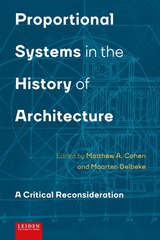 Proportional Systems in the History of Architecture: A Critical Consideration
Edited by Matthew A. Cohen and Maarten Delbeke
Leiden University Press, 2019 In this collection of original essays, twenty-five leading scholars reconsider the long history of proportional systems across numerous periods and places, and from diverse methodological approaches including archival exploration, advanced laser scanning, and more. Prior to the advent of modern structural engineering, architects and builders used proportional systems to imbue their works with a general condition of order that was integral to their intertwined notions of beauty and structural stability. These mostly invisible intellectual frameworks ranged from simple grids and symbolic numbers, to sly manipulations of geometry and numbers that required privileged knowledge and arithmetical calculations to access. Since the origins of architectural history, proportional systems have served as objects of belief and modes of iconographical communication. Whether they are capable of fulfilling more tangible functions remains a matter of debate today, for this ancient and diverse belief system continues to infiltrate architectural thinking in subtle and sometimes surprising ways.
Proportionalism: The American Debate and Its European Roots
Bernard Hoose
Georgetown University Press, 1987 One of the most heated debates in recent times among Christian ethicians has been over what has come to be called "proportionalism." Opponents have argued that proportionalists are intent on relativizing theology norms and theh concept of intrinsic evil. Proponents, on the other hand, argue that they are merely developing a traditional notion of proportion of reason. Bernard Hoose puts this debate in context by showing its roots in the writings of European moral theologians and its flowering in the writings of their American colleagues. He uncovers a number of confusions that have bedeviled the argument while revealing how important the issues are for establishing in coherent Christian ethics in the twentieth century.
 Proposals for a Caring Economy
Matthew J. Wolf-Meyer
University of Minnesota Press, 2025 Offering models of care beyond capitalist constraints
For too long, questions of care provision and inclusion have been shaped by economic justifications. This has led to the deprivation of care to individuals and communities based on capitalist assumptions about what and who can be cared for. Proposals for a Caring Economy takes these assumptions to task. Moving between examples focused on immigration and agriculture, patients and art audiences, green energy transitions and unhoused people, prison abolitionists and clients of domestic violence services, the contributors here argue that we need new ways to conceptualize care and its applications. Proposals for a Caring Economy articulates an economy that situates care at the forefront; sees the preservation of individual, community, and environmental wellbeing as the primary good; and focuses attention on building a sustainable economy of caring that will radically transform social connections and possibilities. Contributors: Chelsey R. Carter, Yale U; David McDermott Hughes, Rutgers U; Stephanie Delise Jones, U of California, Riverside; Sameena Mulla, Emory U; Katy Overstreet, Saxo Institute, U of Copenhagen; Michelle Parsons, Northern Arizona U; Adair Rounthwaite, U of Washington; Damien M. Sojoyner, U of California, Irvine; Emily Yates-Doerr, Oregon State U.
 Proposed: The University of the United States
Edgar Wesley
University of Minnesota Press, 1936 Proposed: The University of the United States was first published in 1936. Minnesota Archive Editions uses digital technology to make long-unavailable books once again accessible, and are published unaltered from the original University of Minnesota Press editions.In Proposed: The University of the United States, Edgar Bruce Wesley claims that a reduction in the number of bureaucrats and special advisers to the government, and fewer “blunders of national proportions,” would result from the establishment of a national university in Washington.Such a university would be devoted entirely to graduate and research work. Exchange professors and visiting scholars would contribute to its services. Students would pay no tuition fees since the institution, founded and directed by the federal government, would be supported by taxation. It would be empowered to grant the usual graduate degrees and much of its work would be in the training of promising young people for government service and in carrying on “a continuous and inclusive program of social research.”The establishment of a national university is not a new idea, as Professor Wesley explains, but one that has been proposed by numerous educators and statesmen, including ten presidents of the United States. This book relates the history of the idea, presents arguments in favor of the establishment of such an institution, outlines a plan for its organization, and presents a specific bill for enactment by Congress.
Propositional Attitudes: The Role of Content in Logic, Language, and Mind
Edited by C. Anthony Anderson and Joseph Owens
CSLI, 1990 These papers treat those issues involved in formulating a logic of propositional attitudes and consider the relevance of the attitudes to the continuing study of both the philosophy of language and the philosophy of mind. C. Anthony Anderson is professor of philosophy and Joseph Owens is assistant professor of philosophy, both at the University of Minnesota.
|
|

